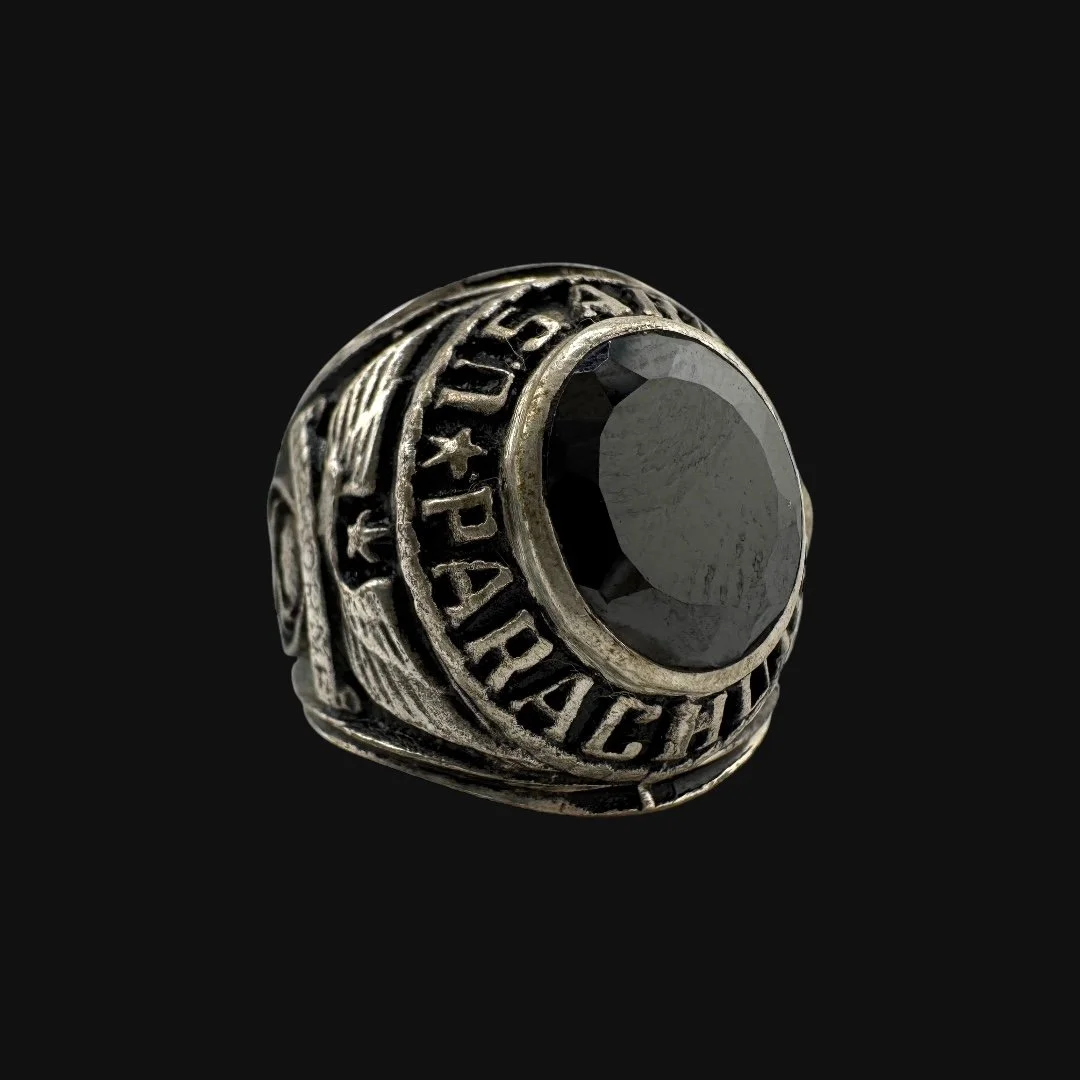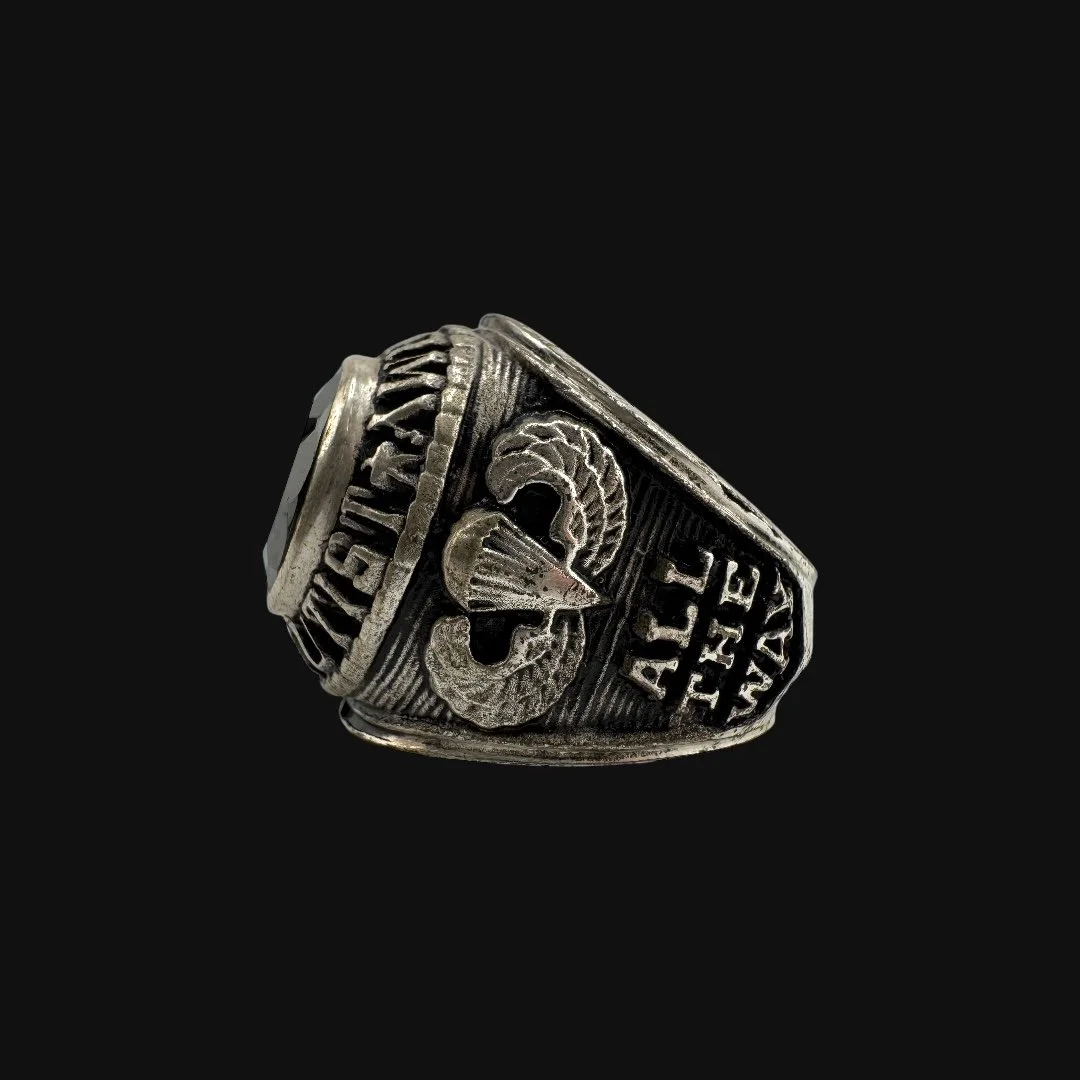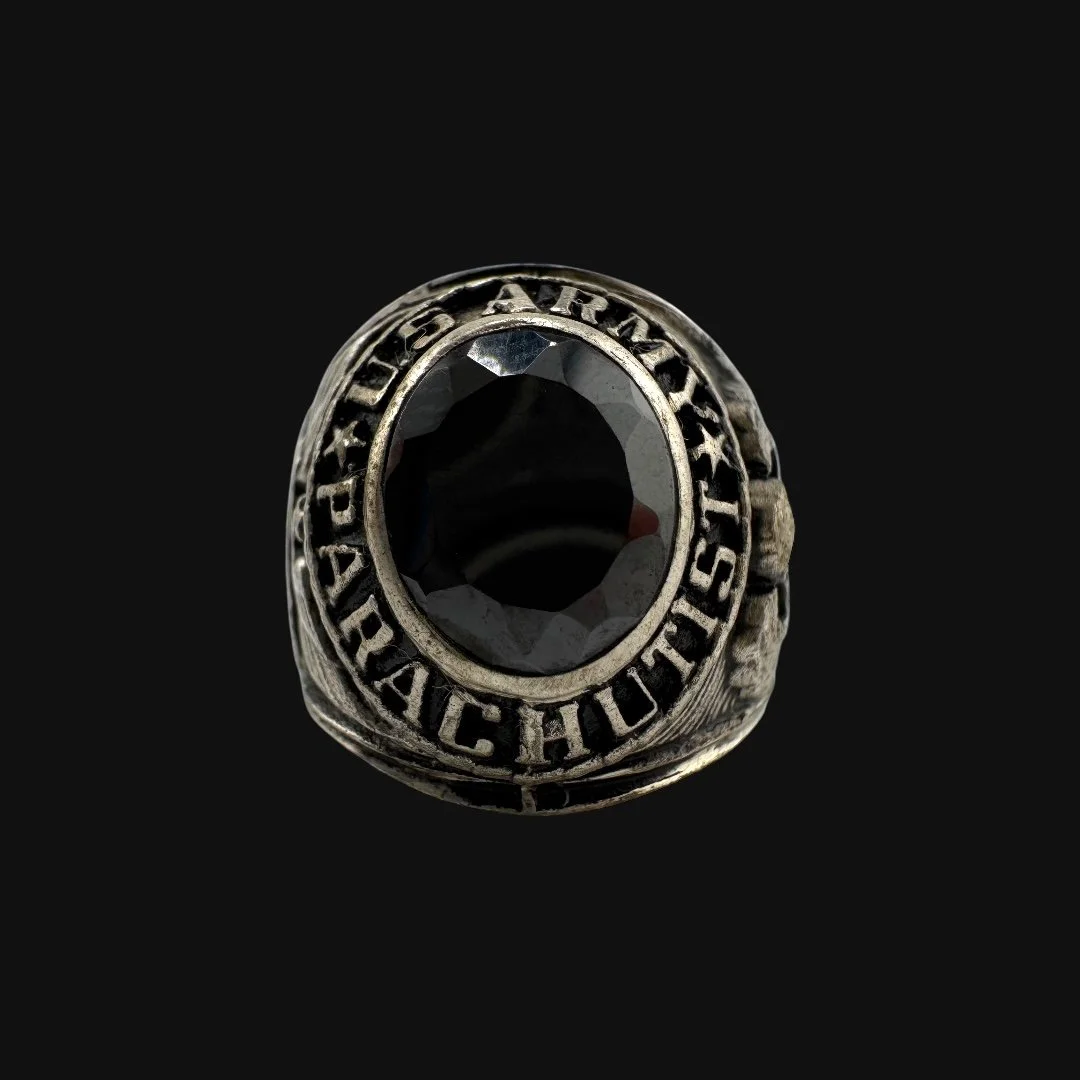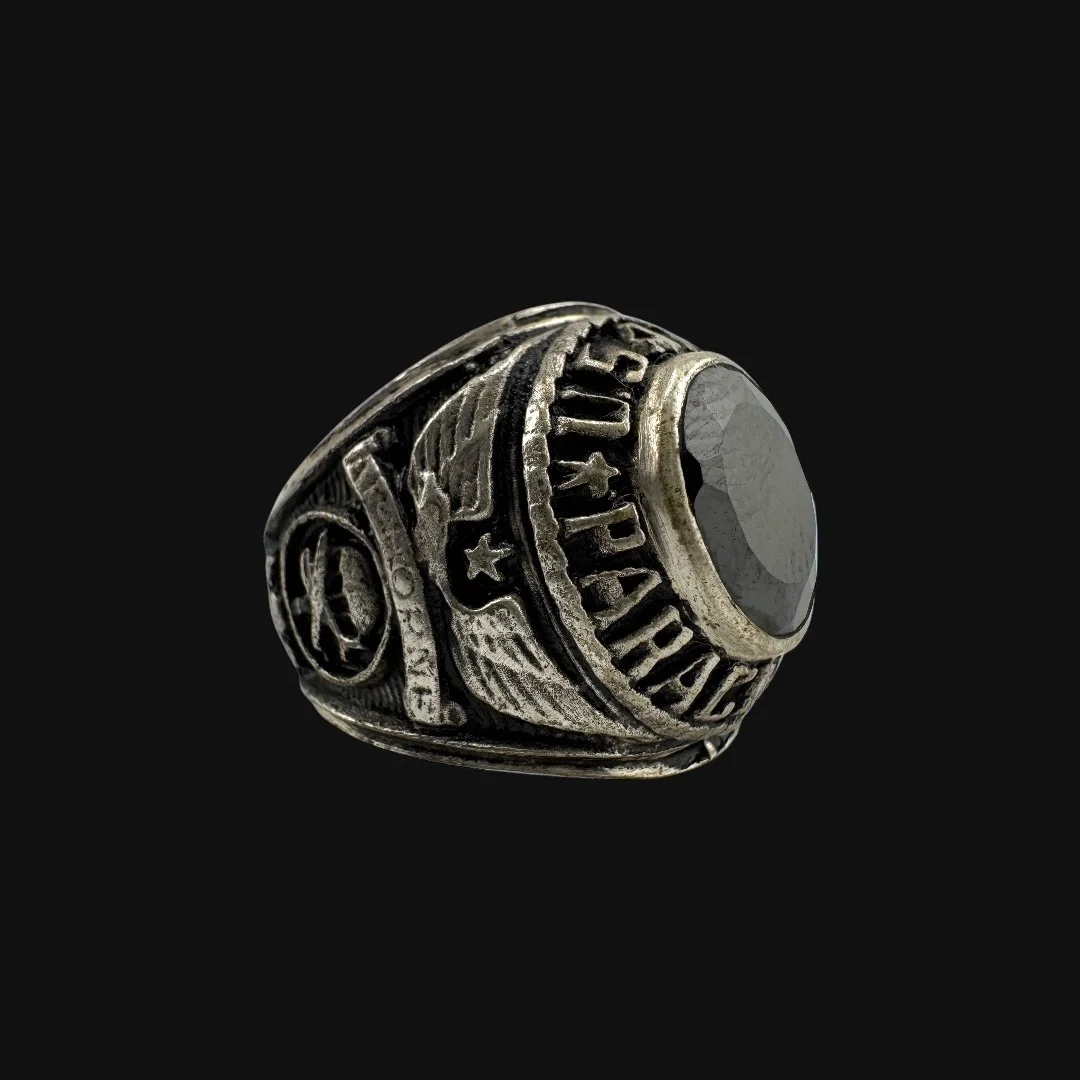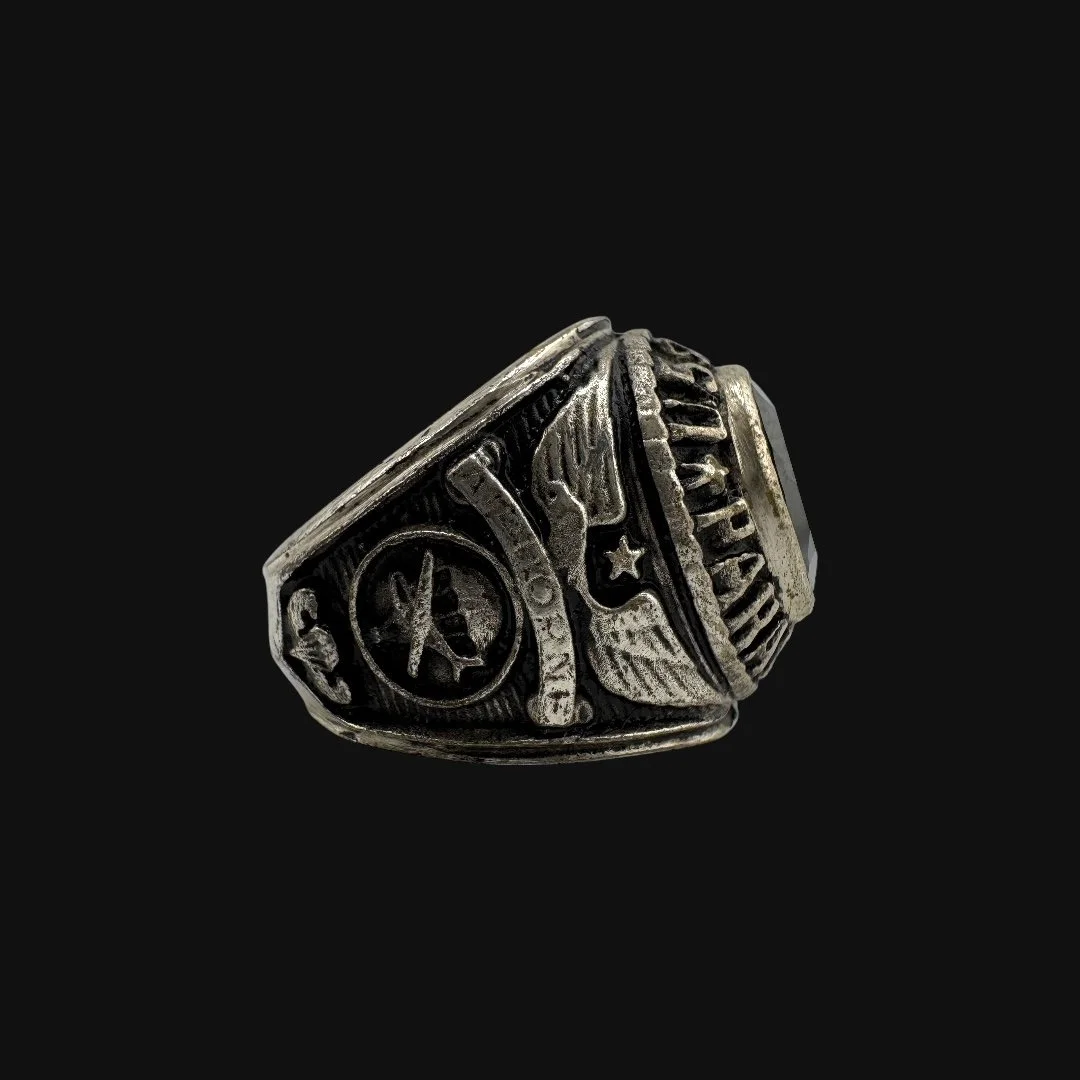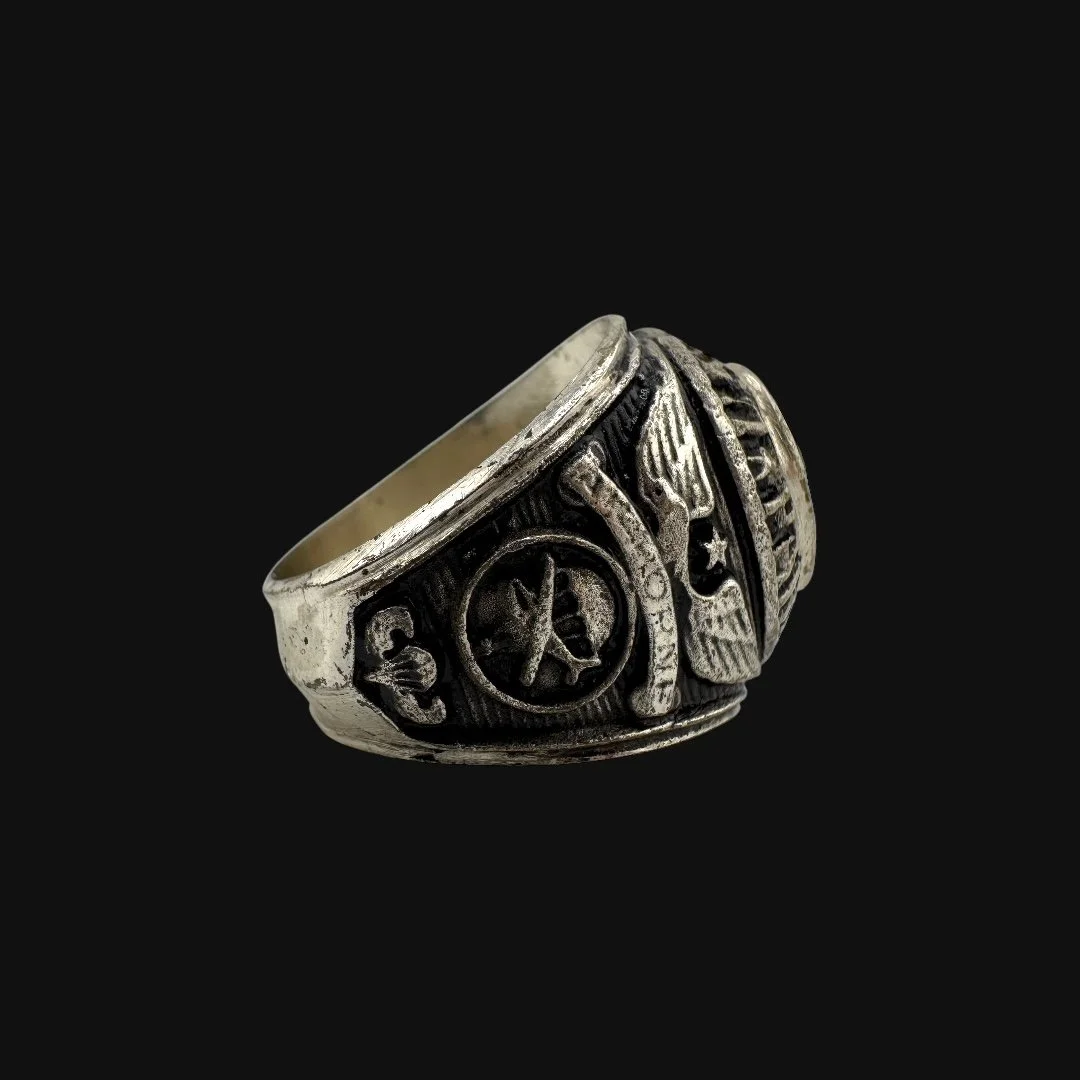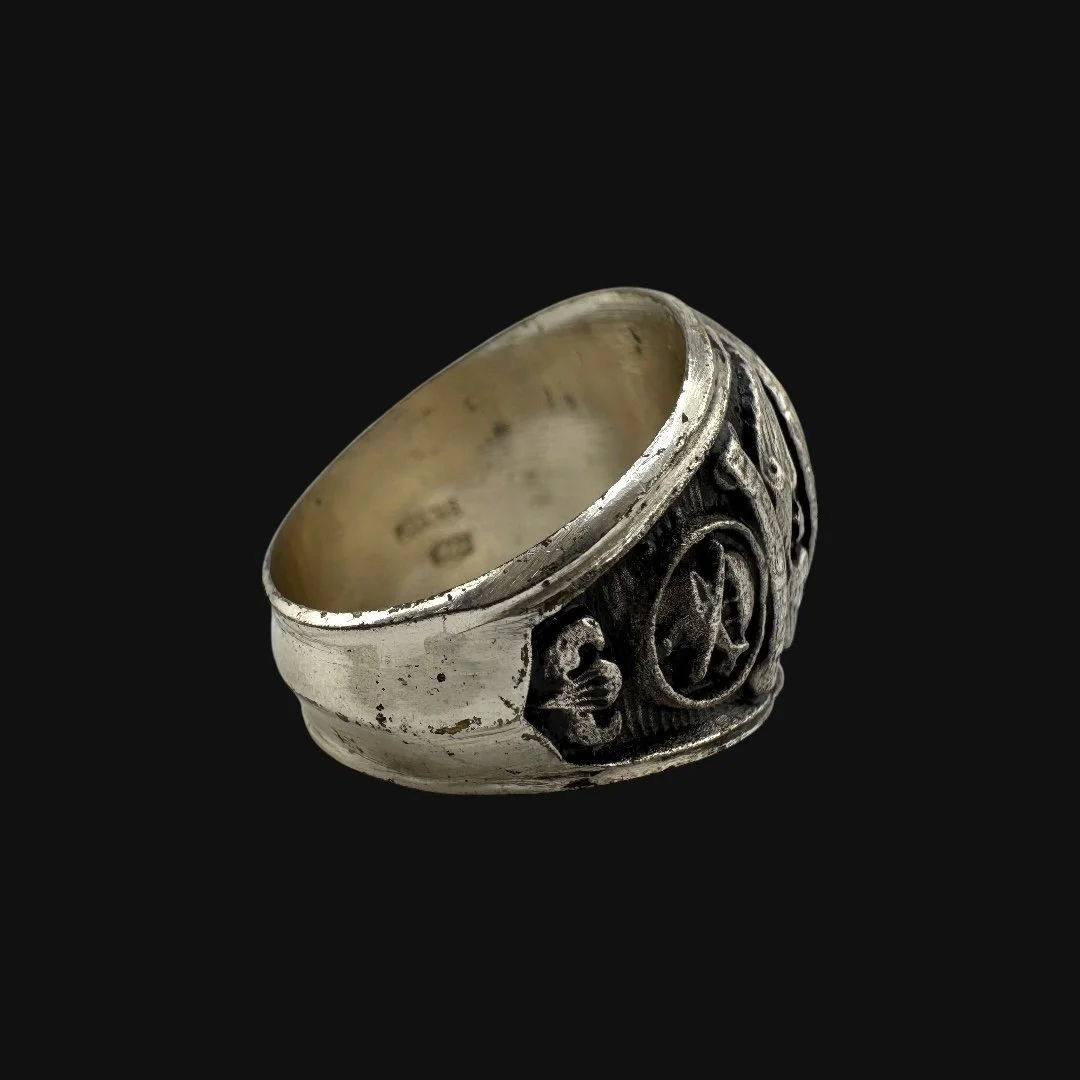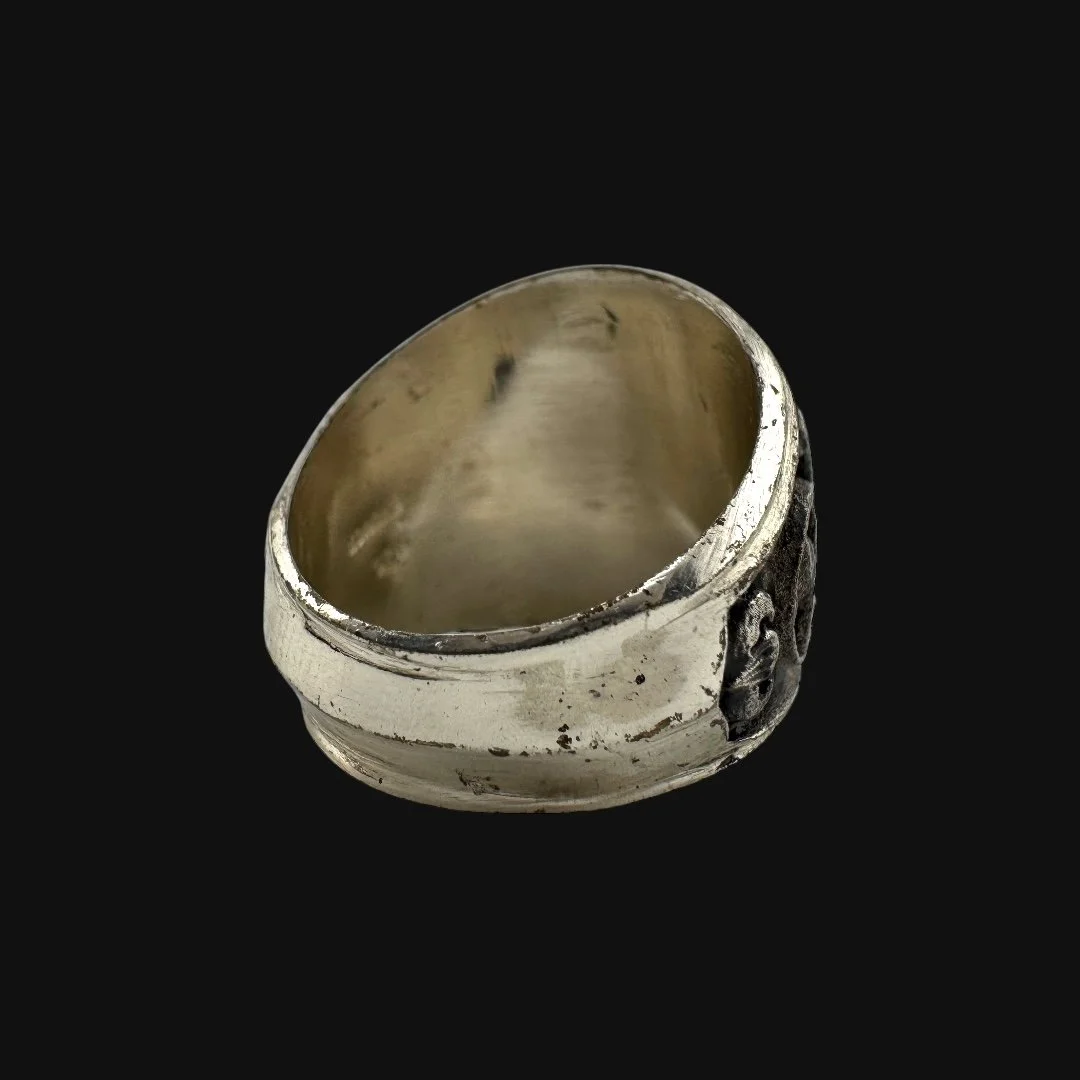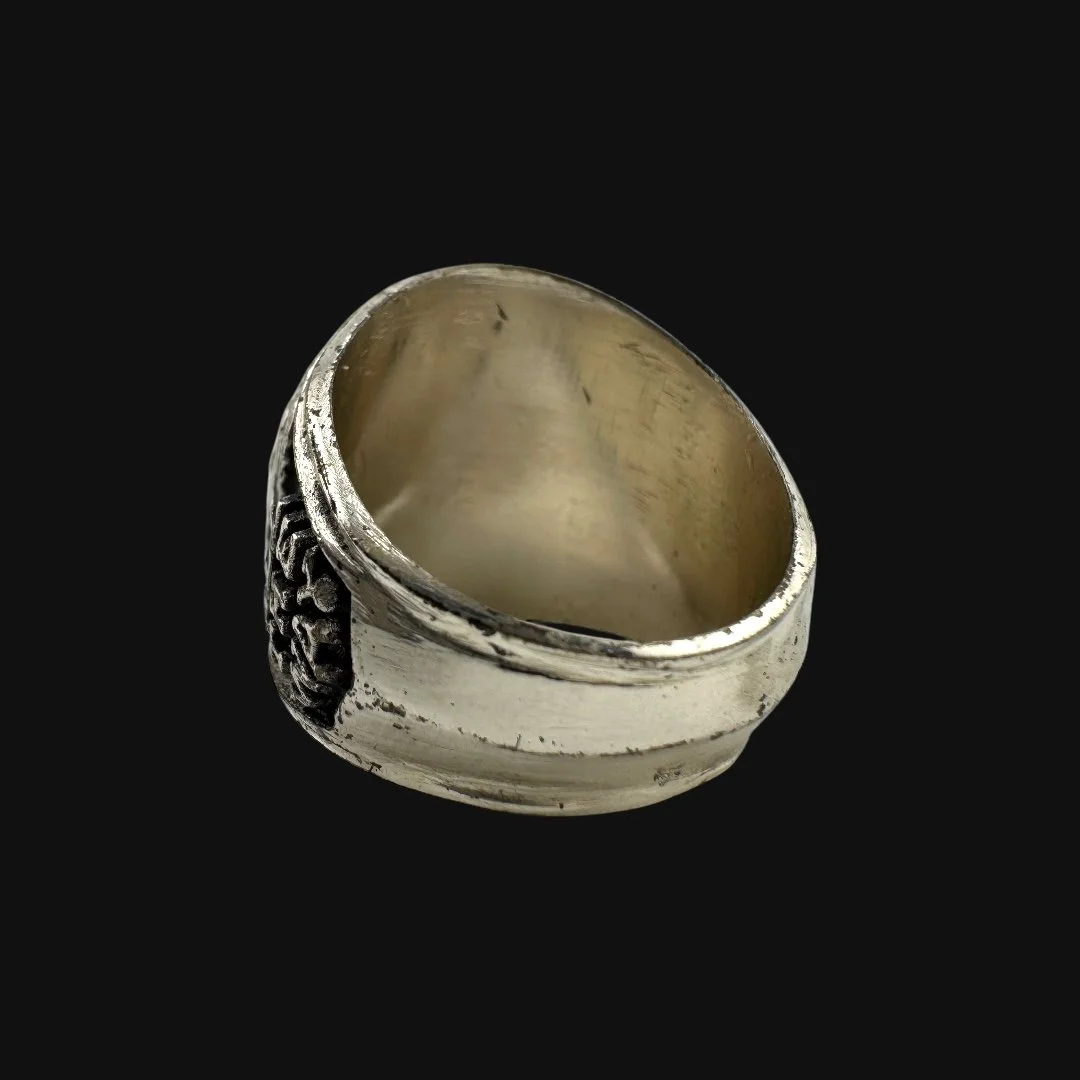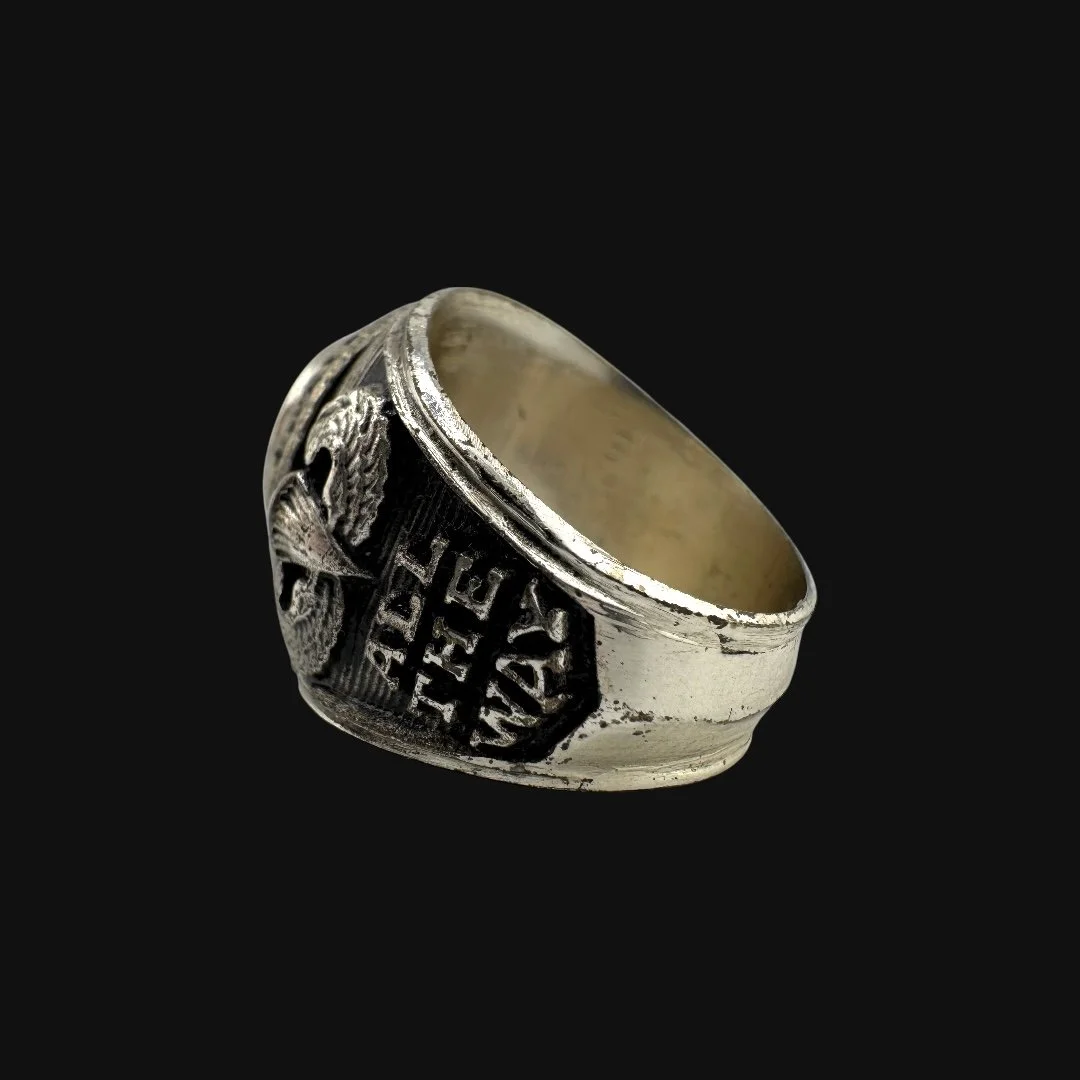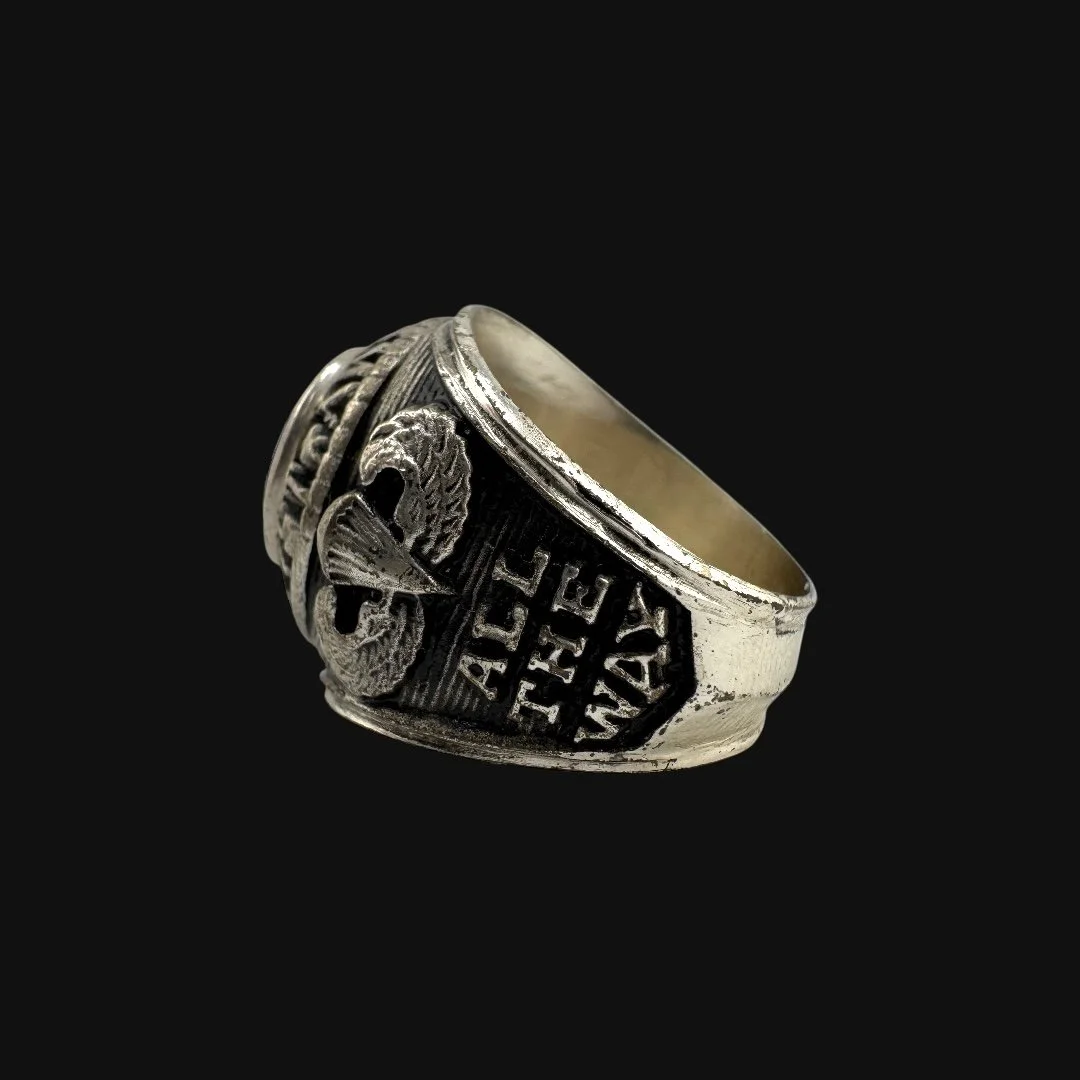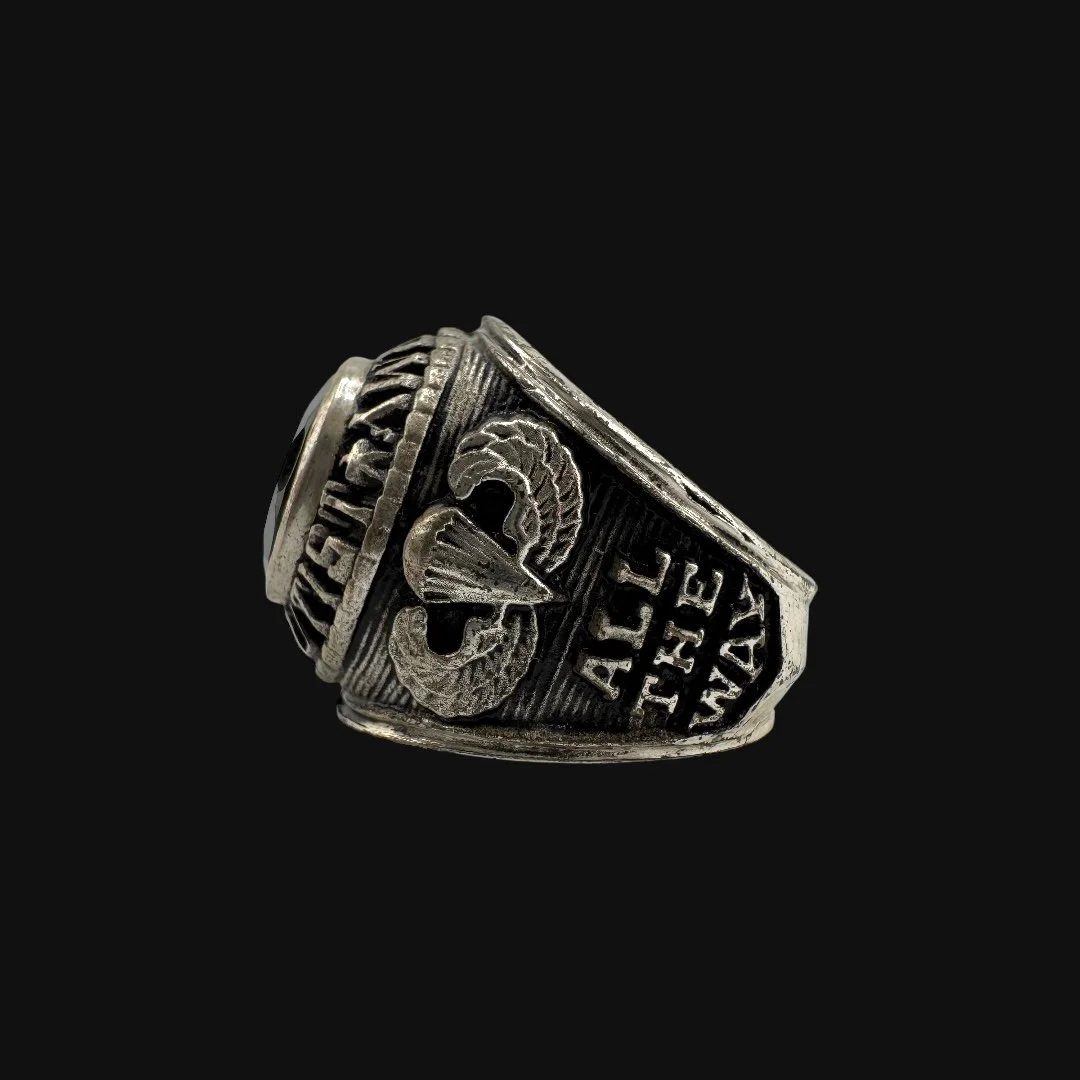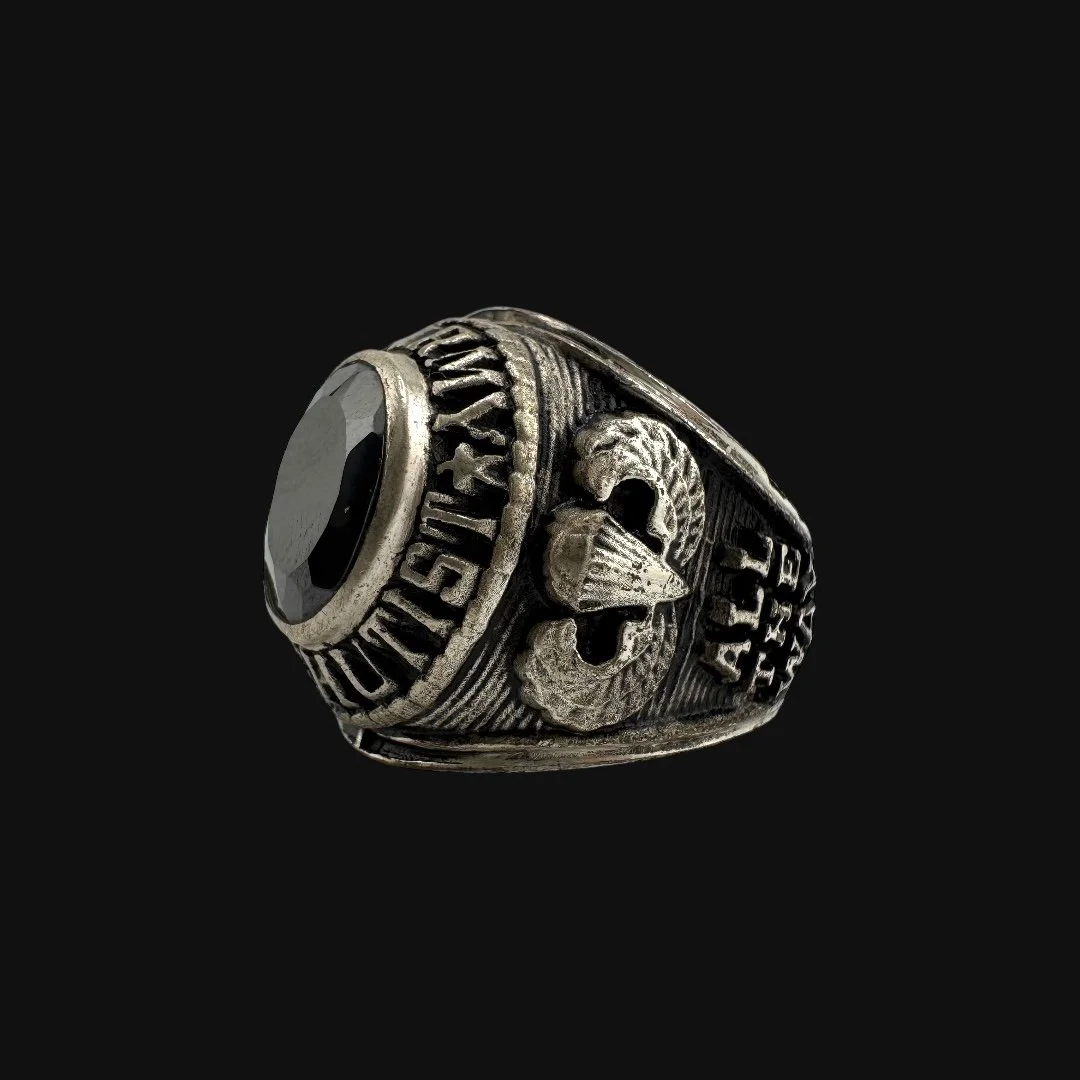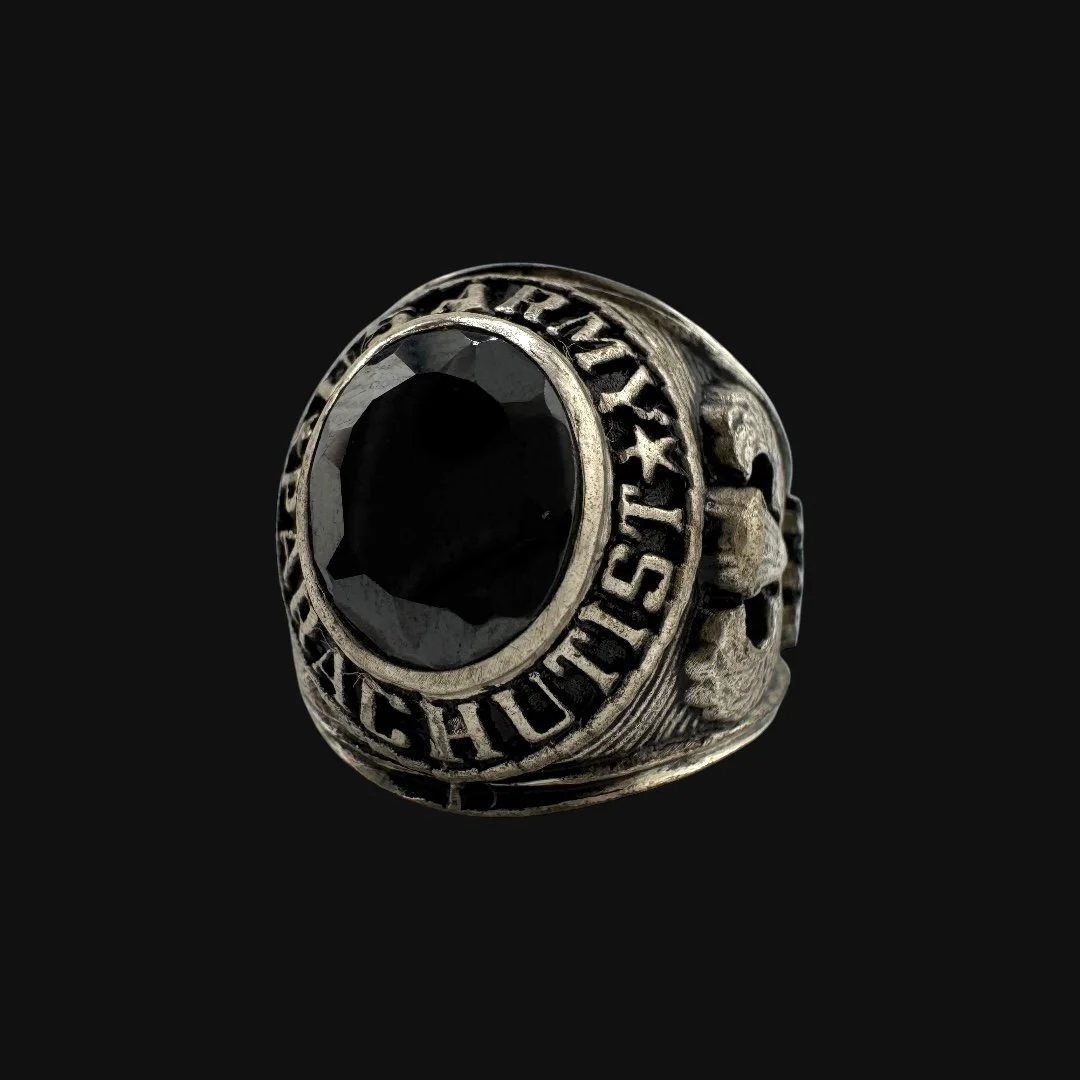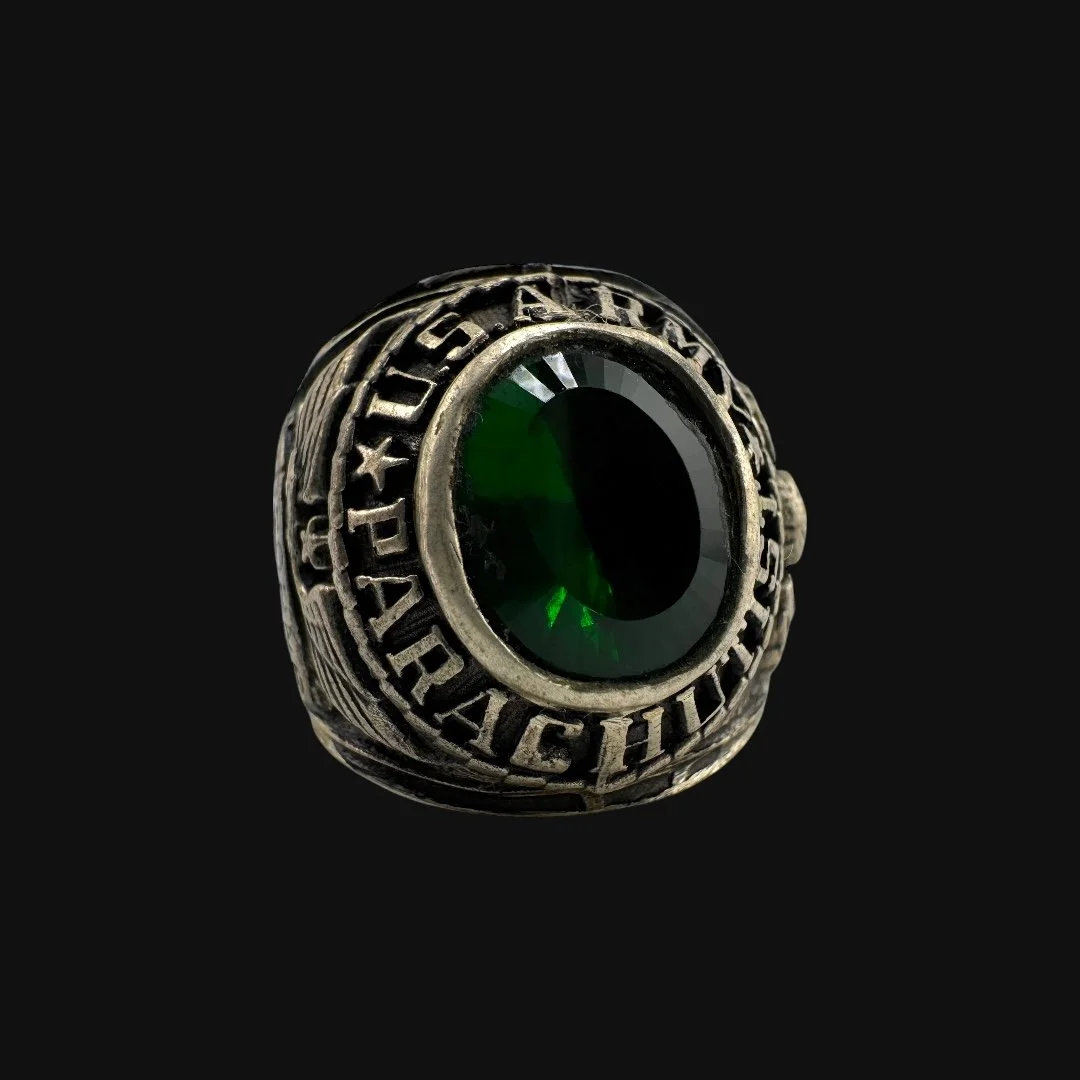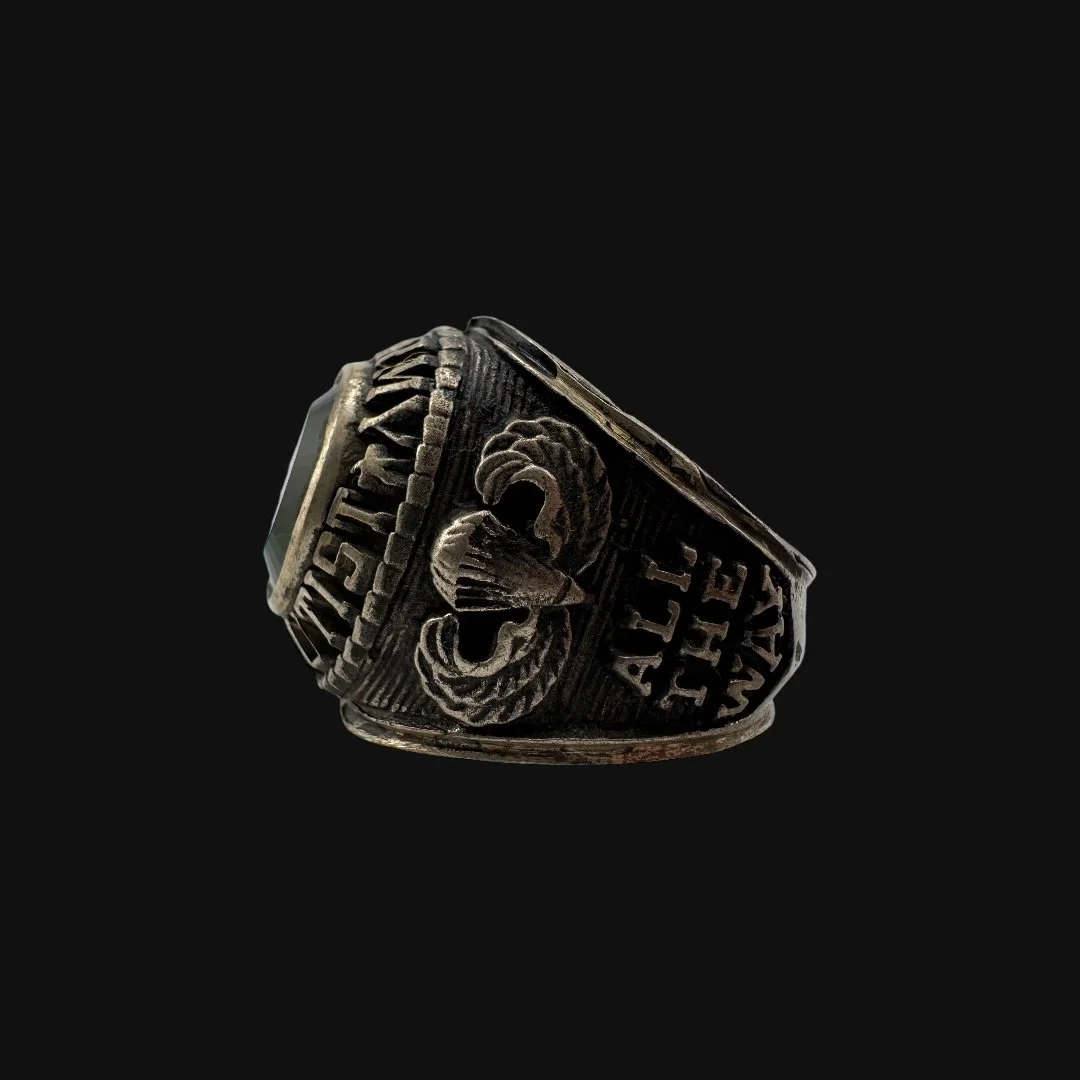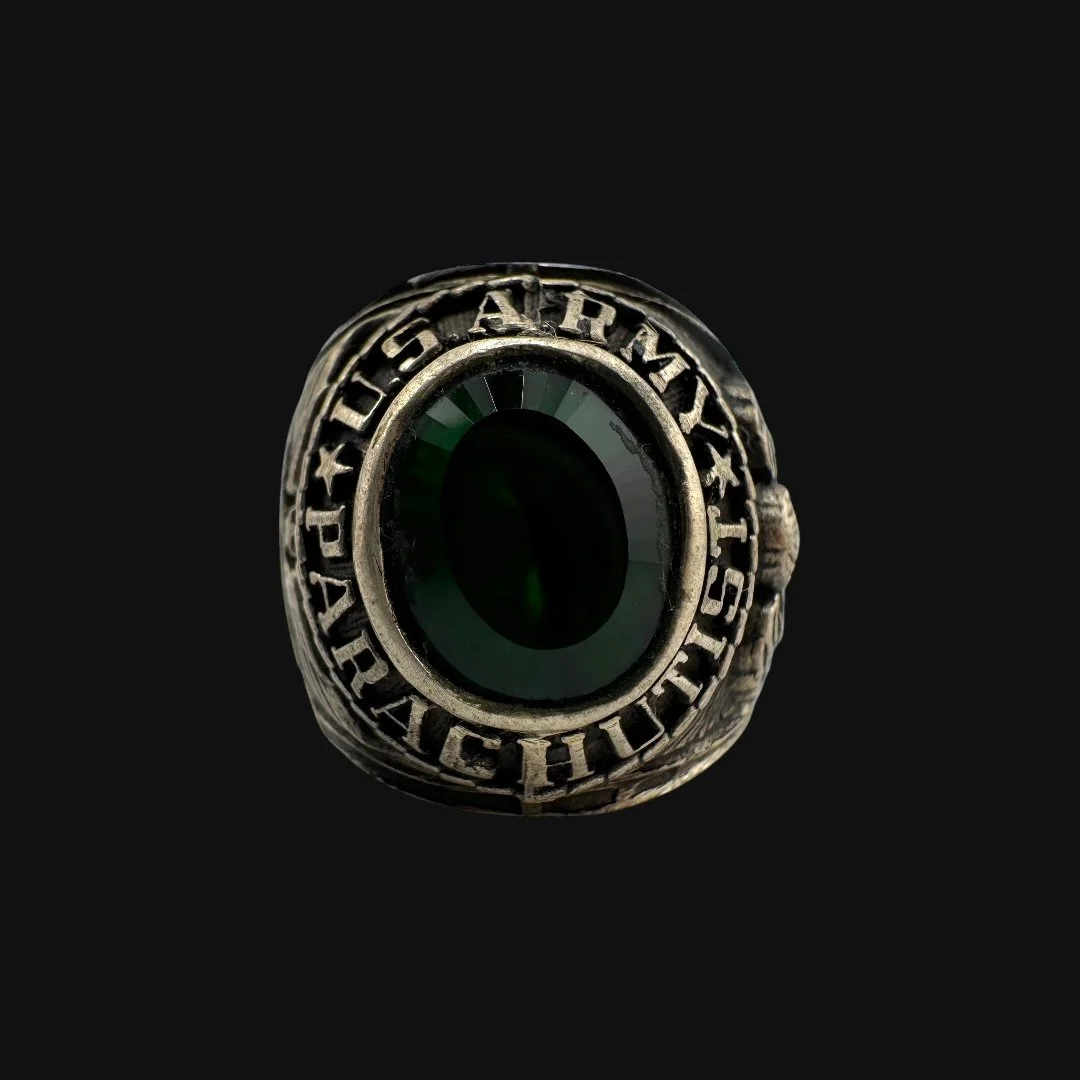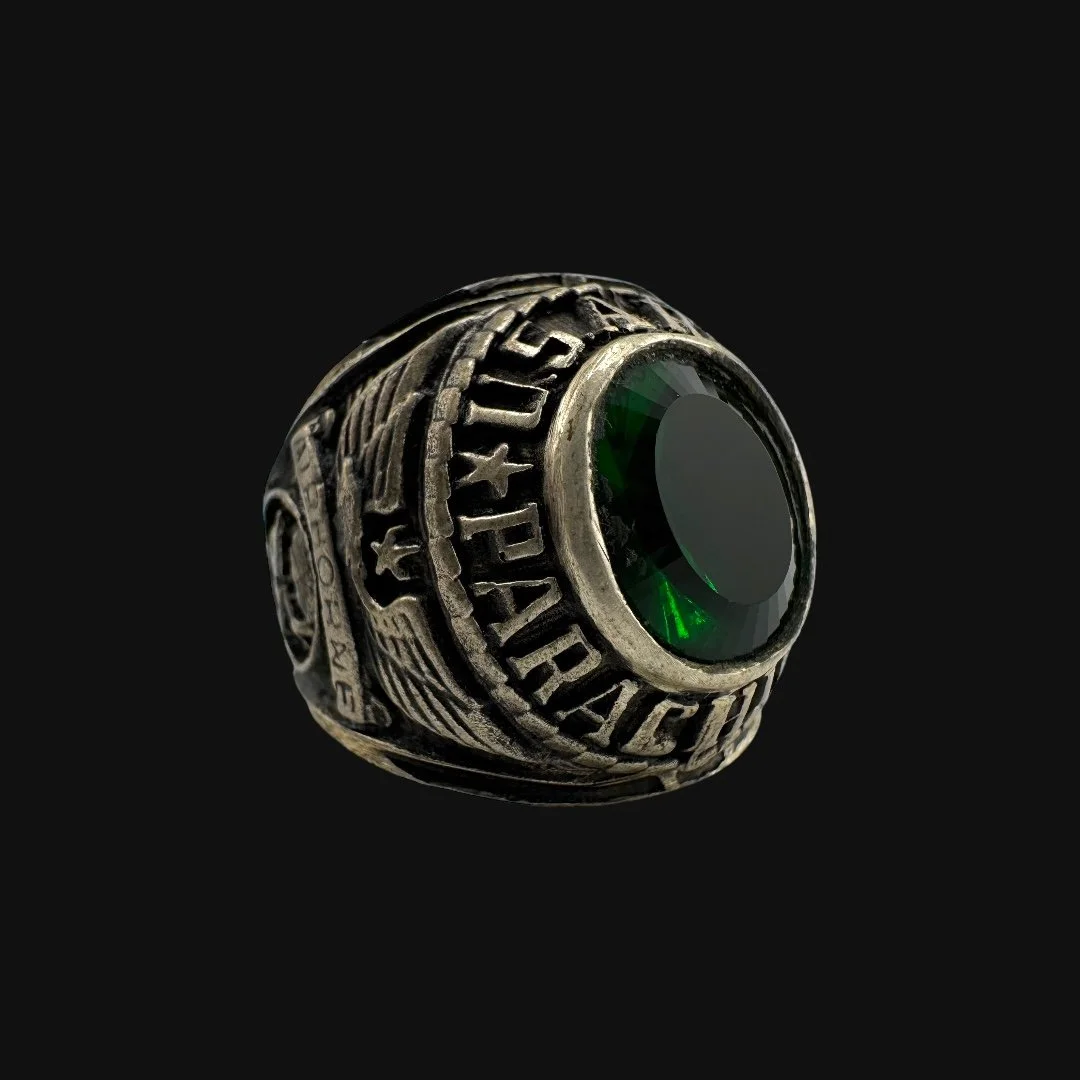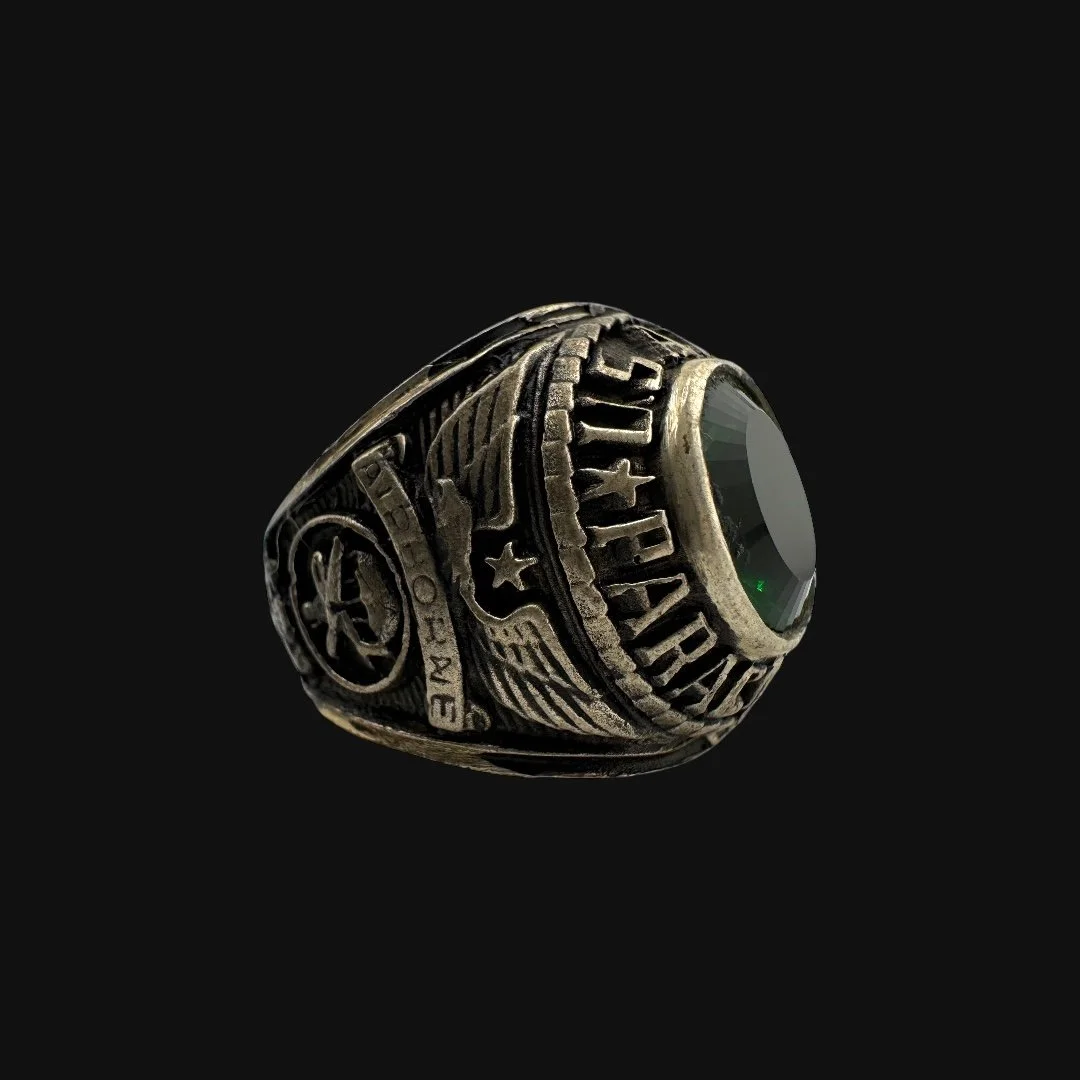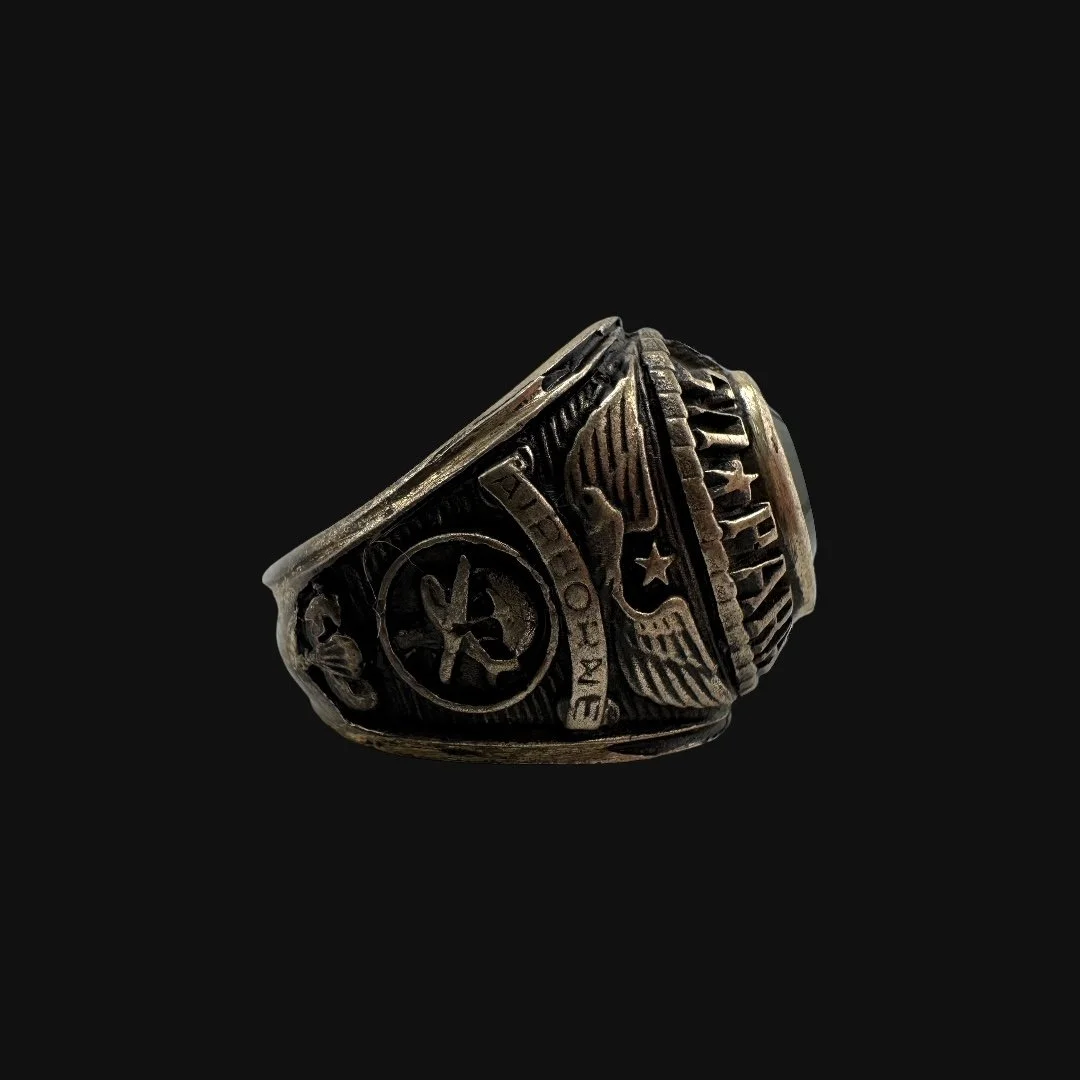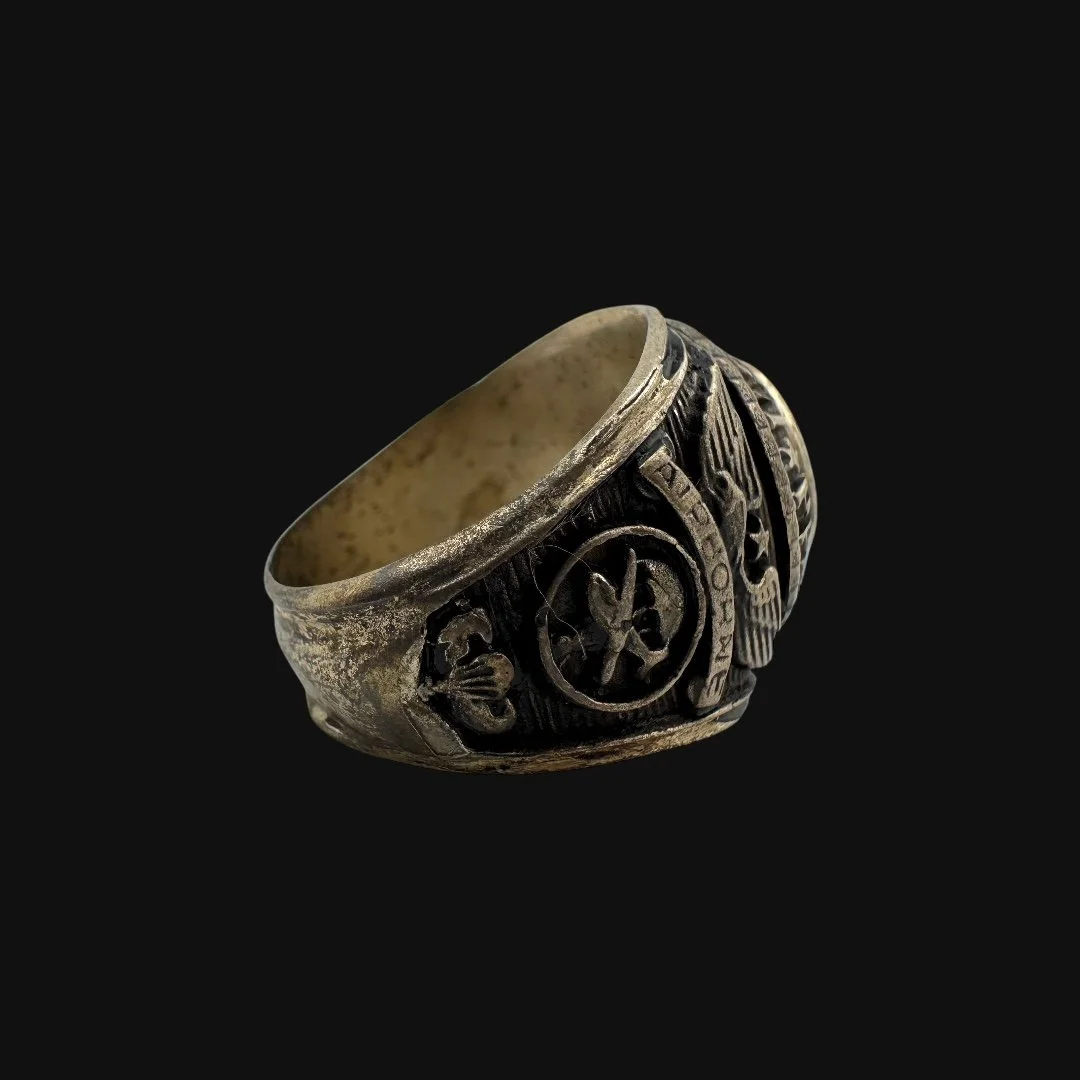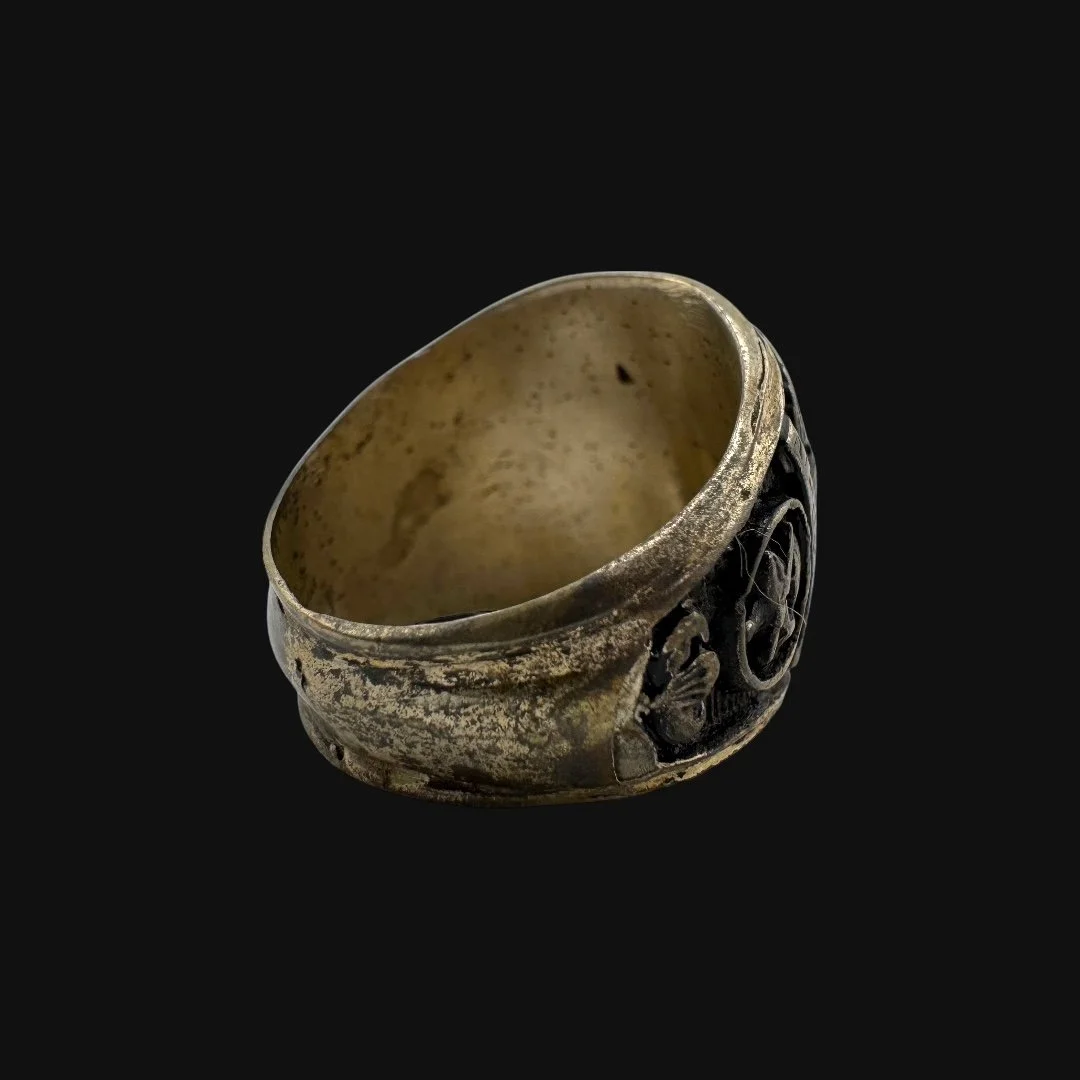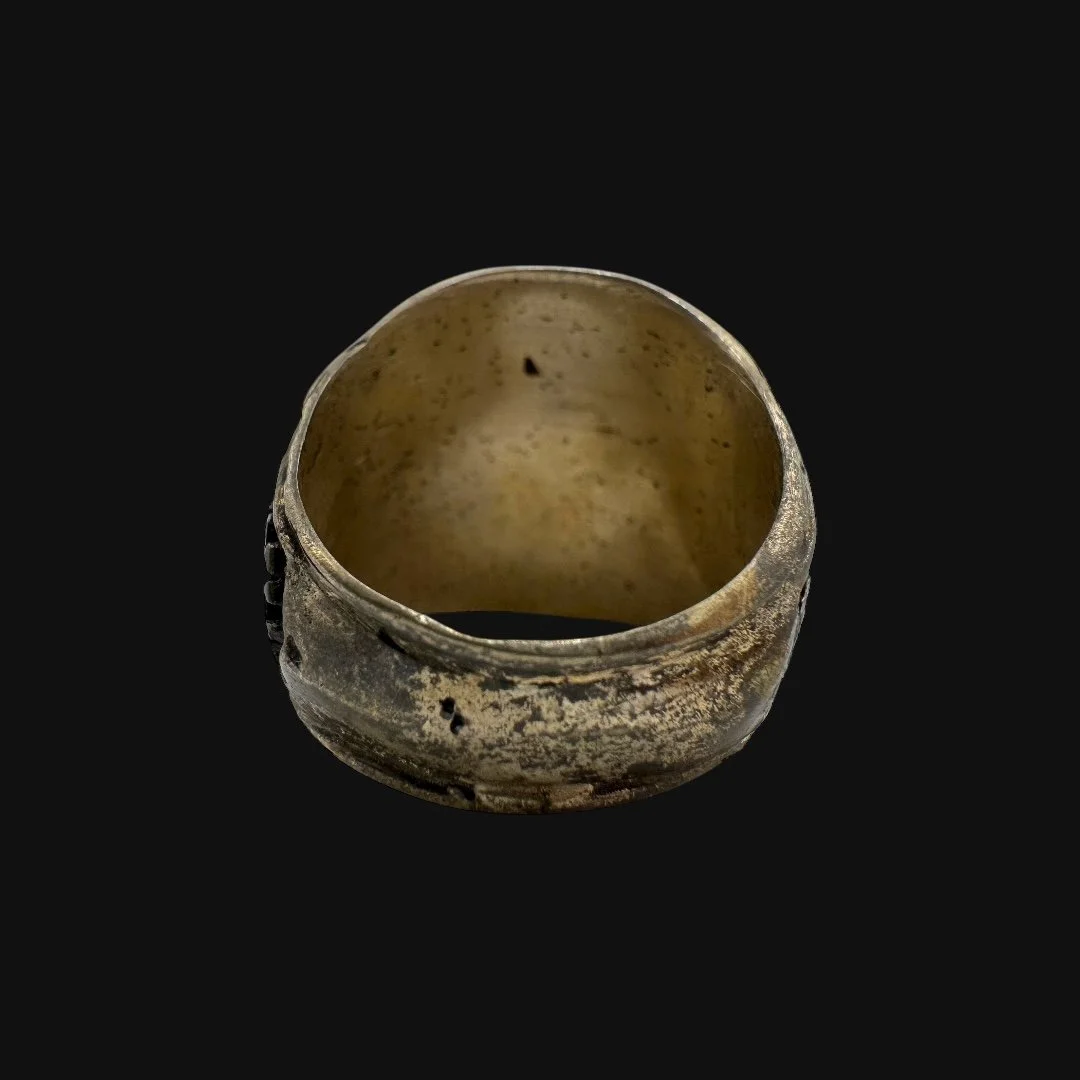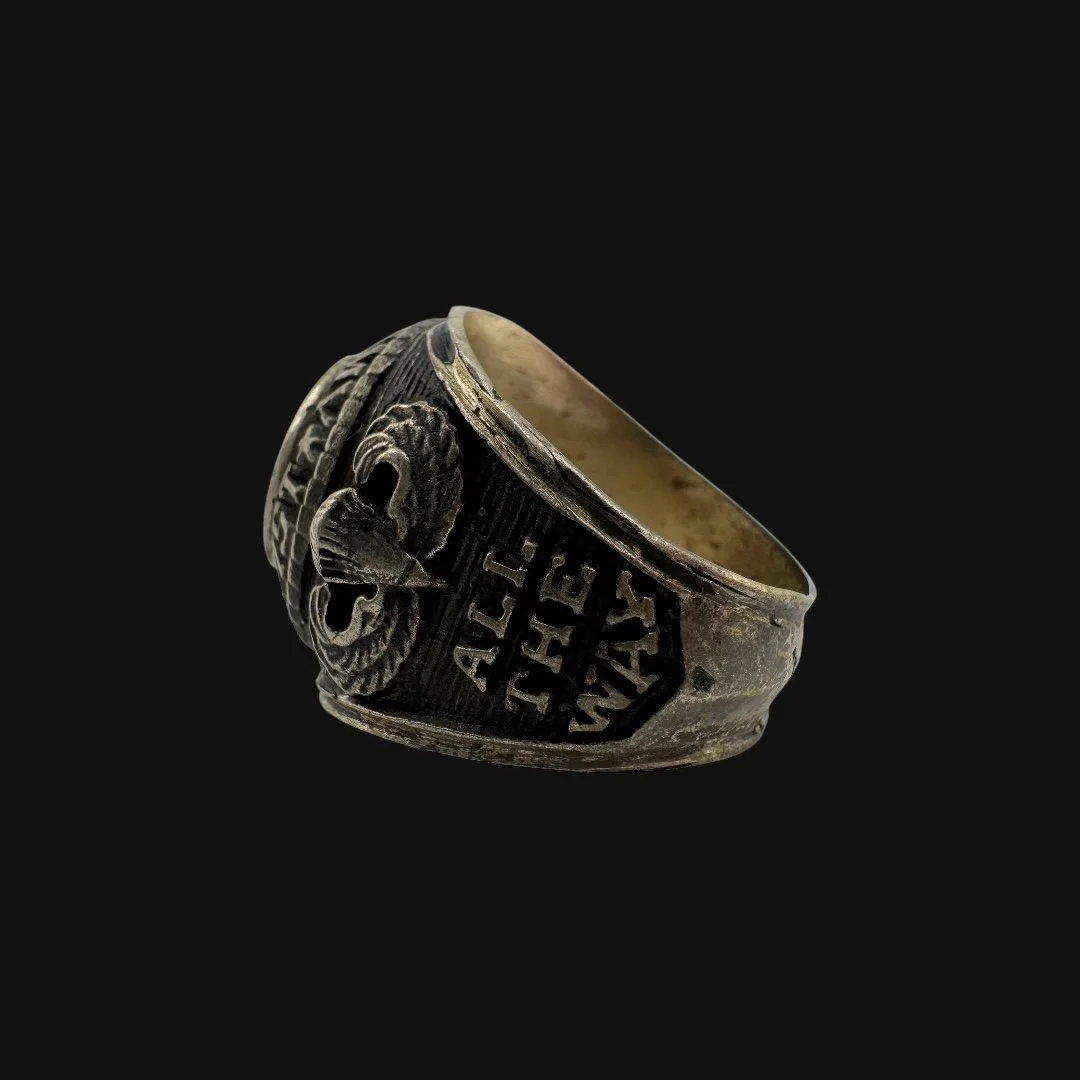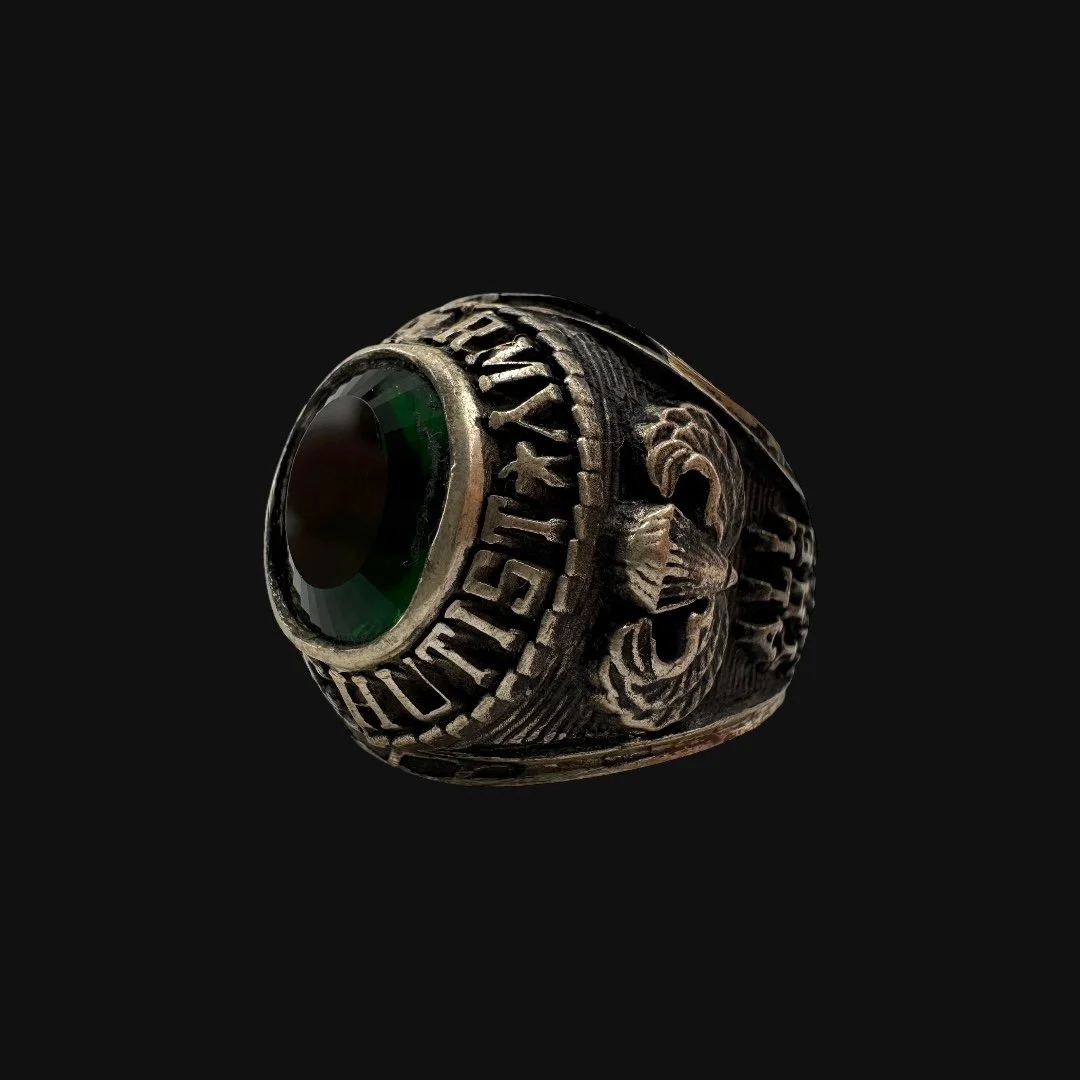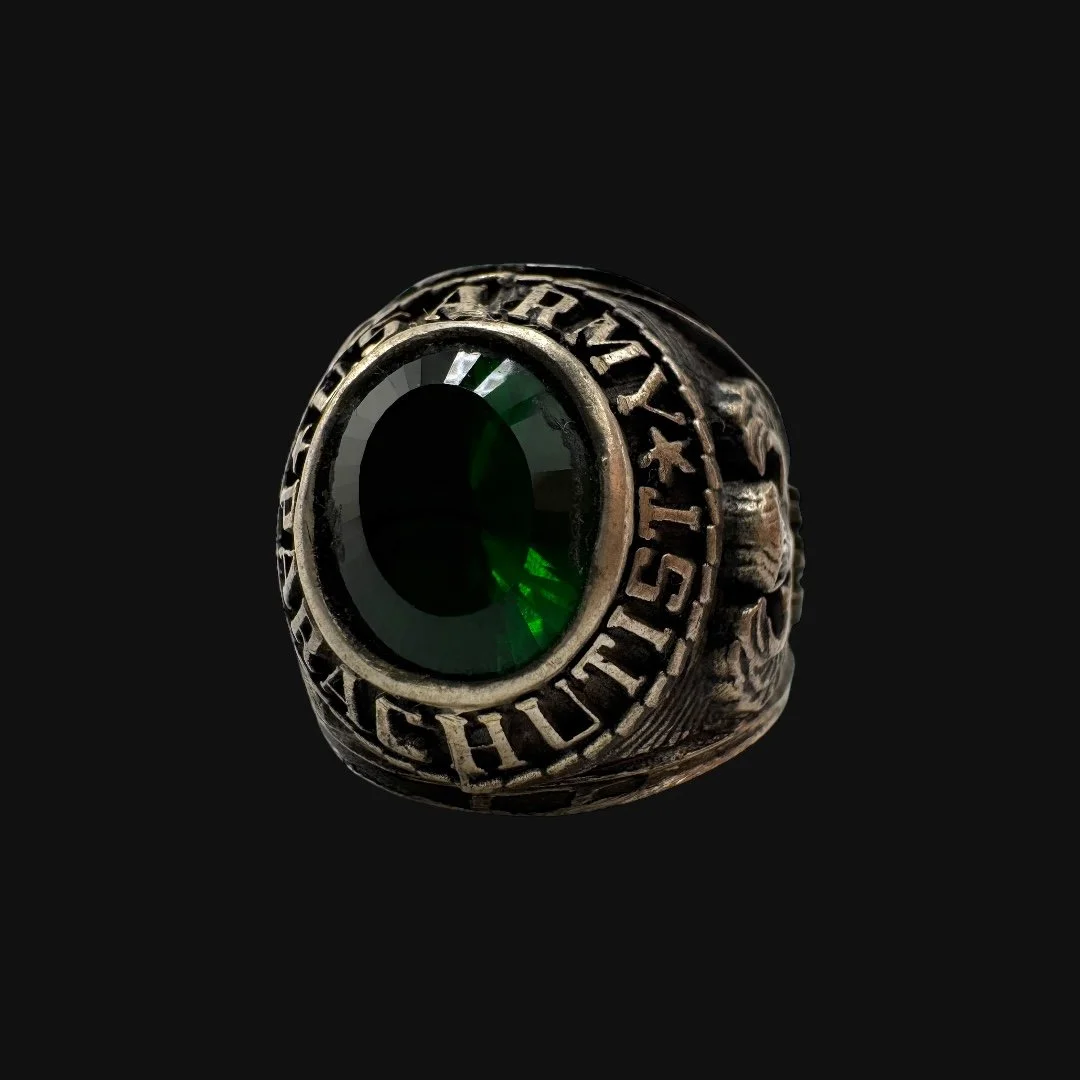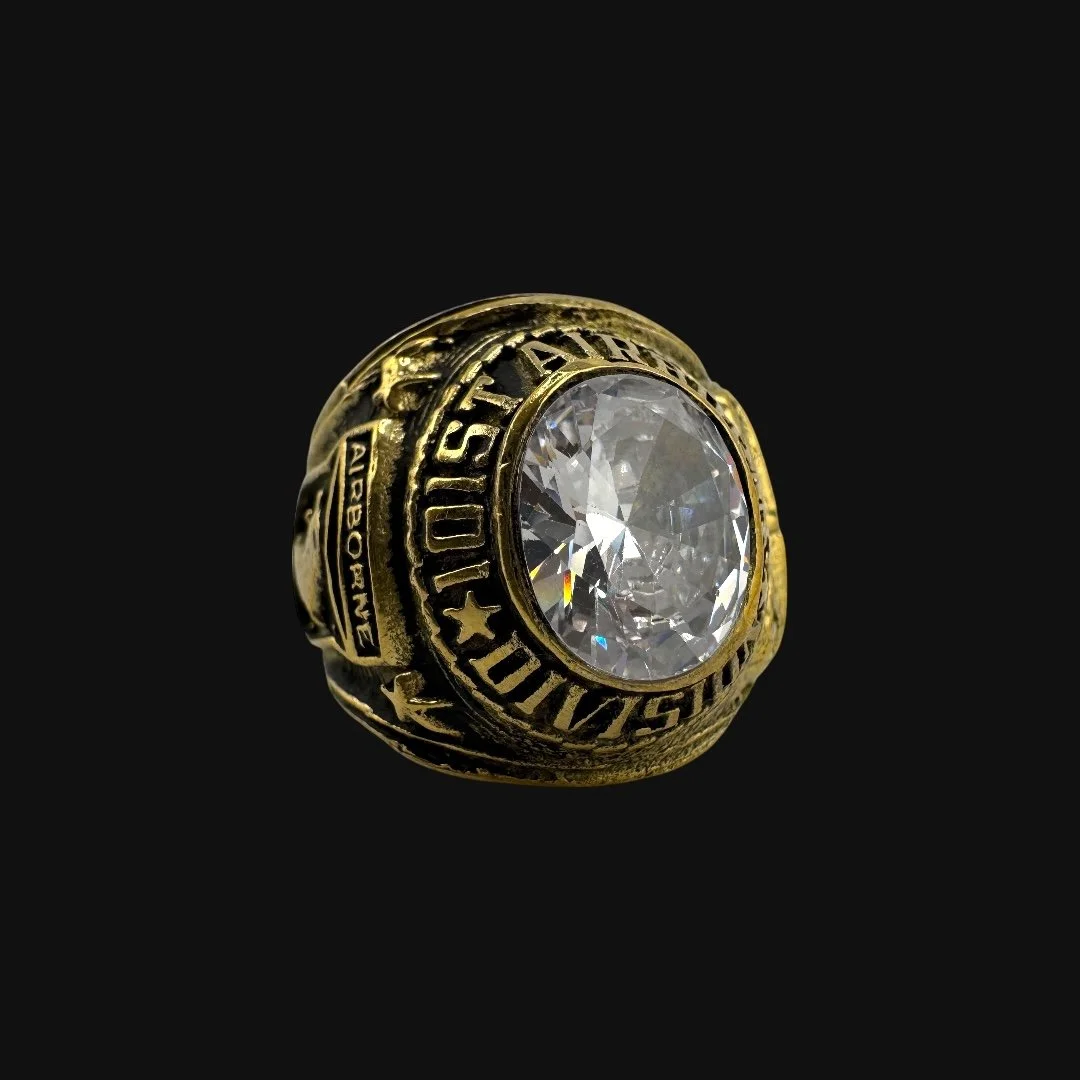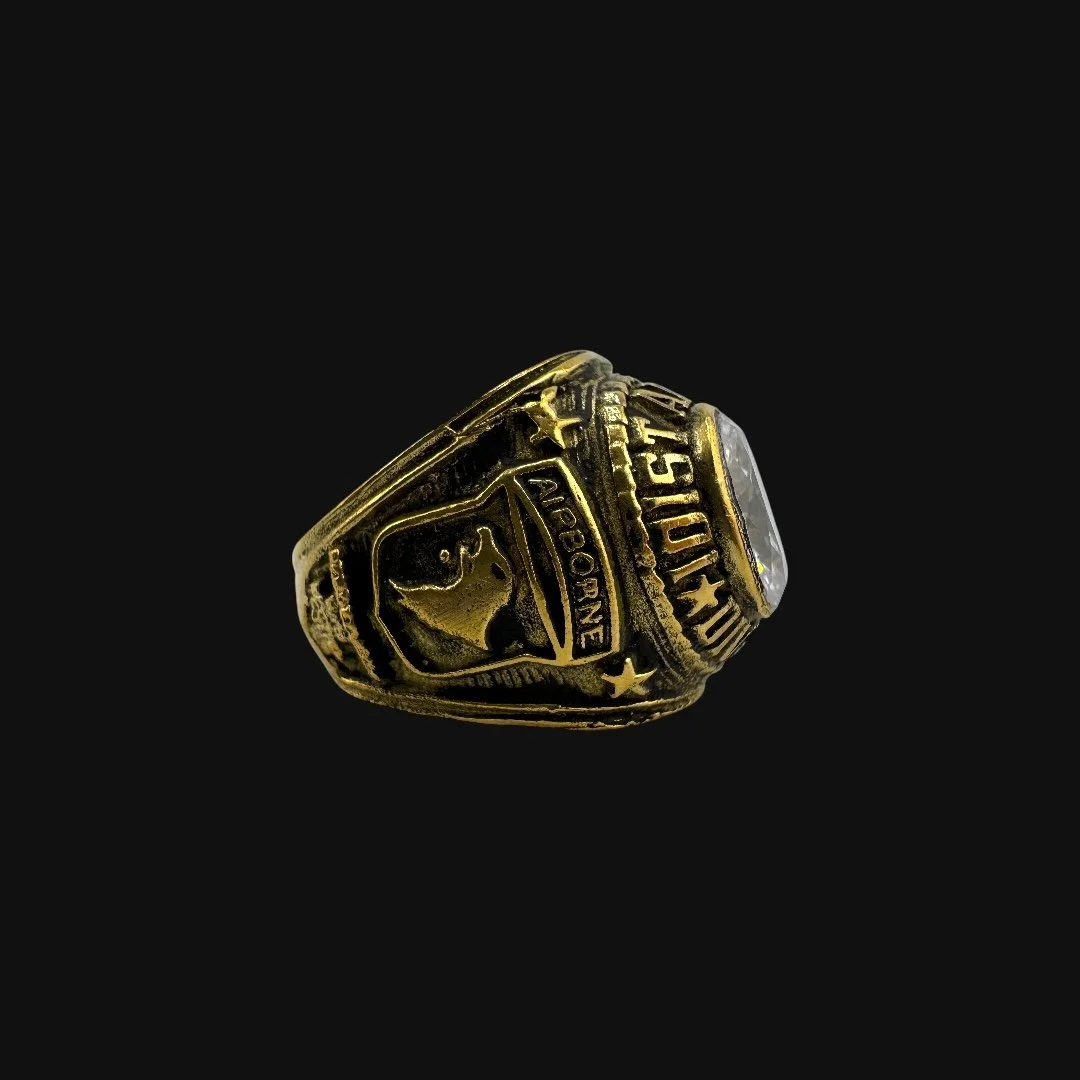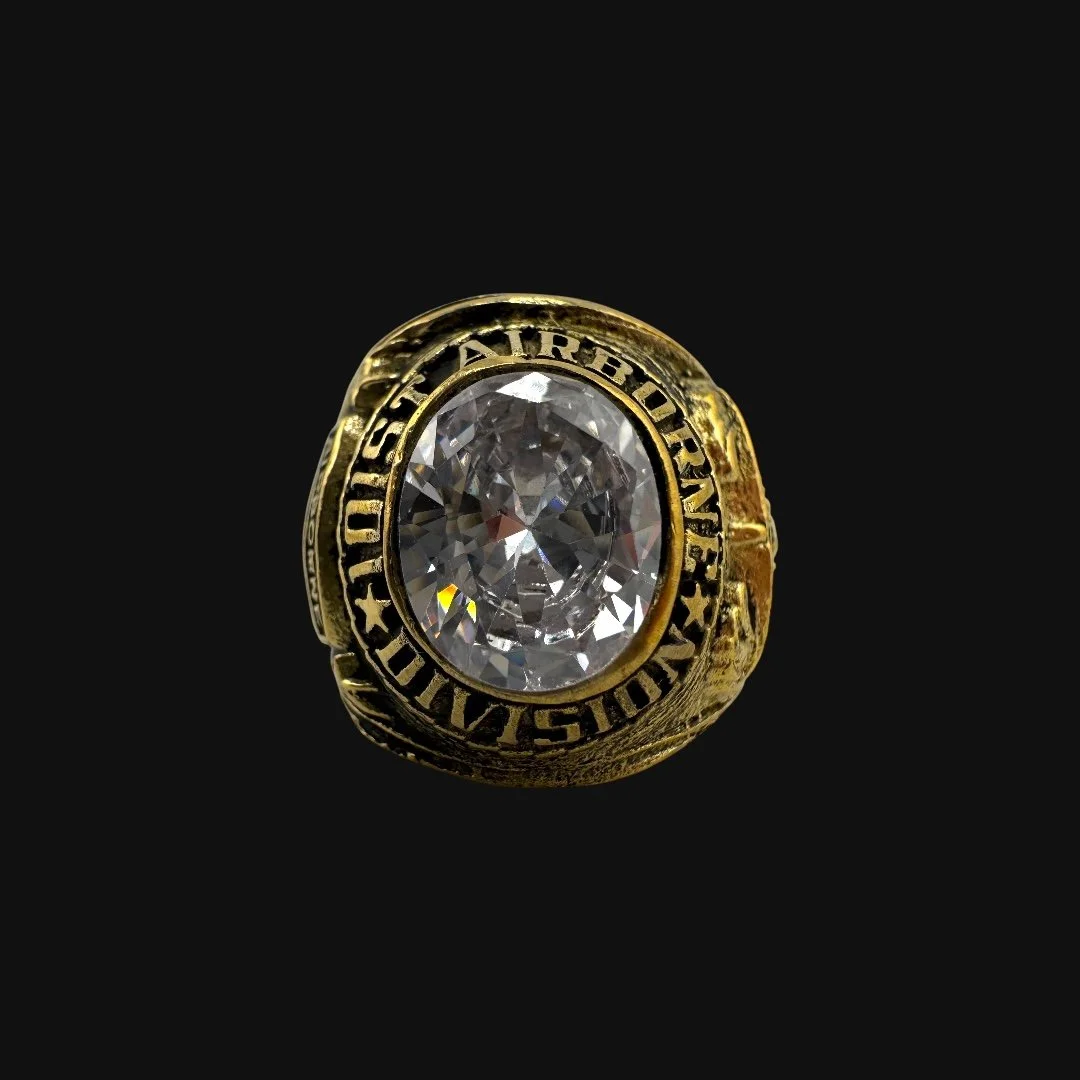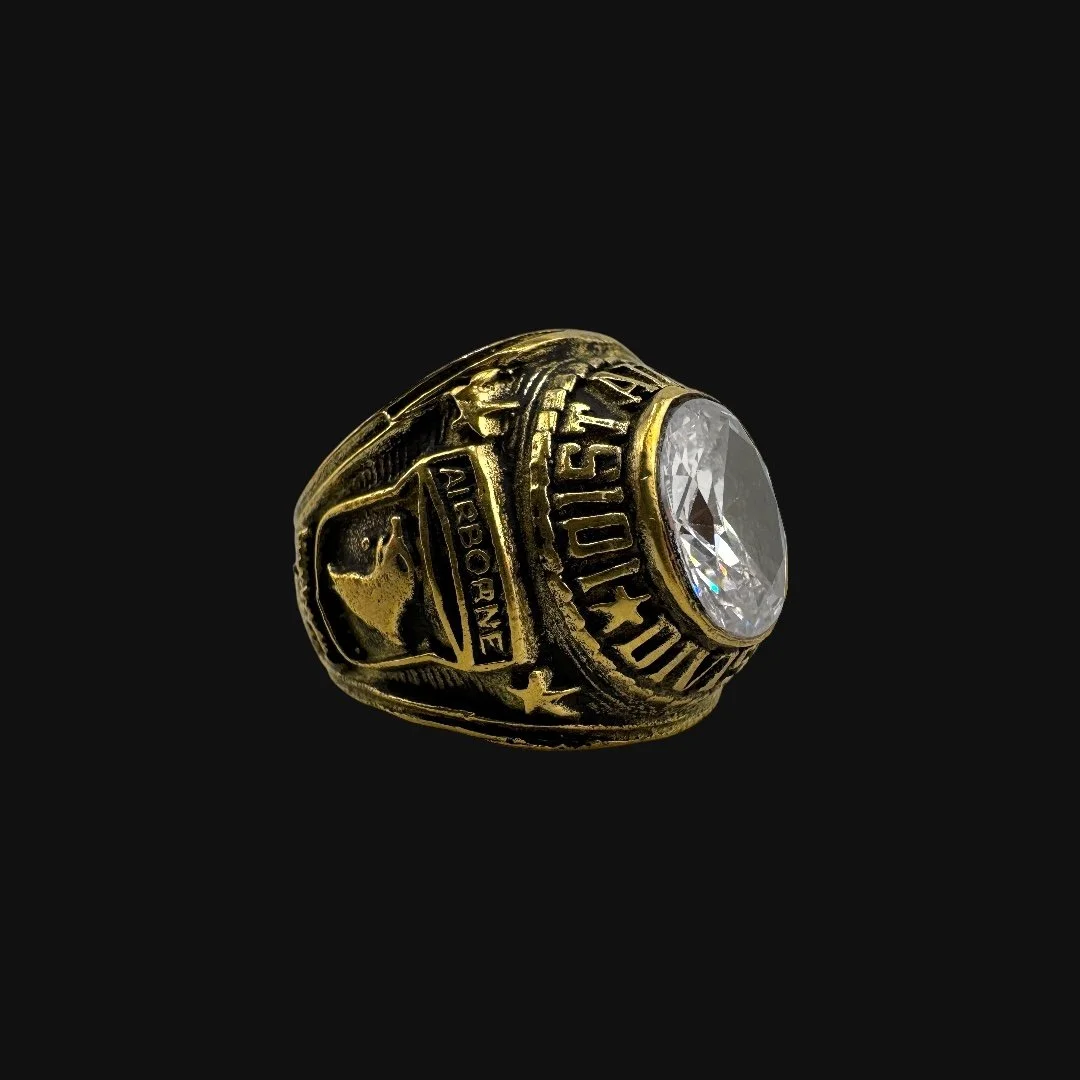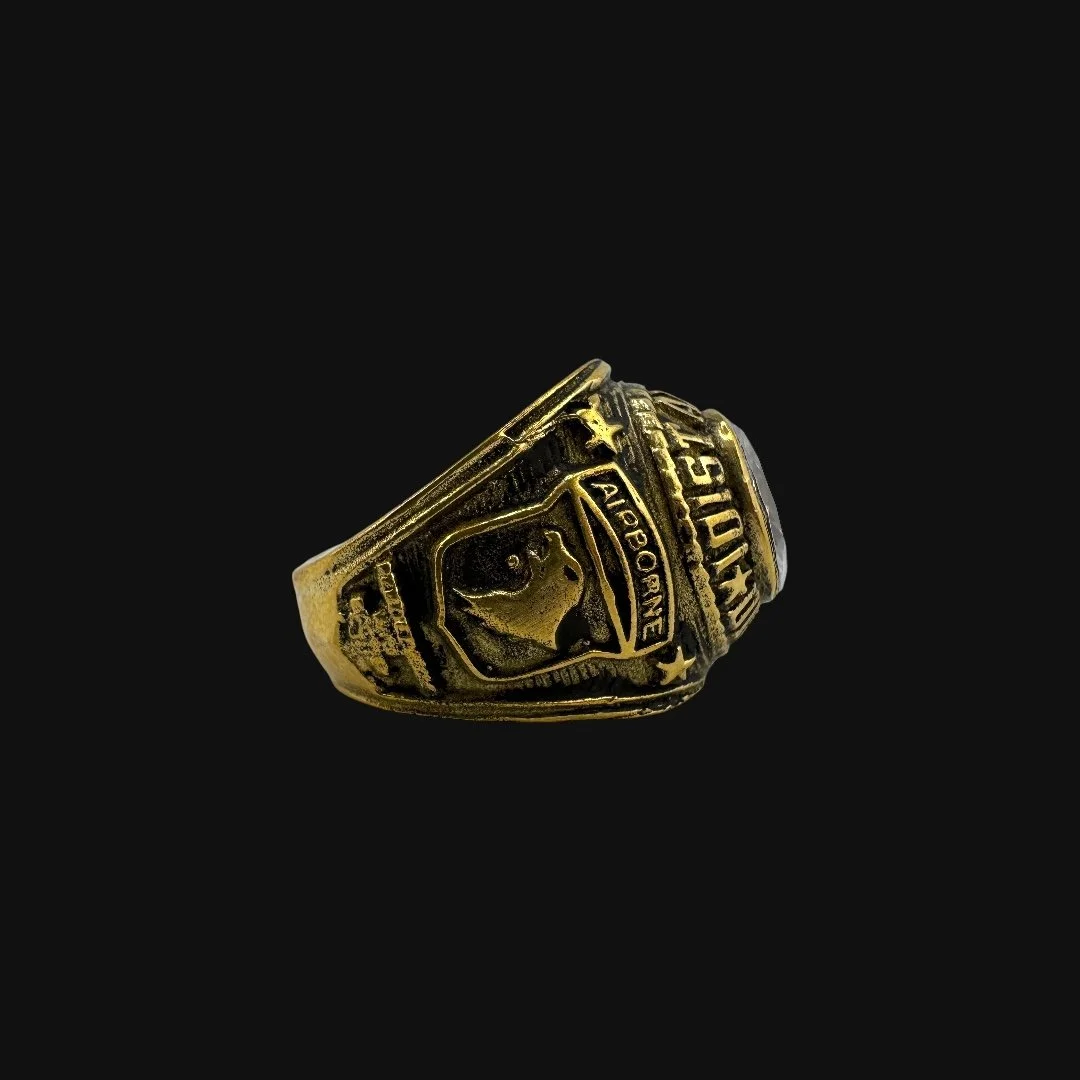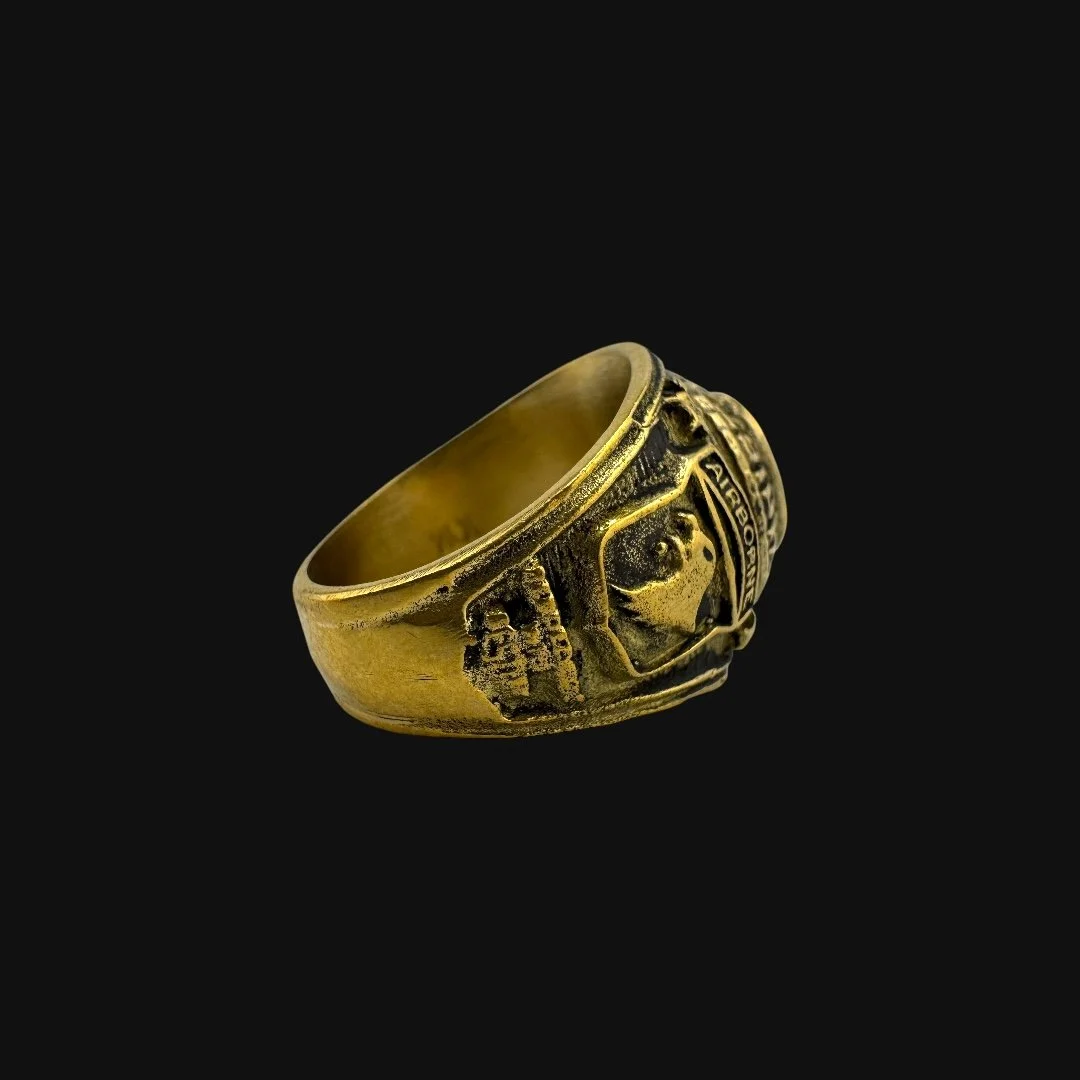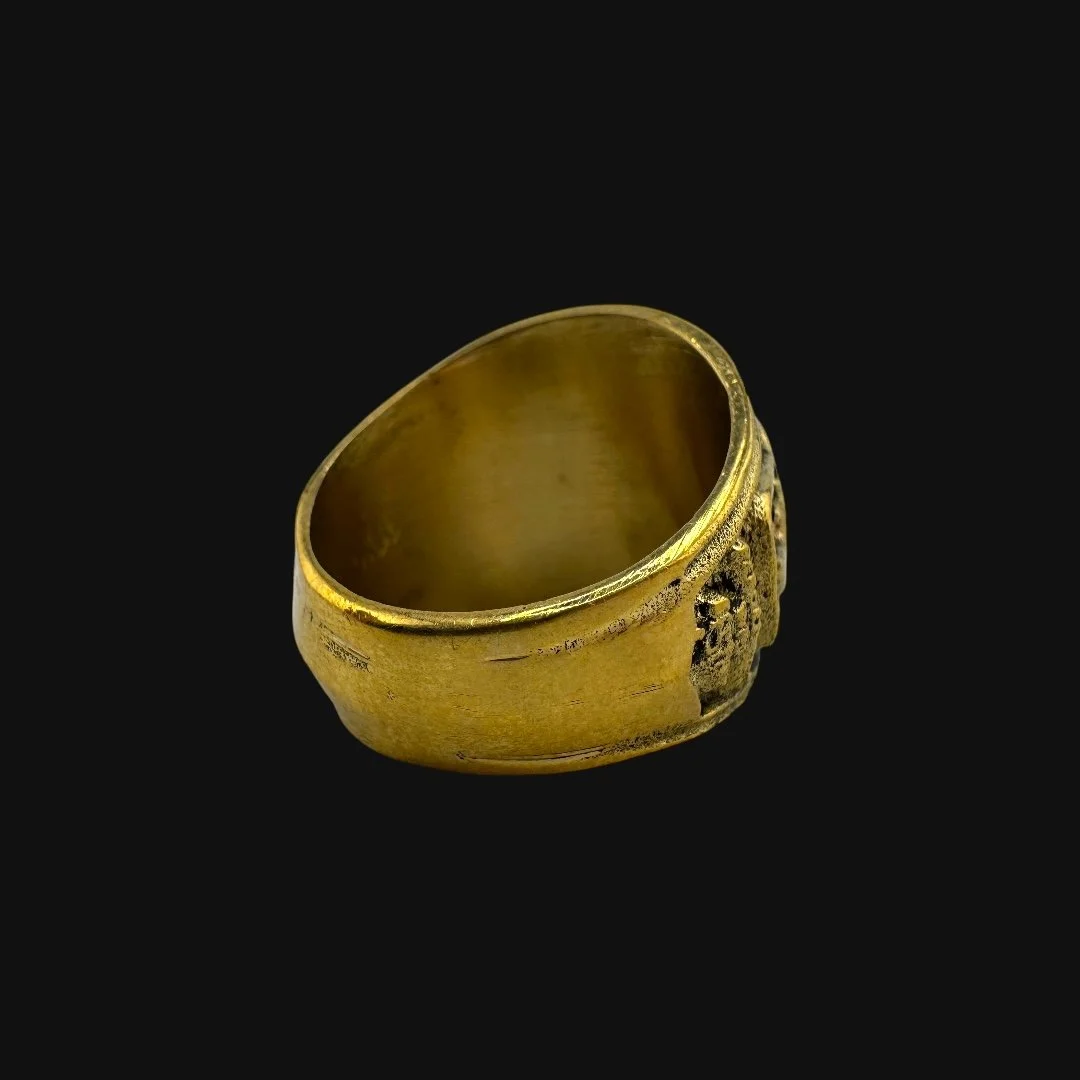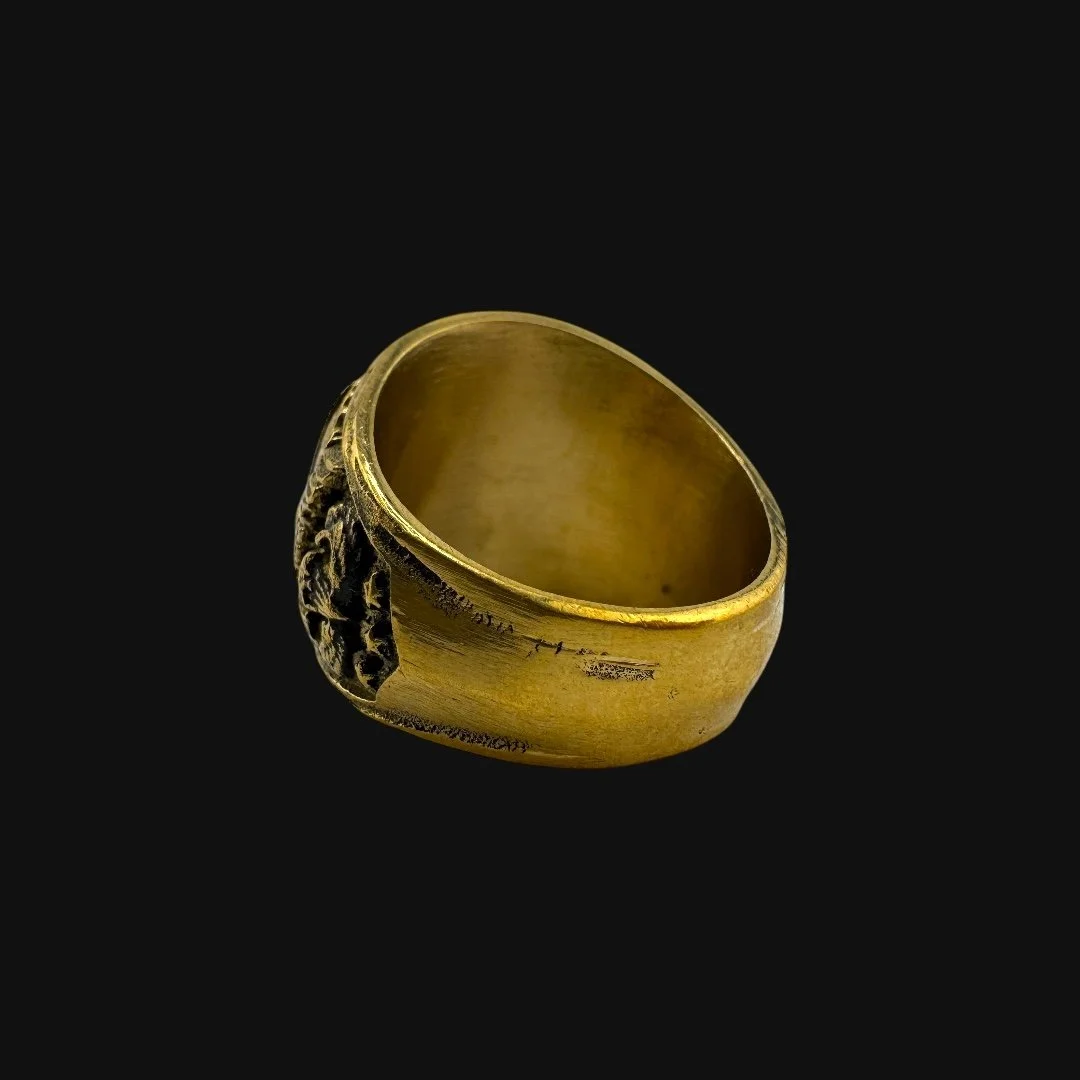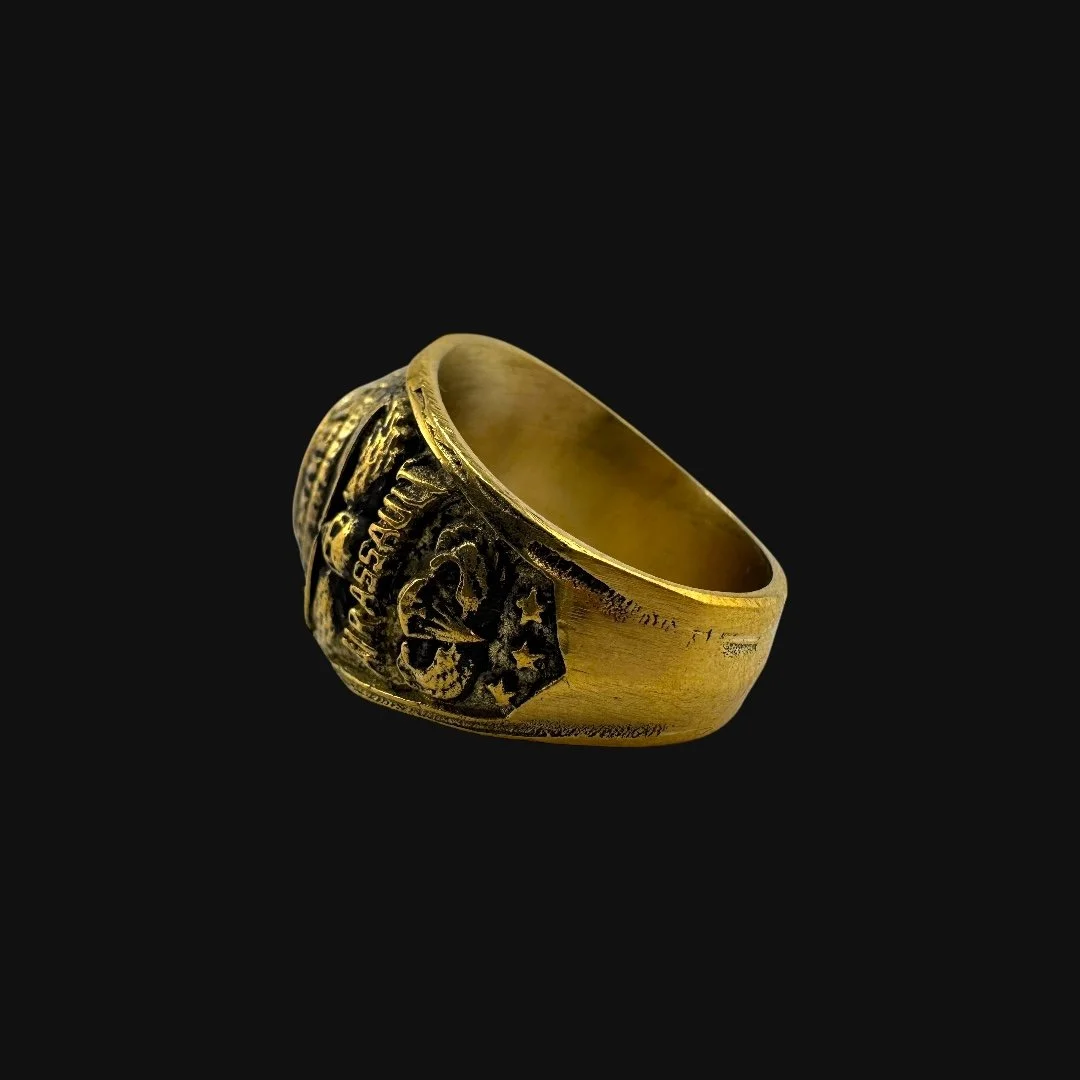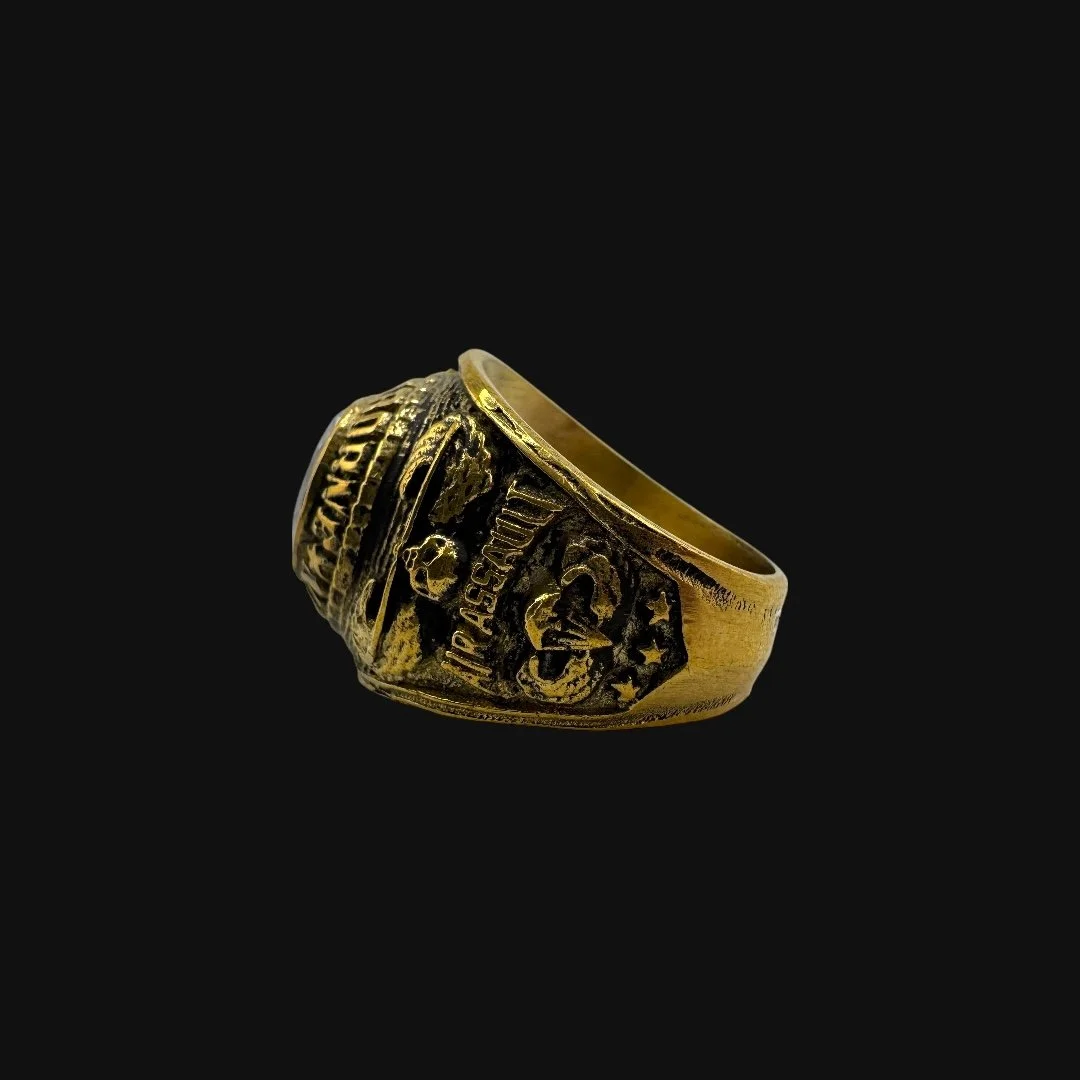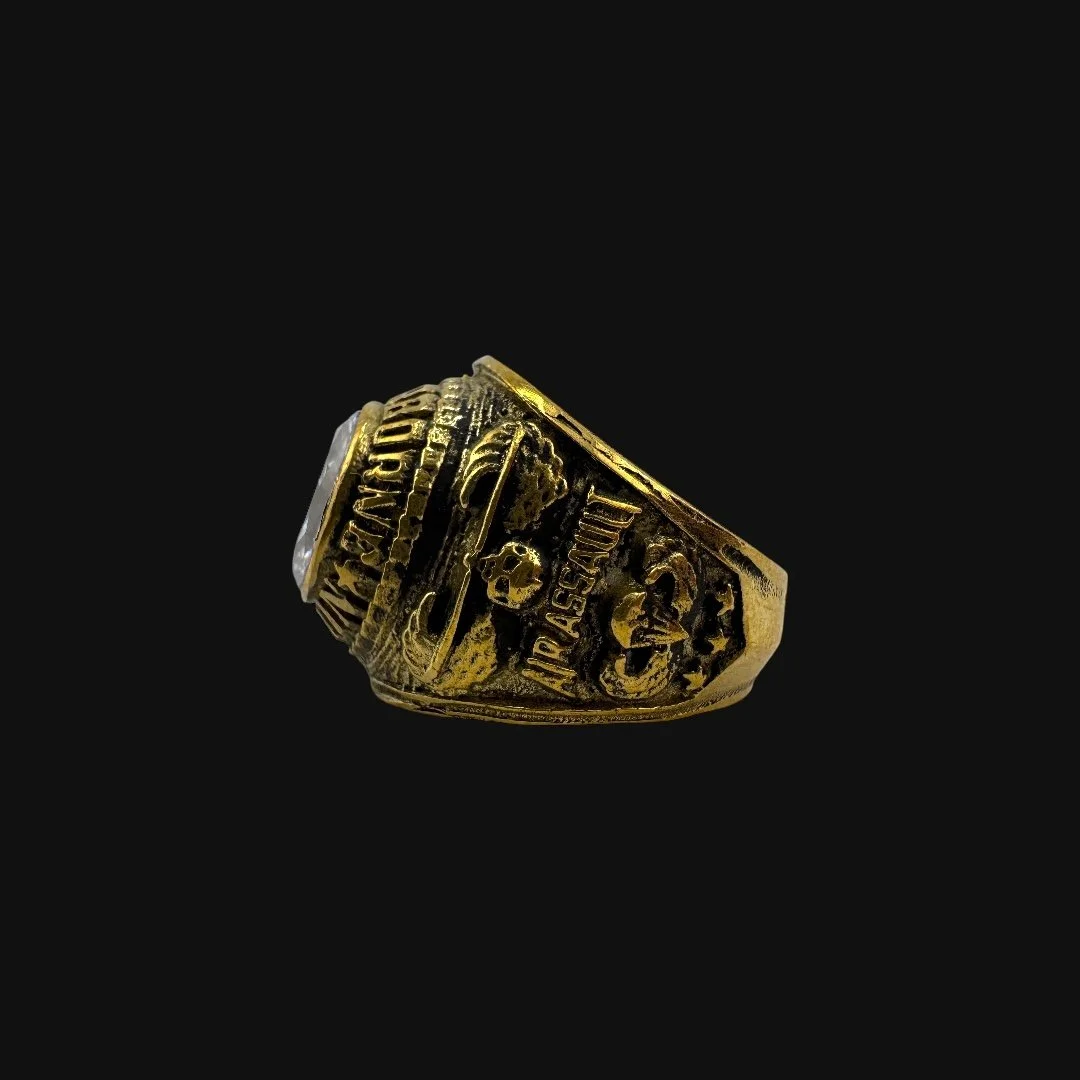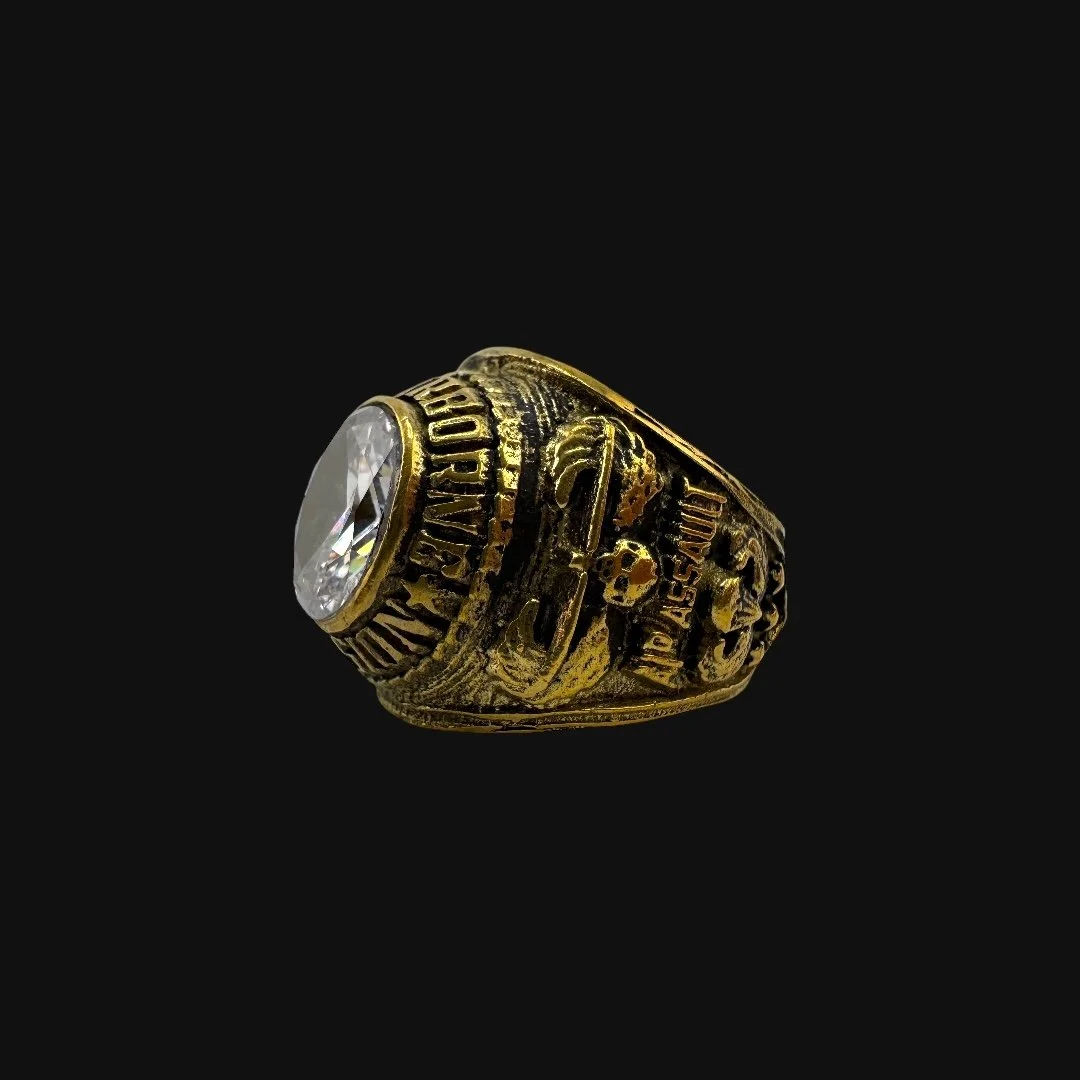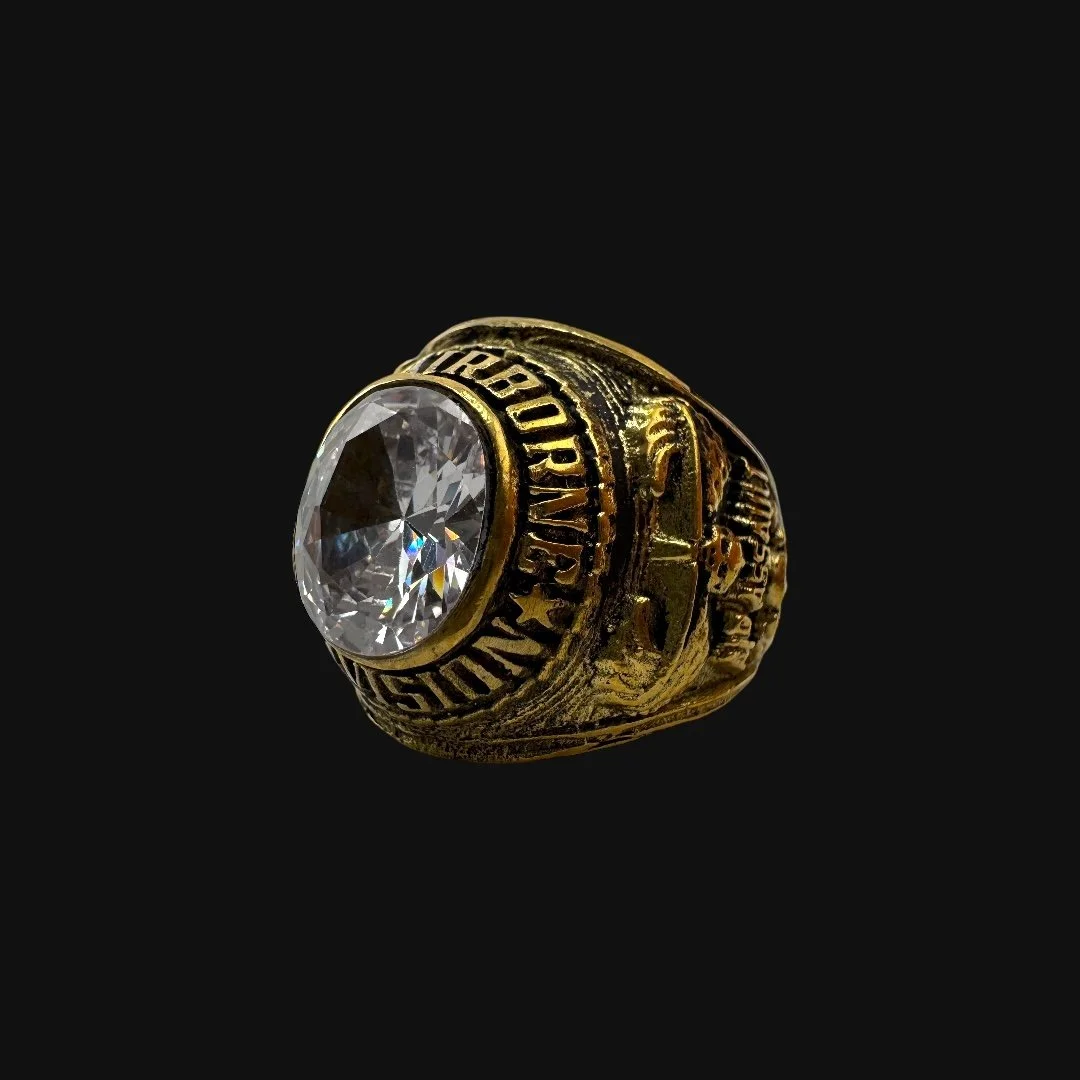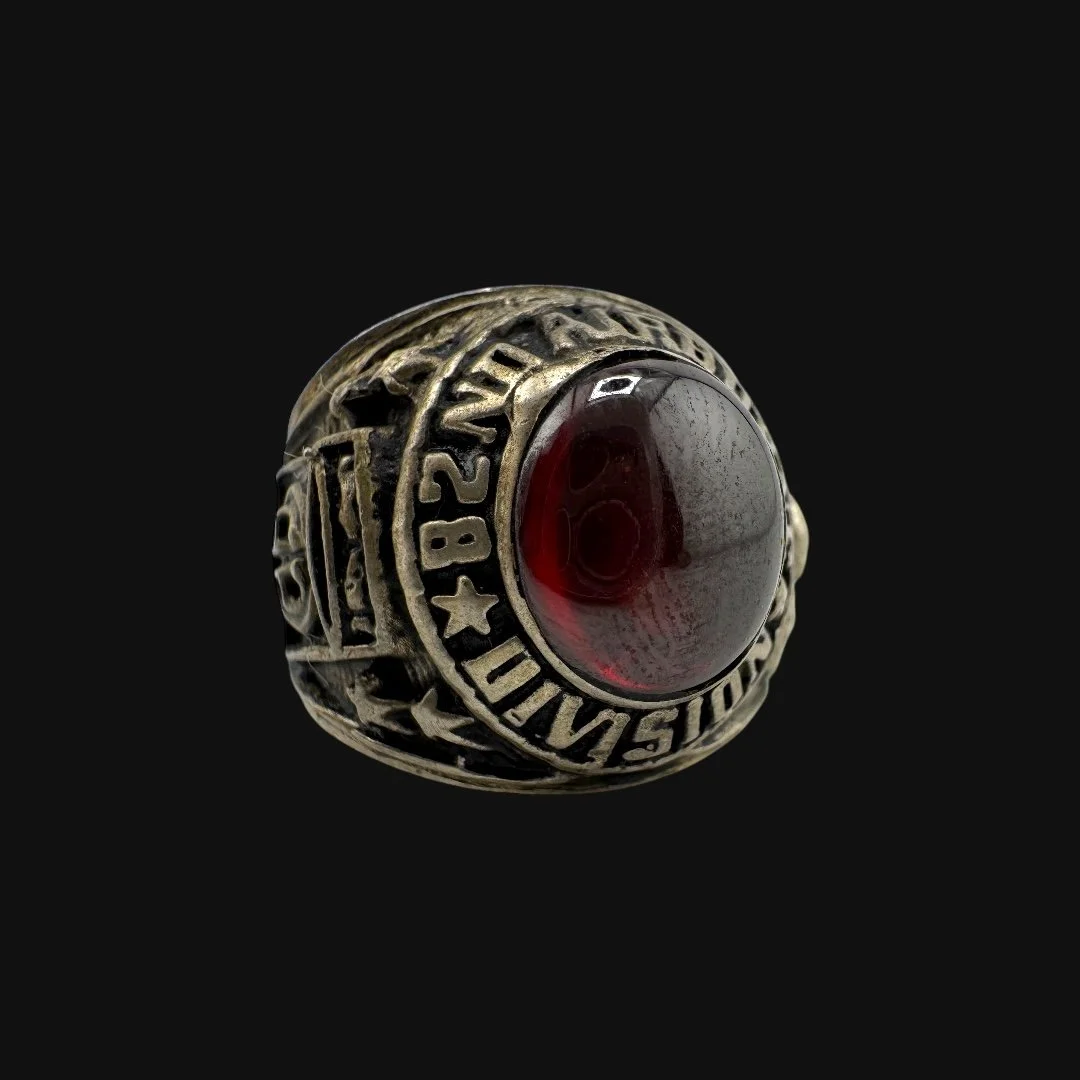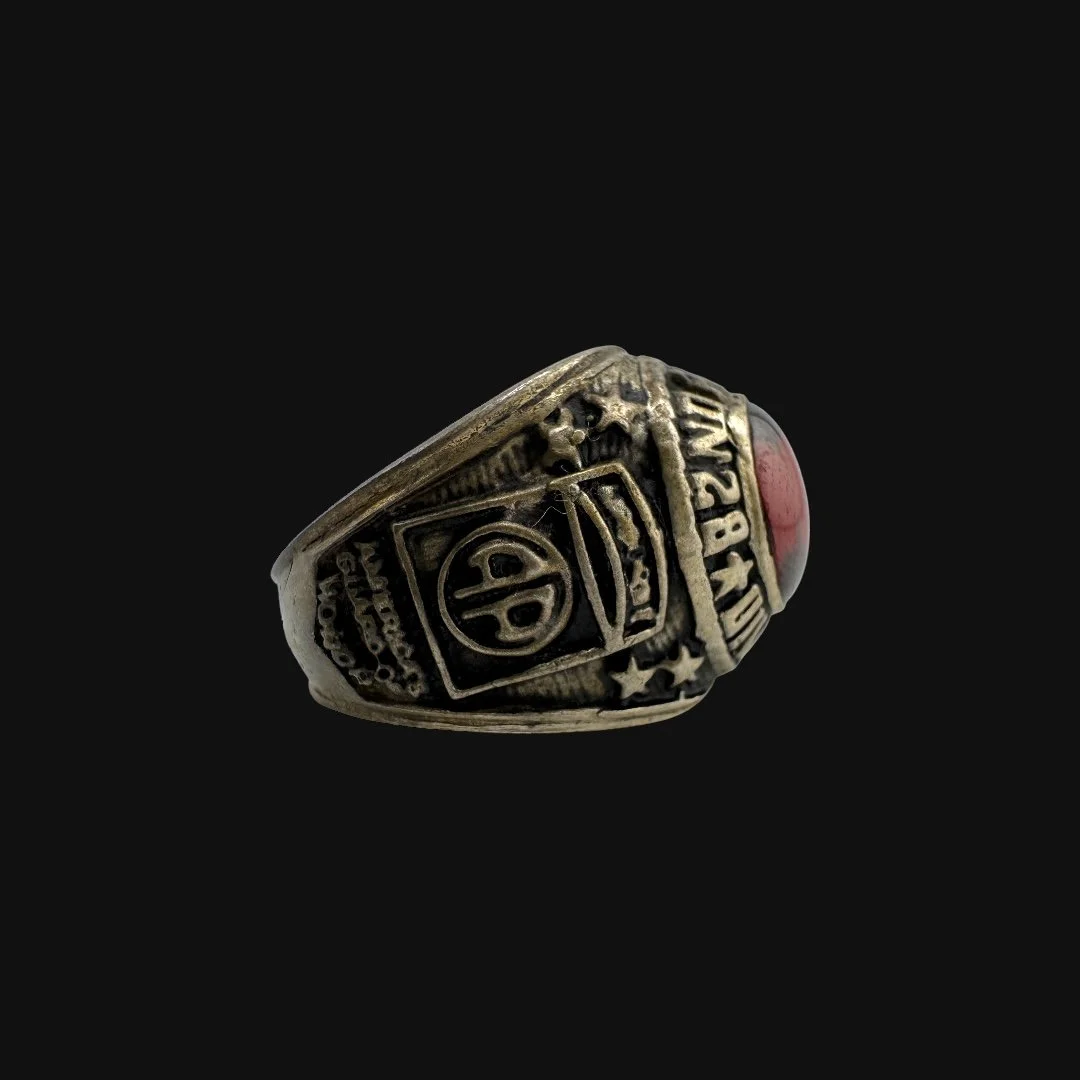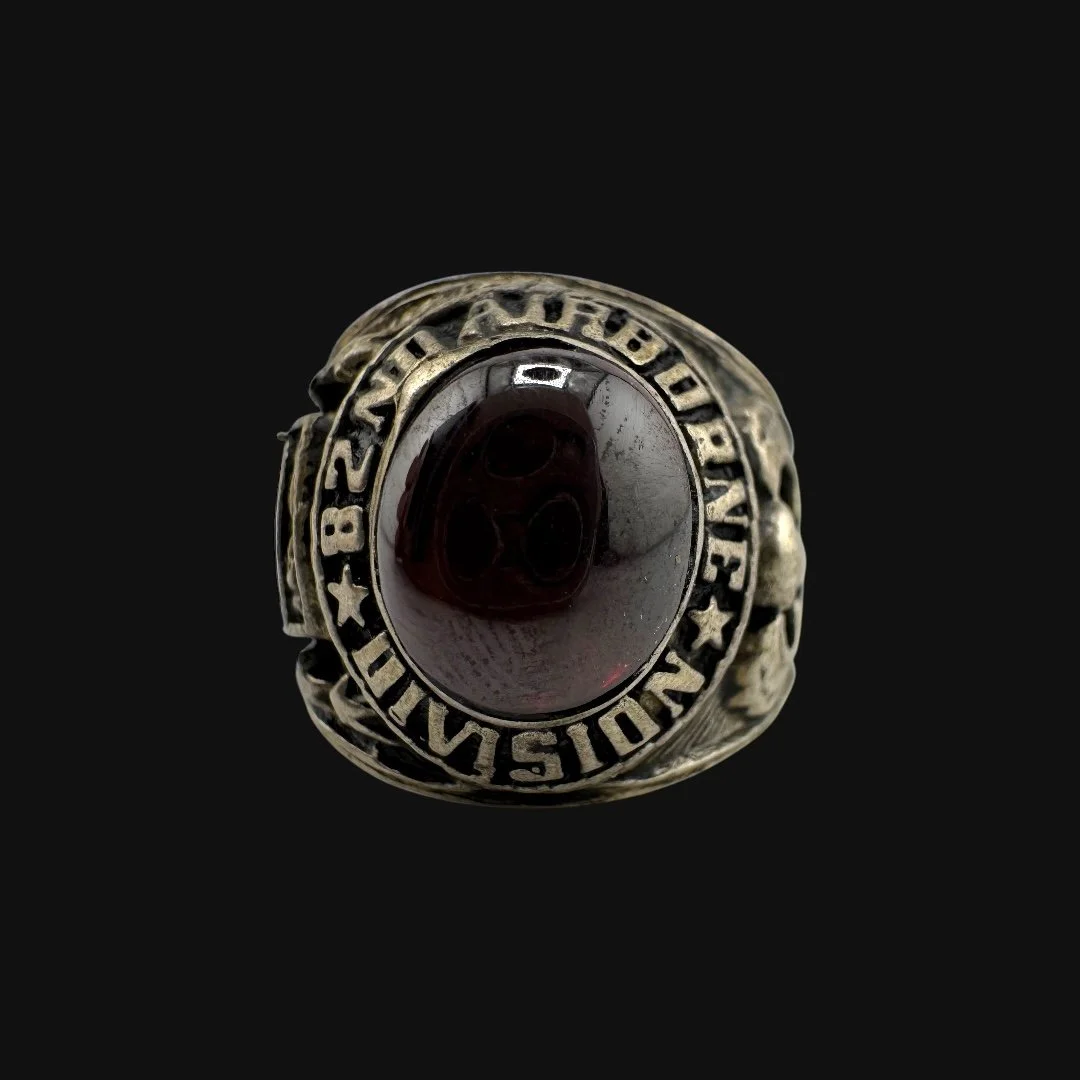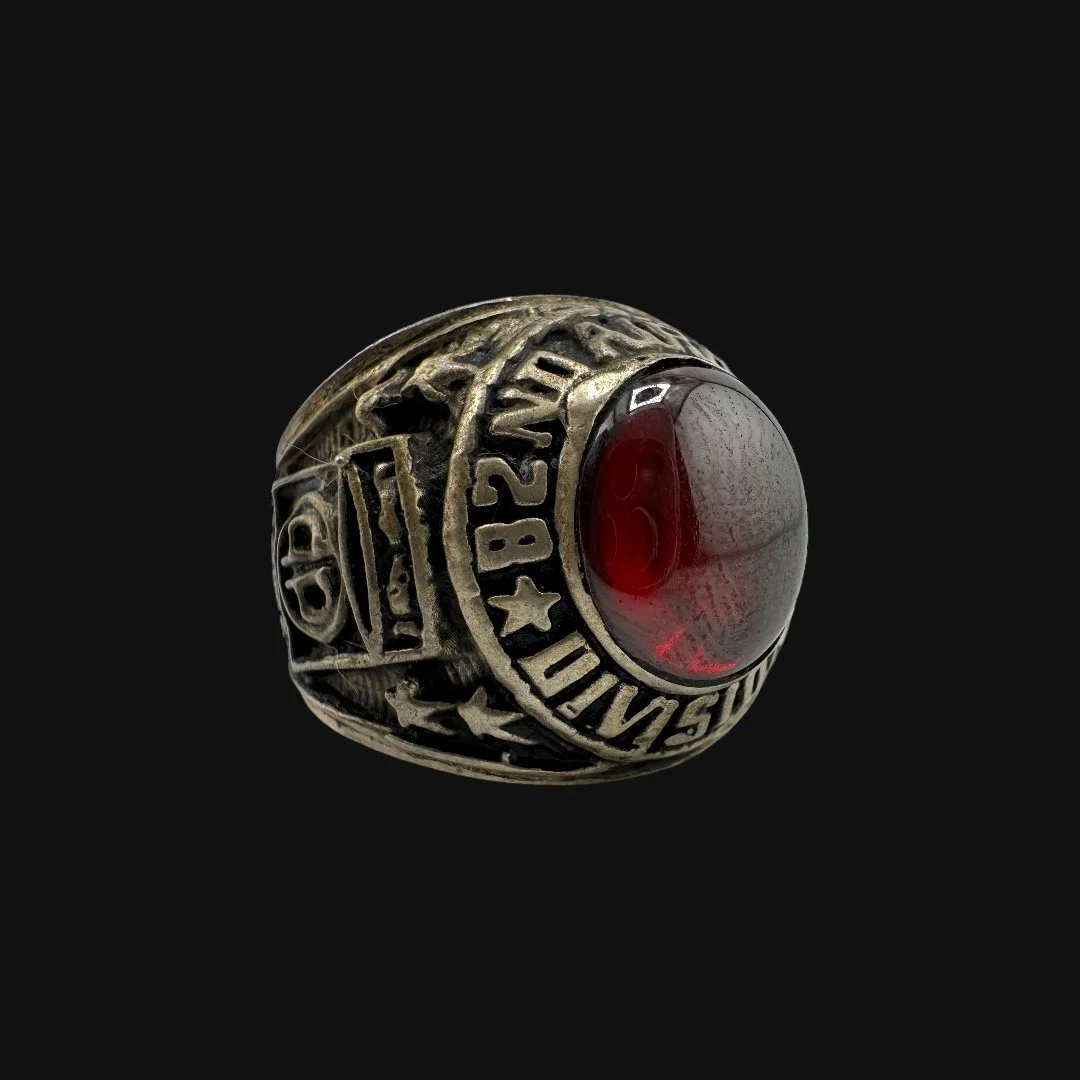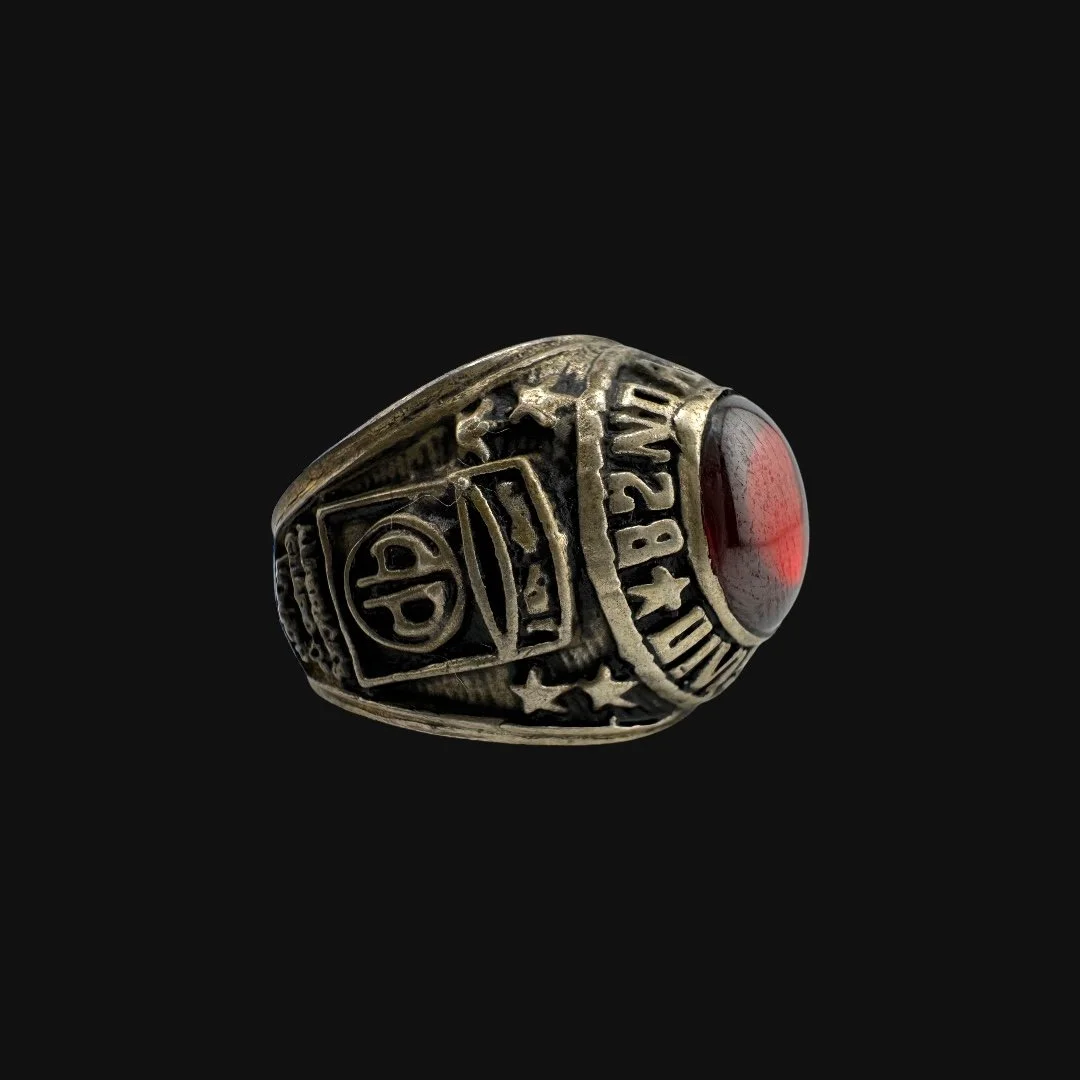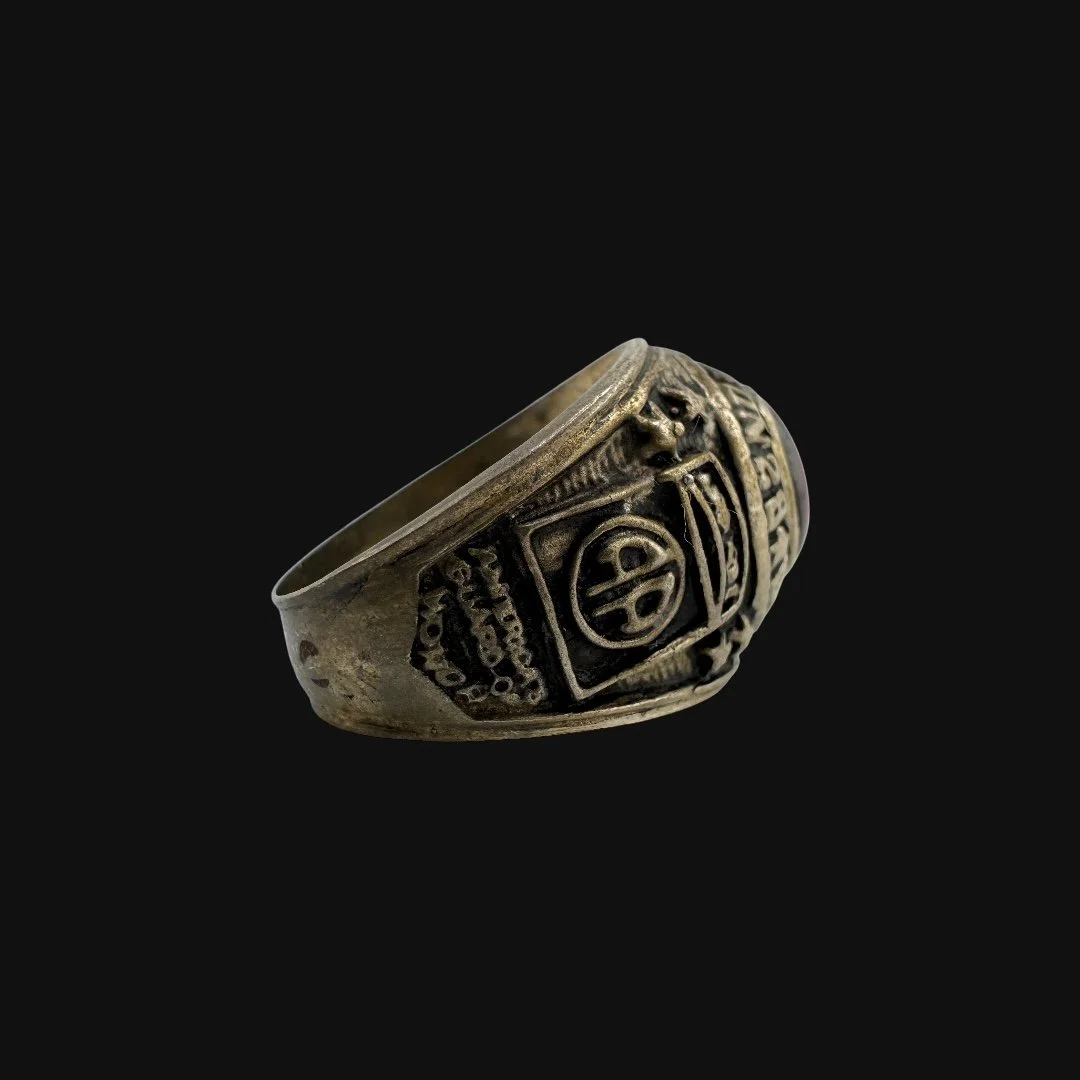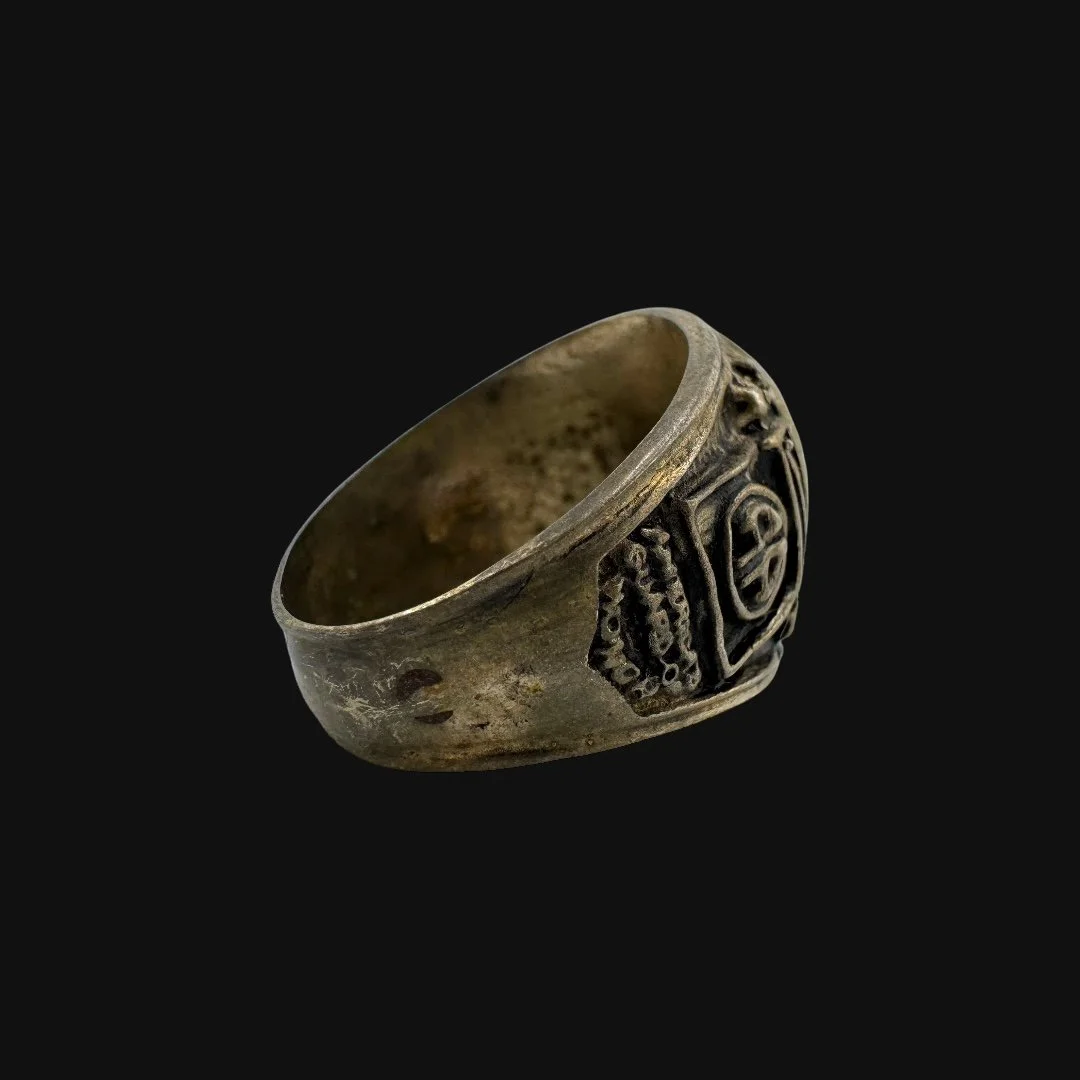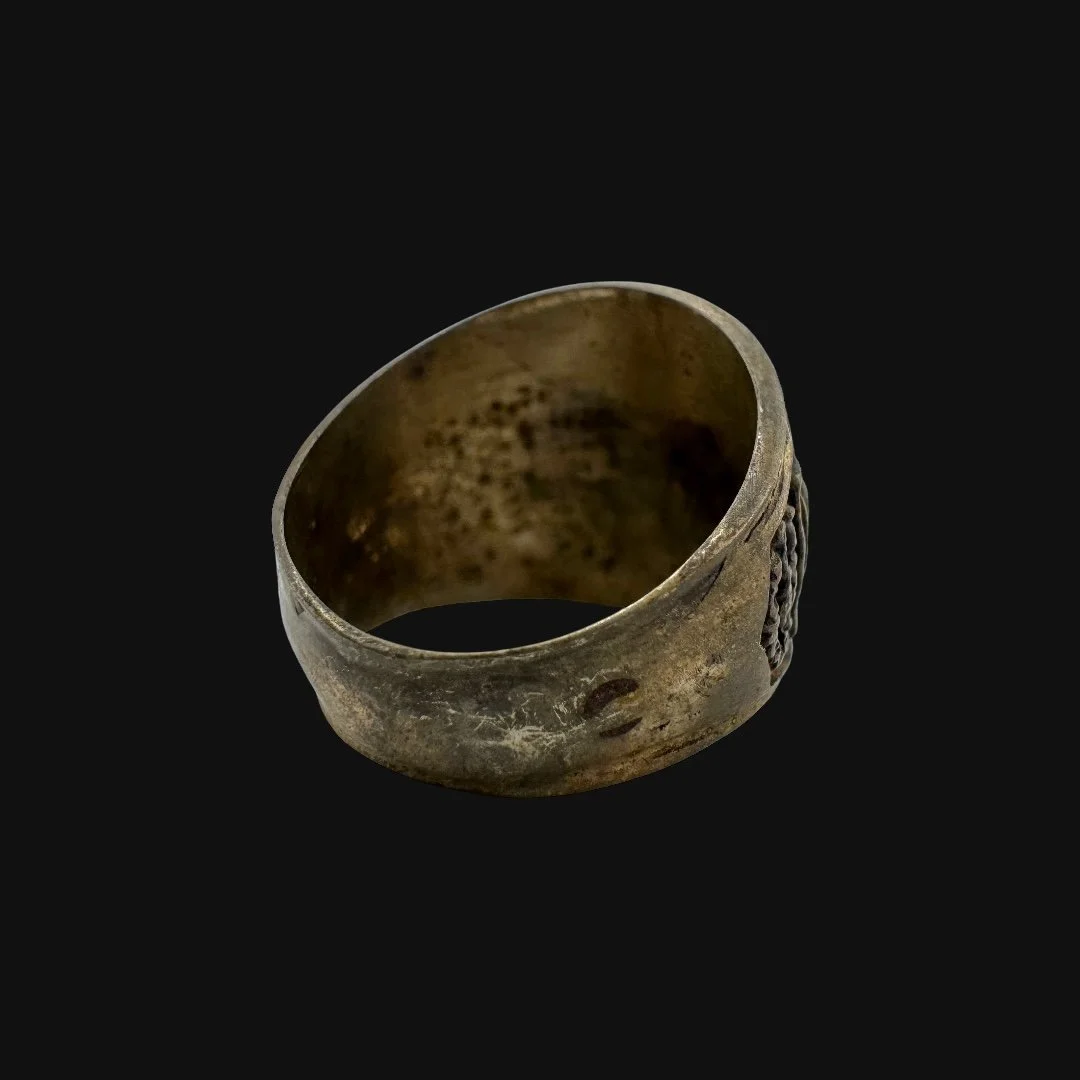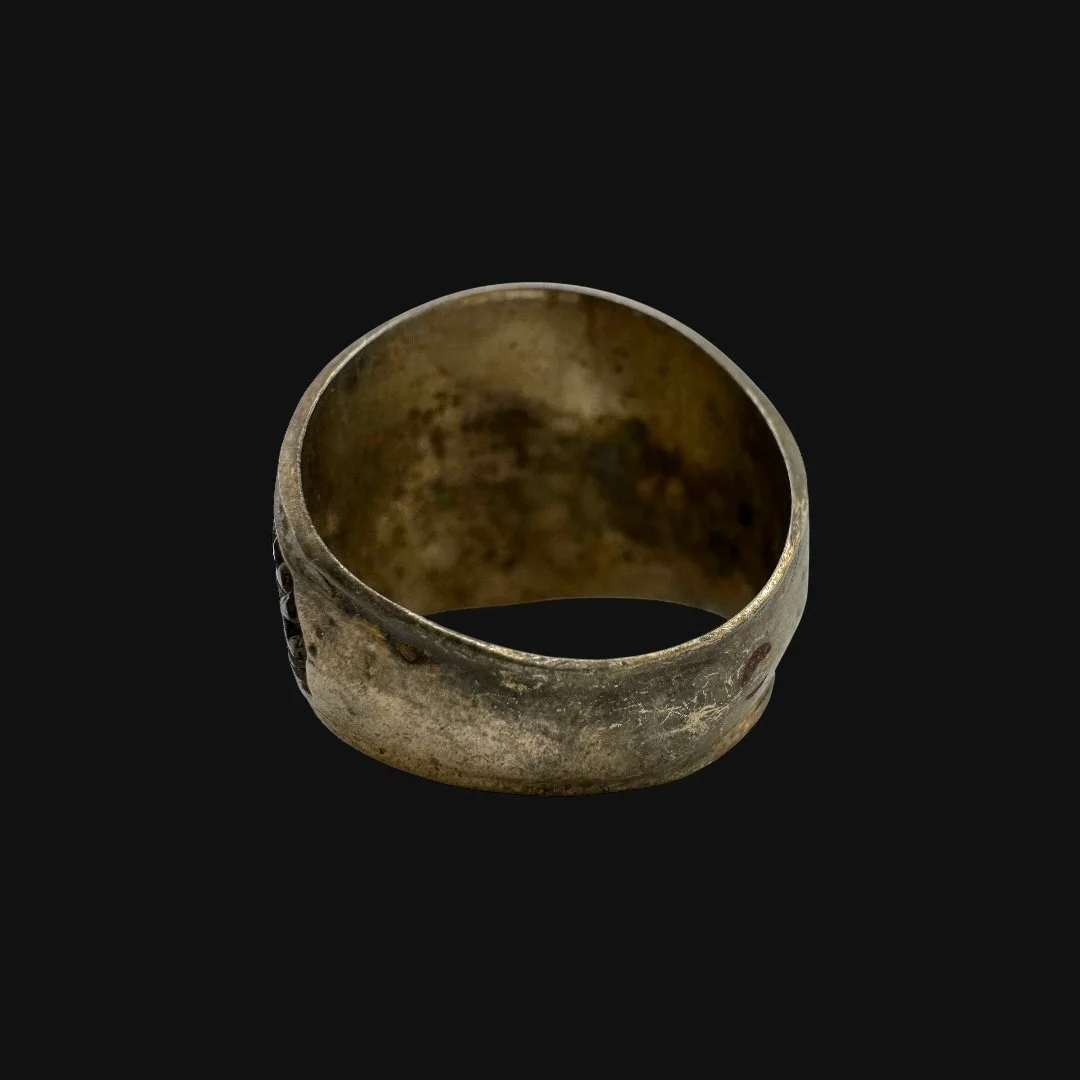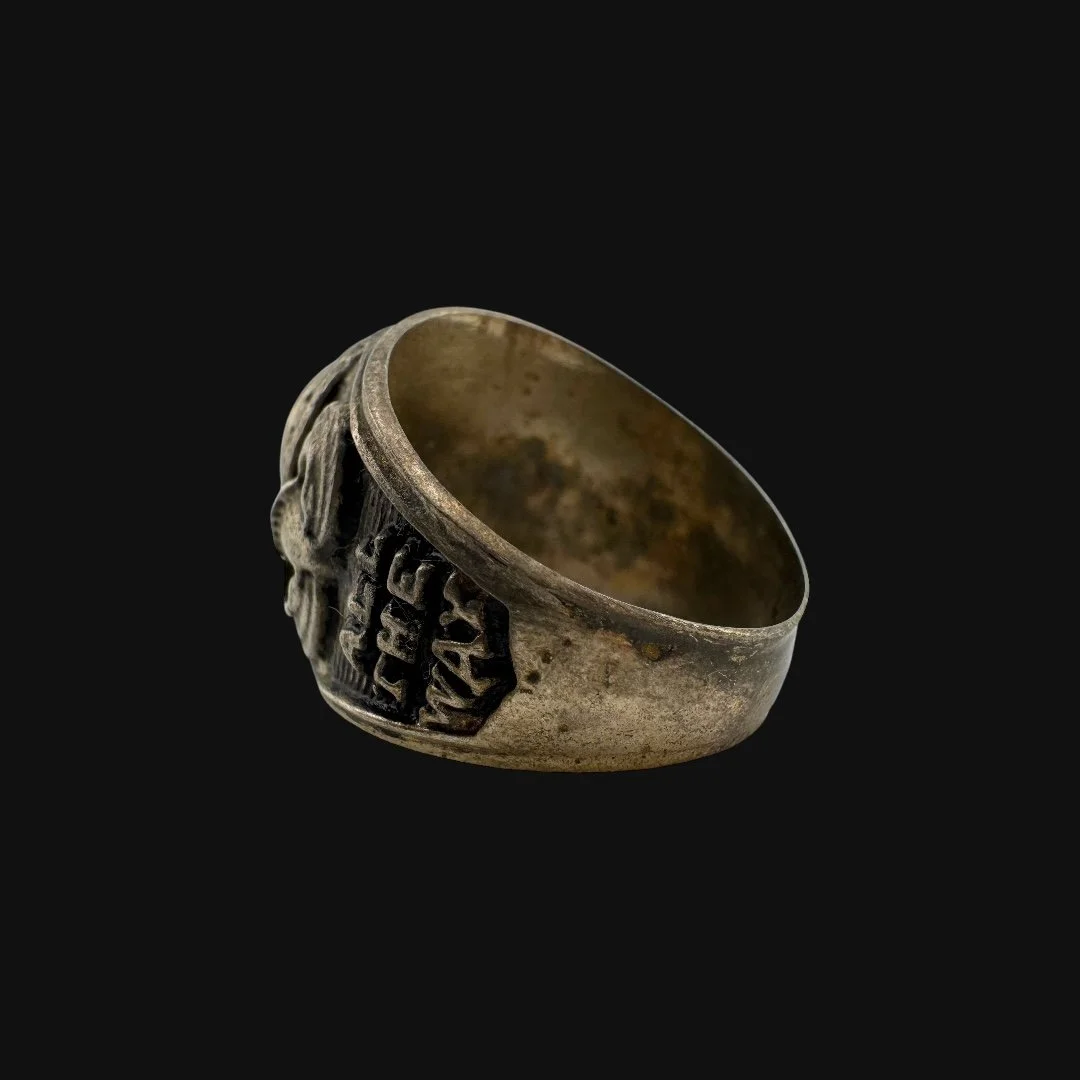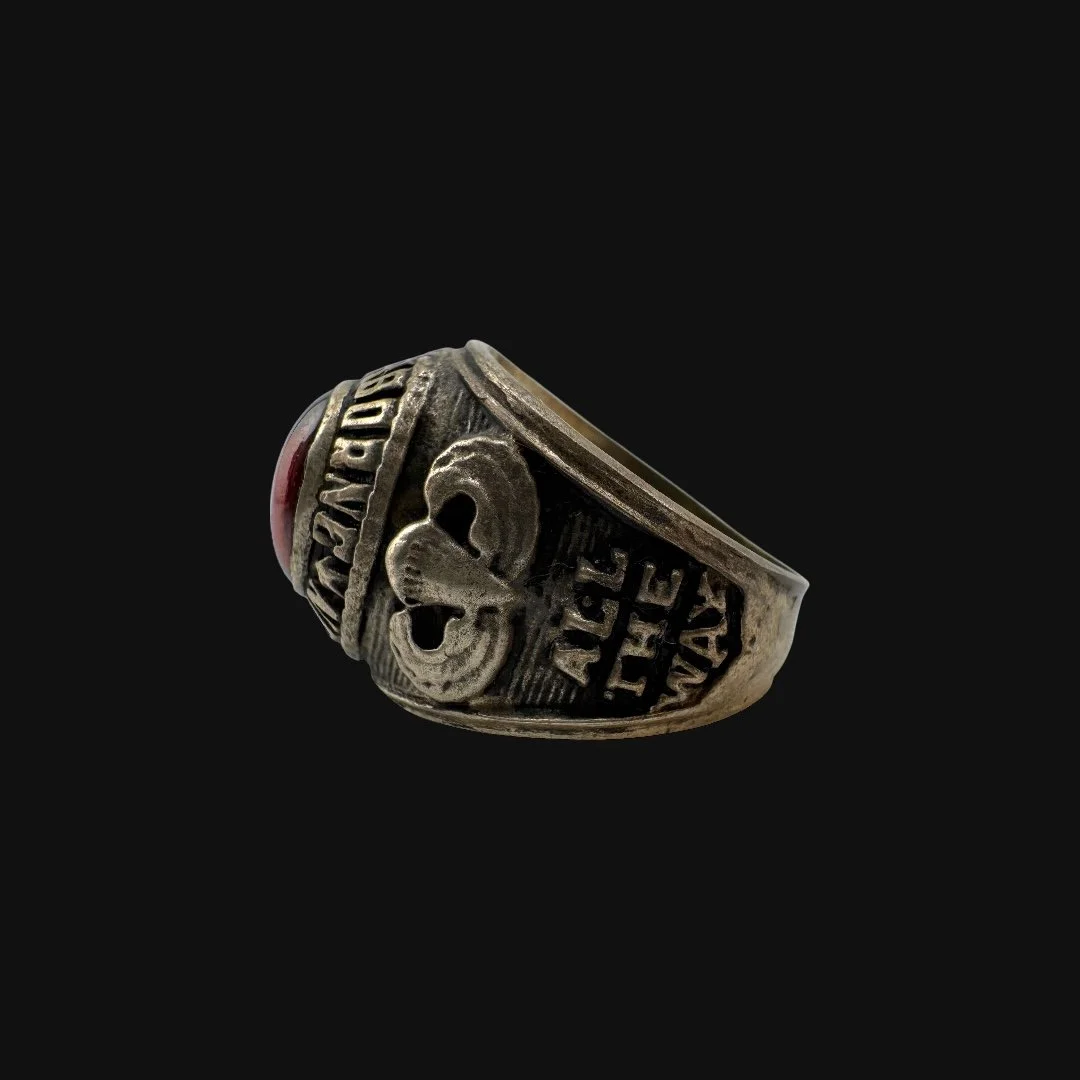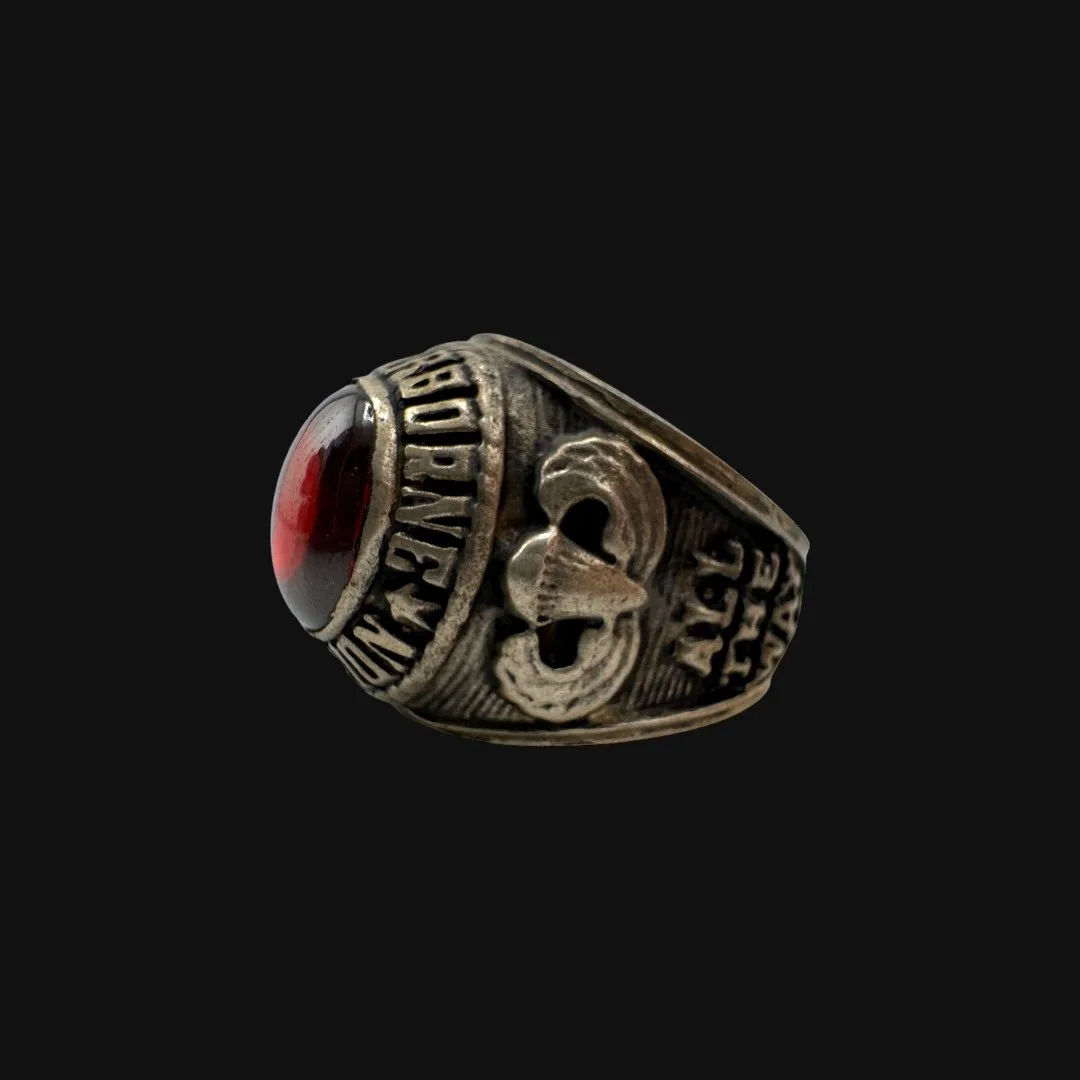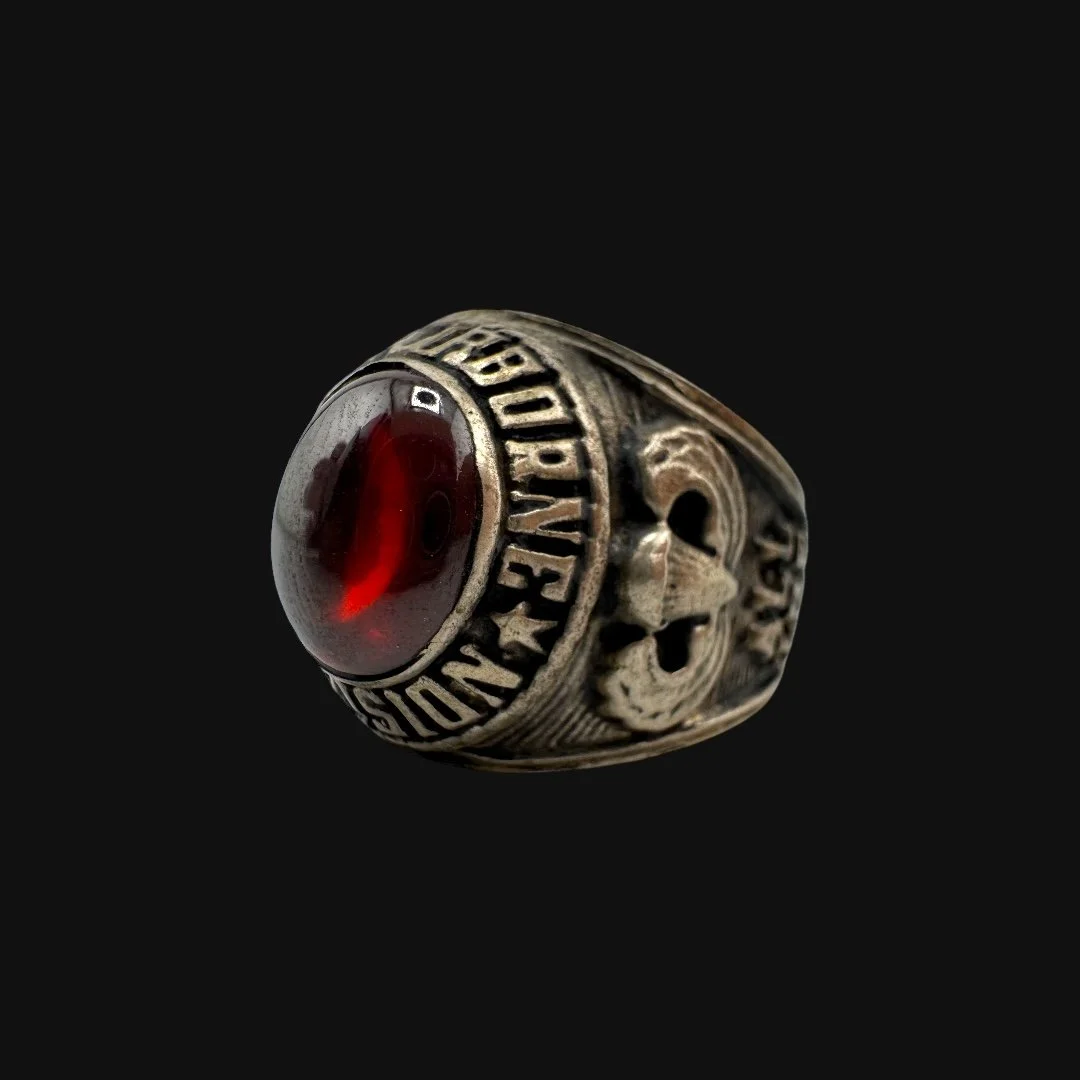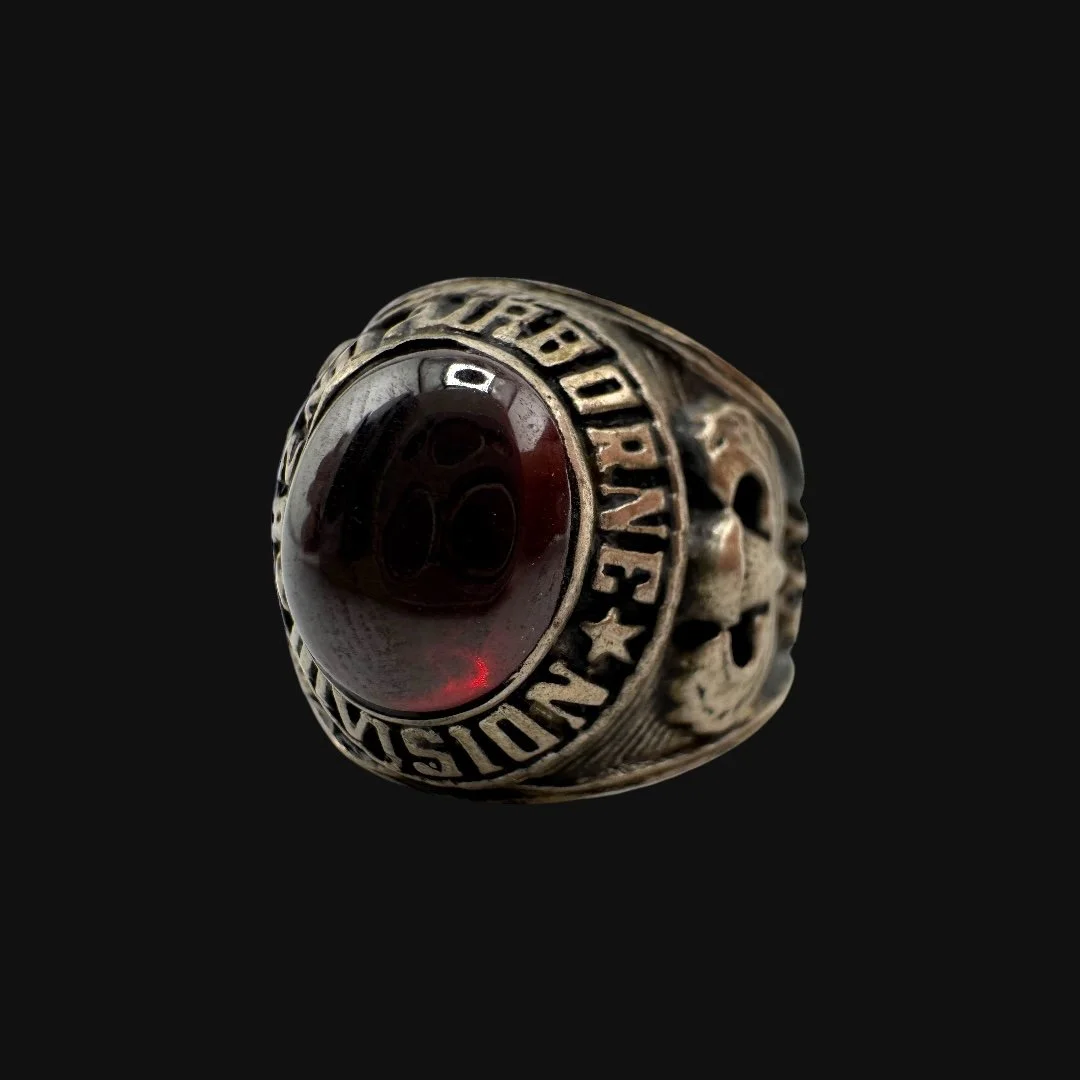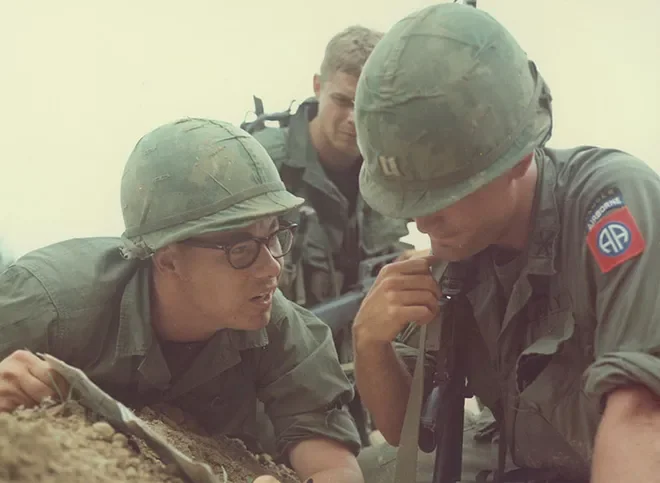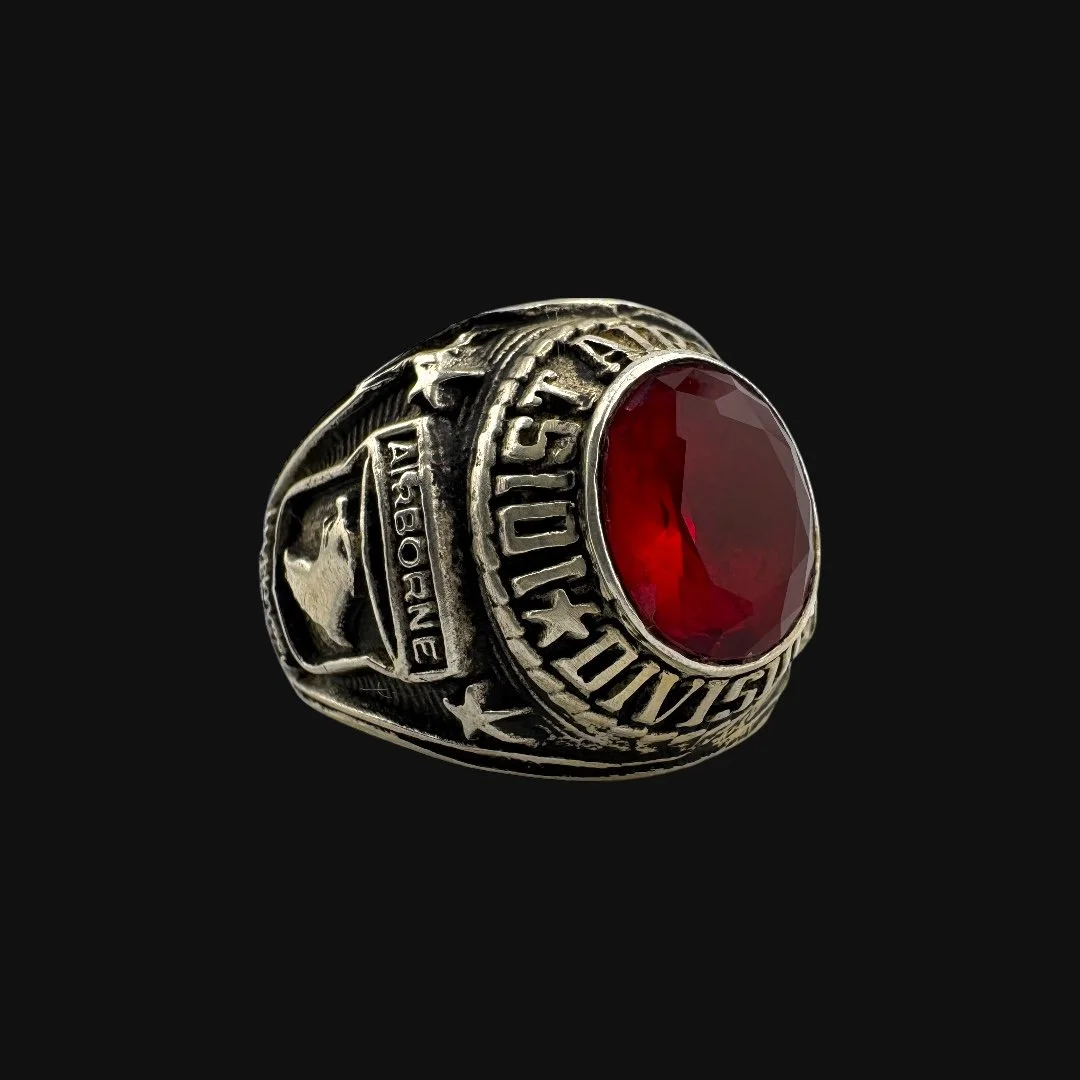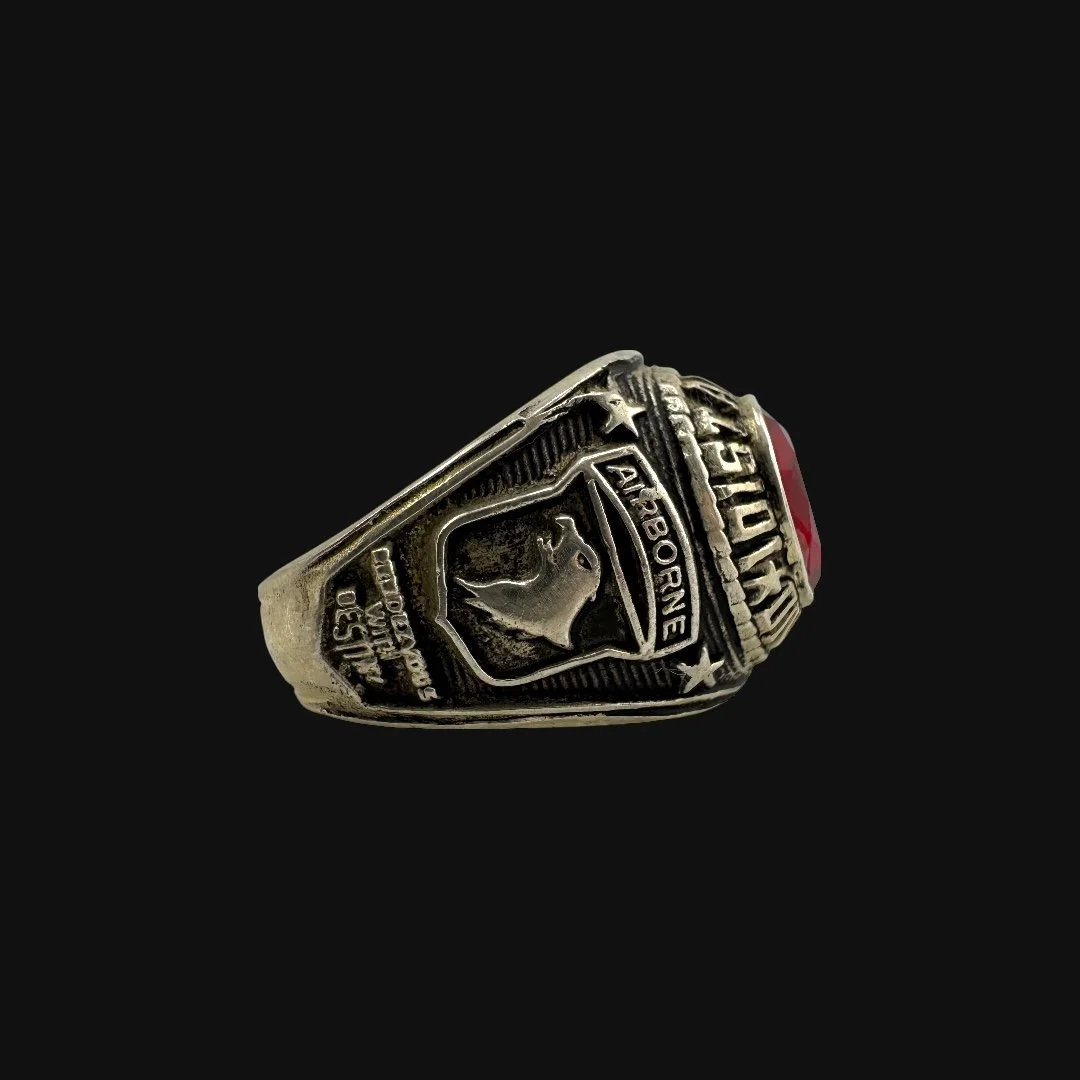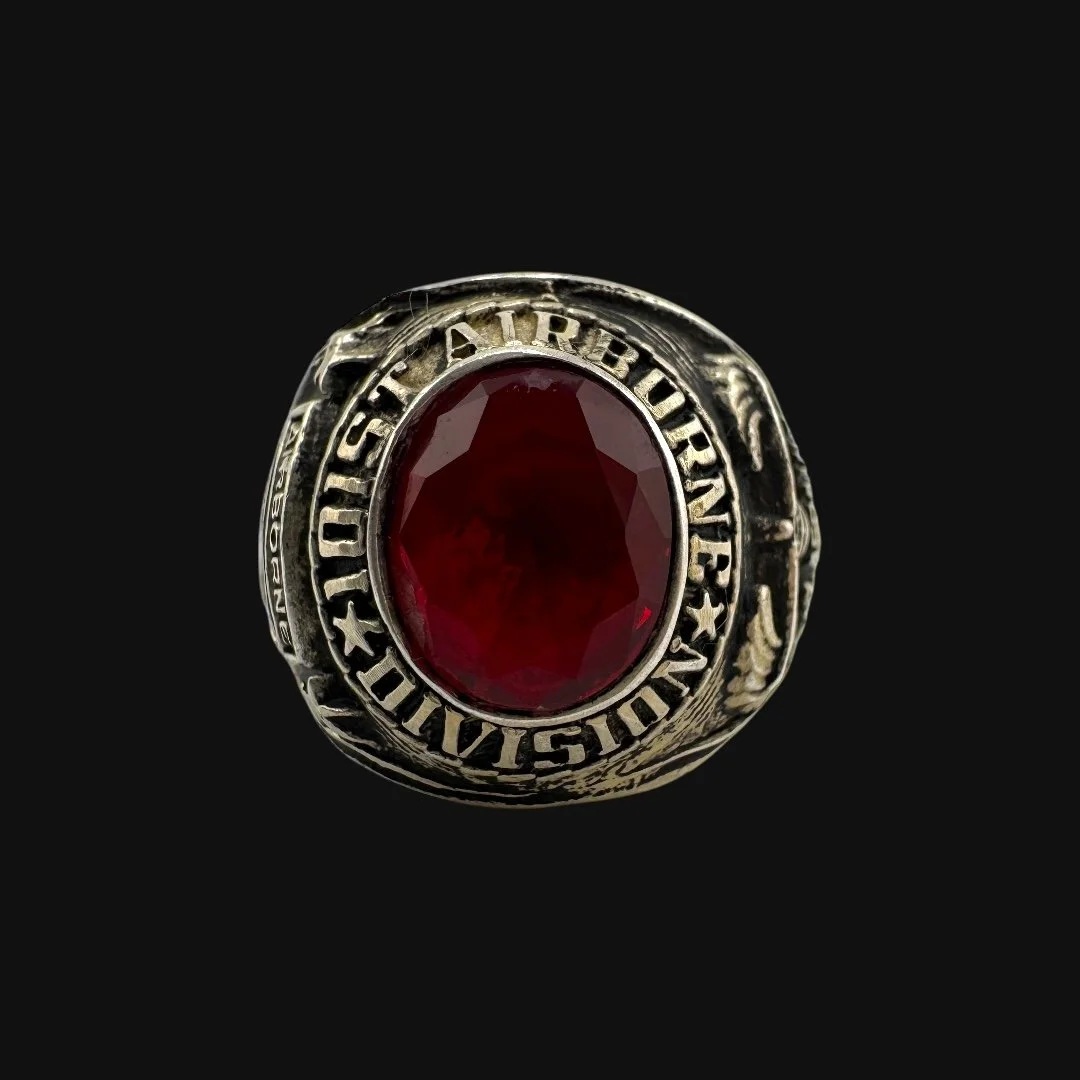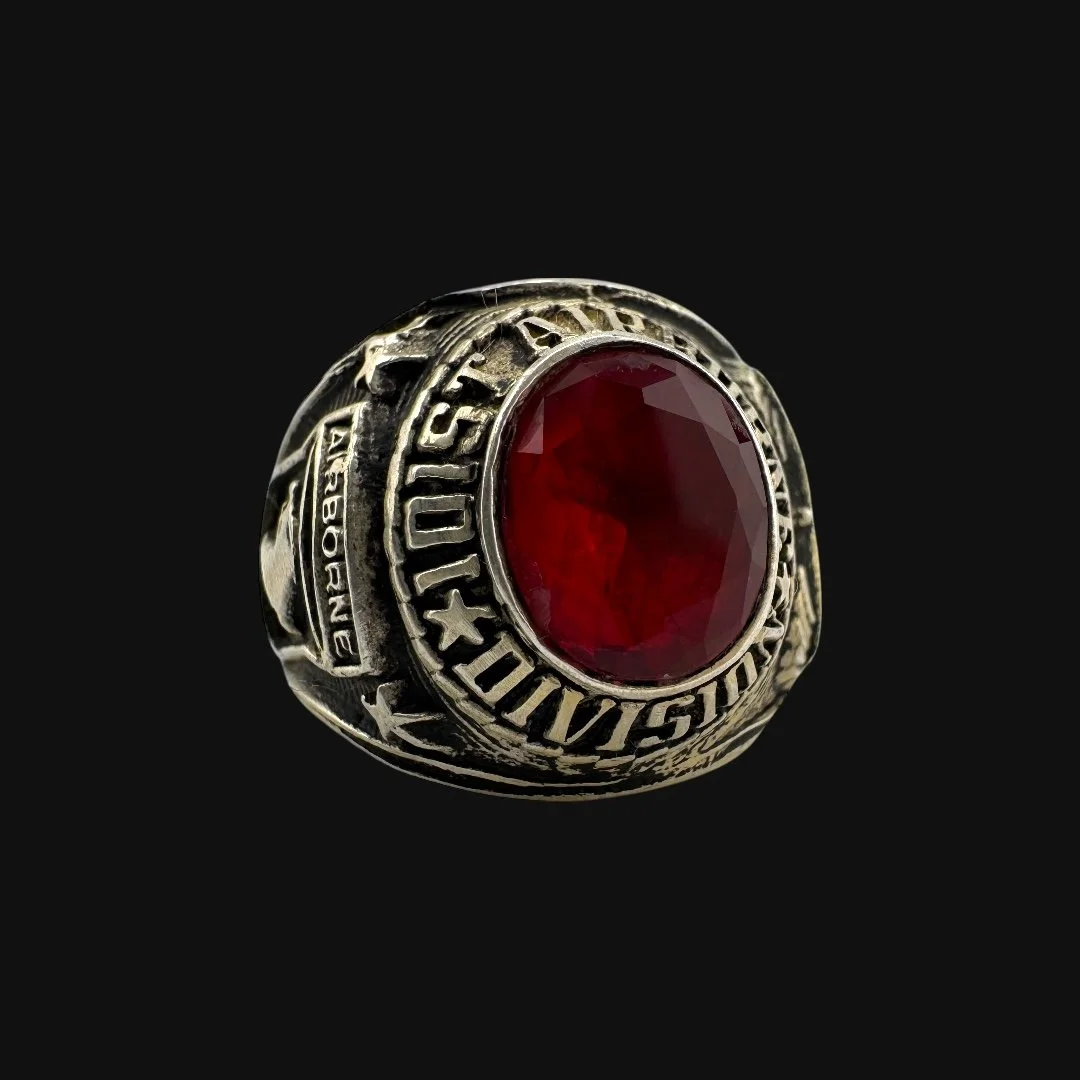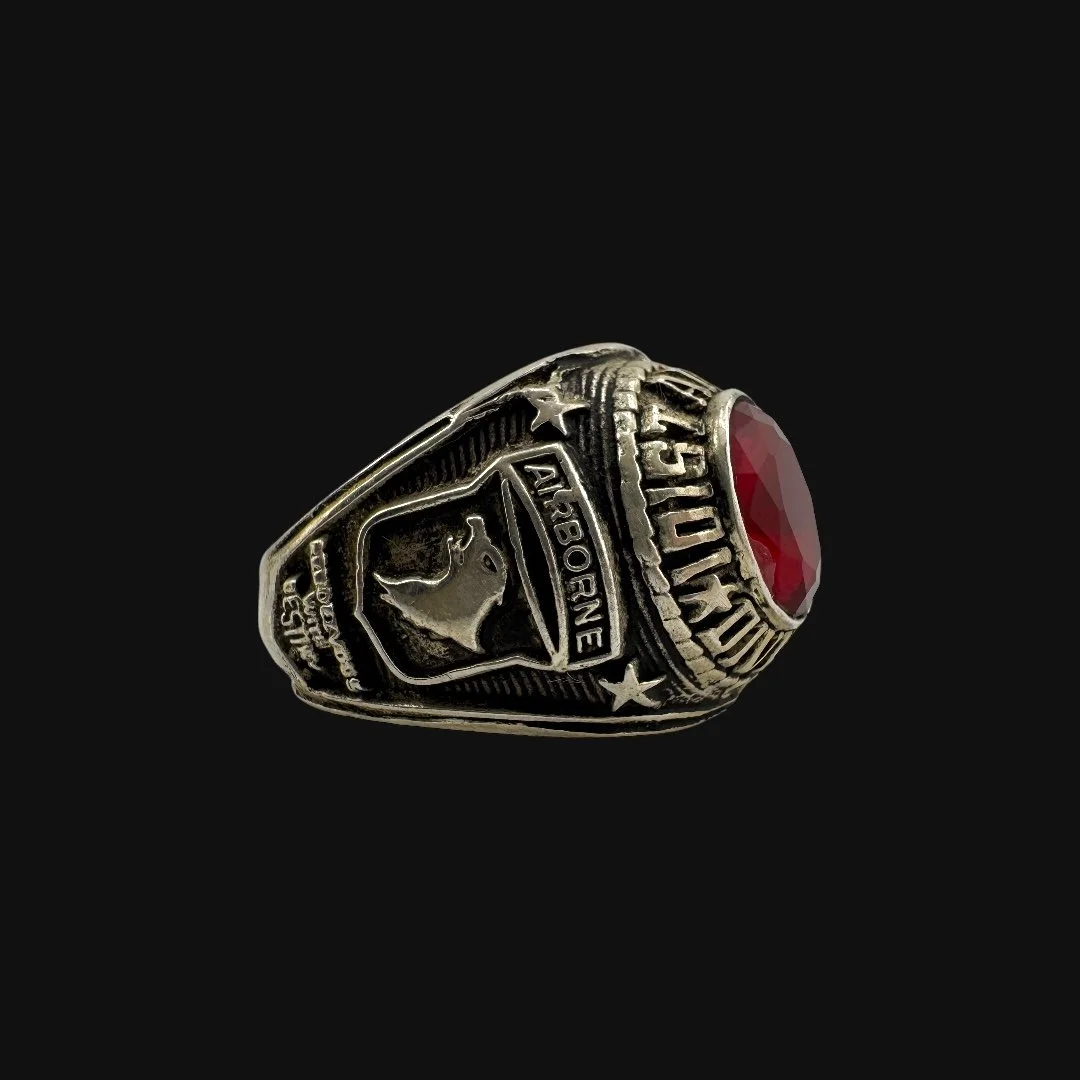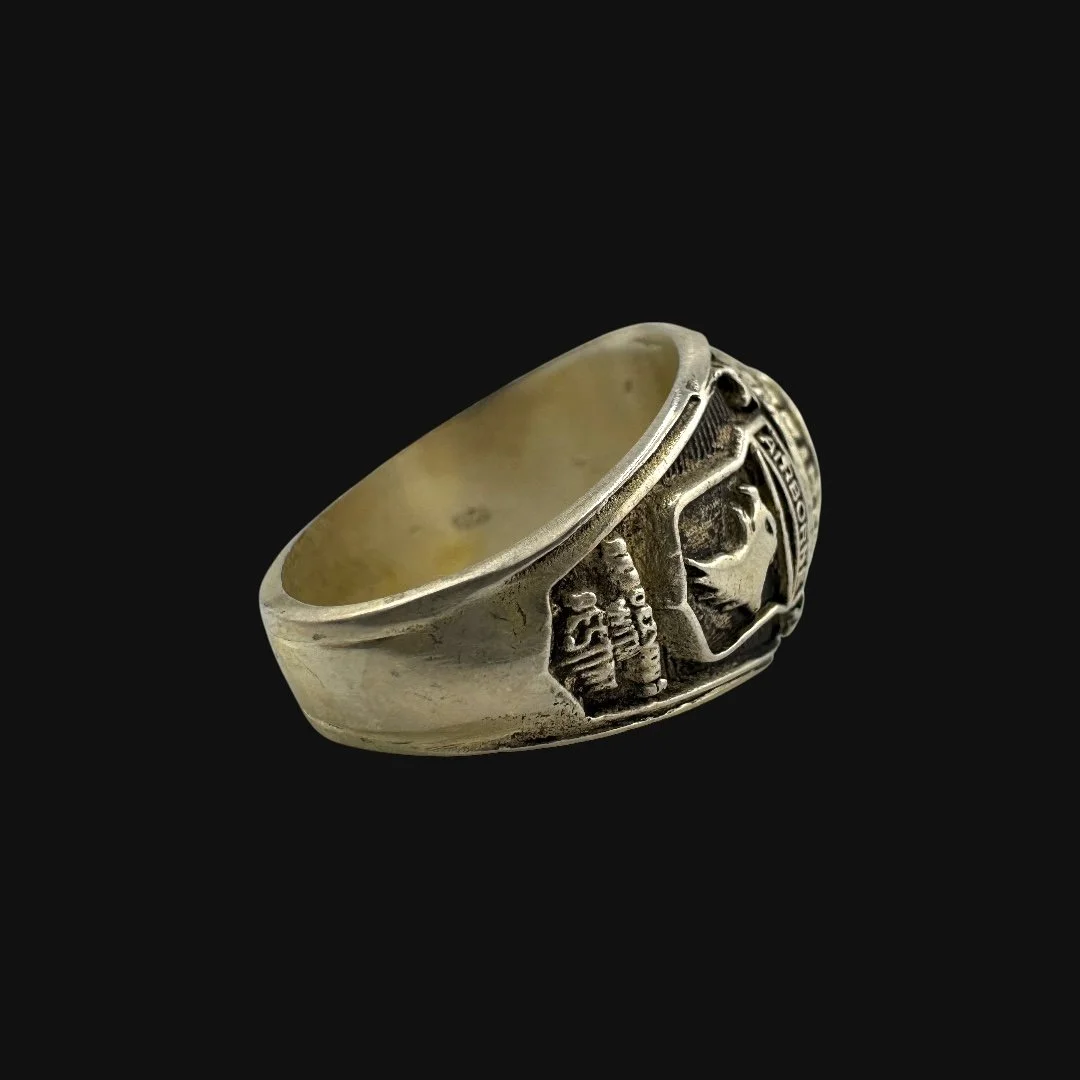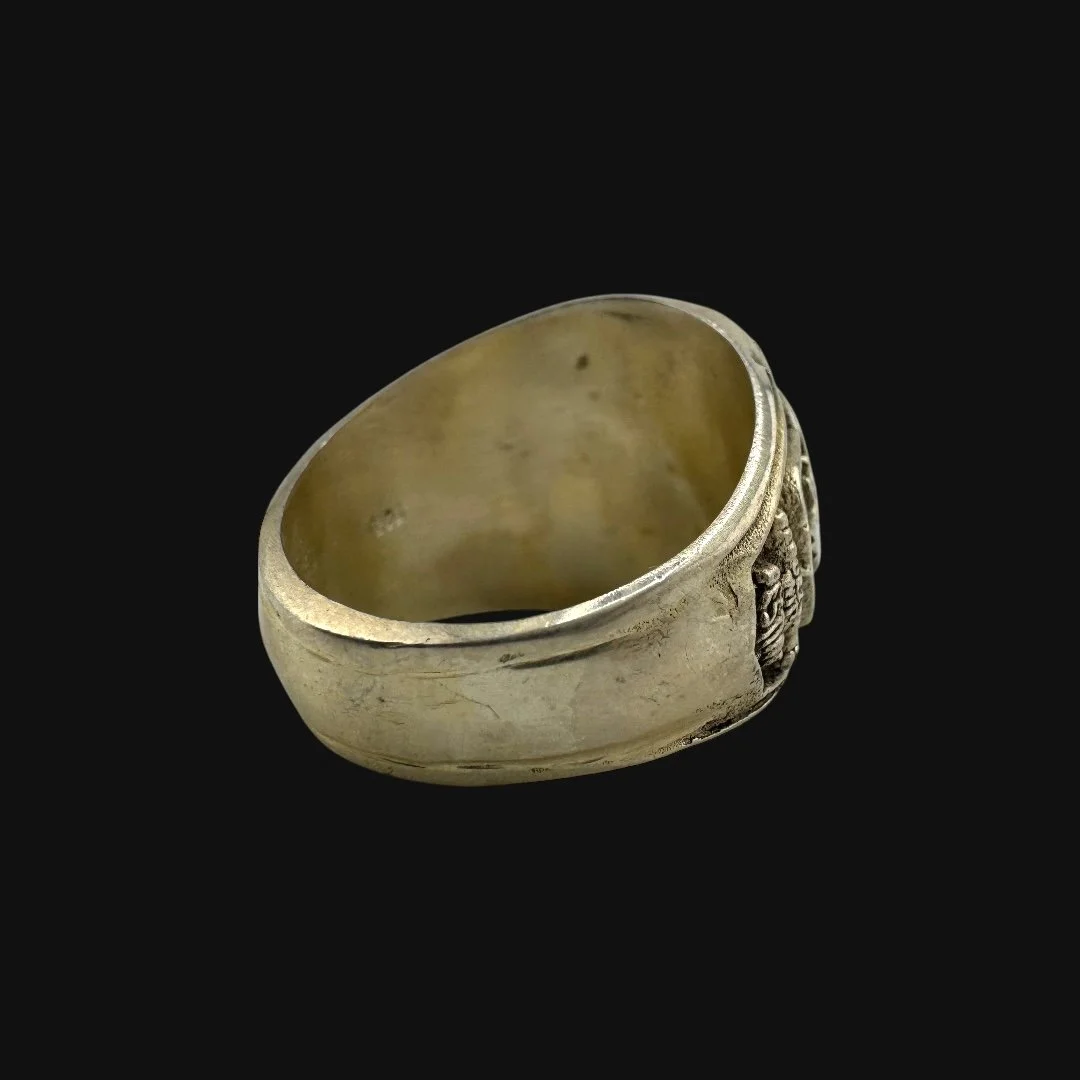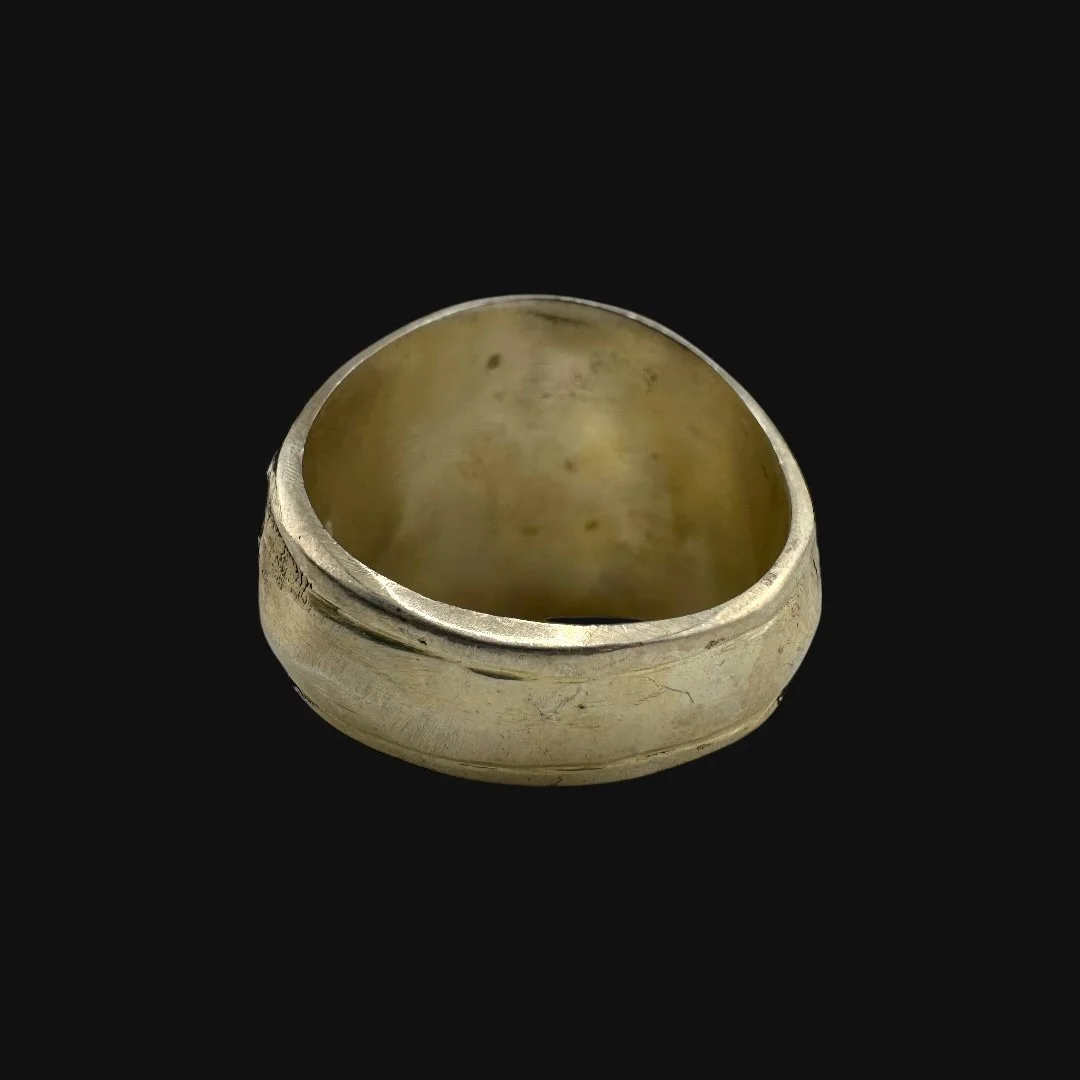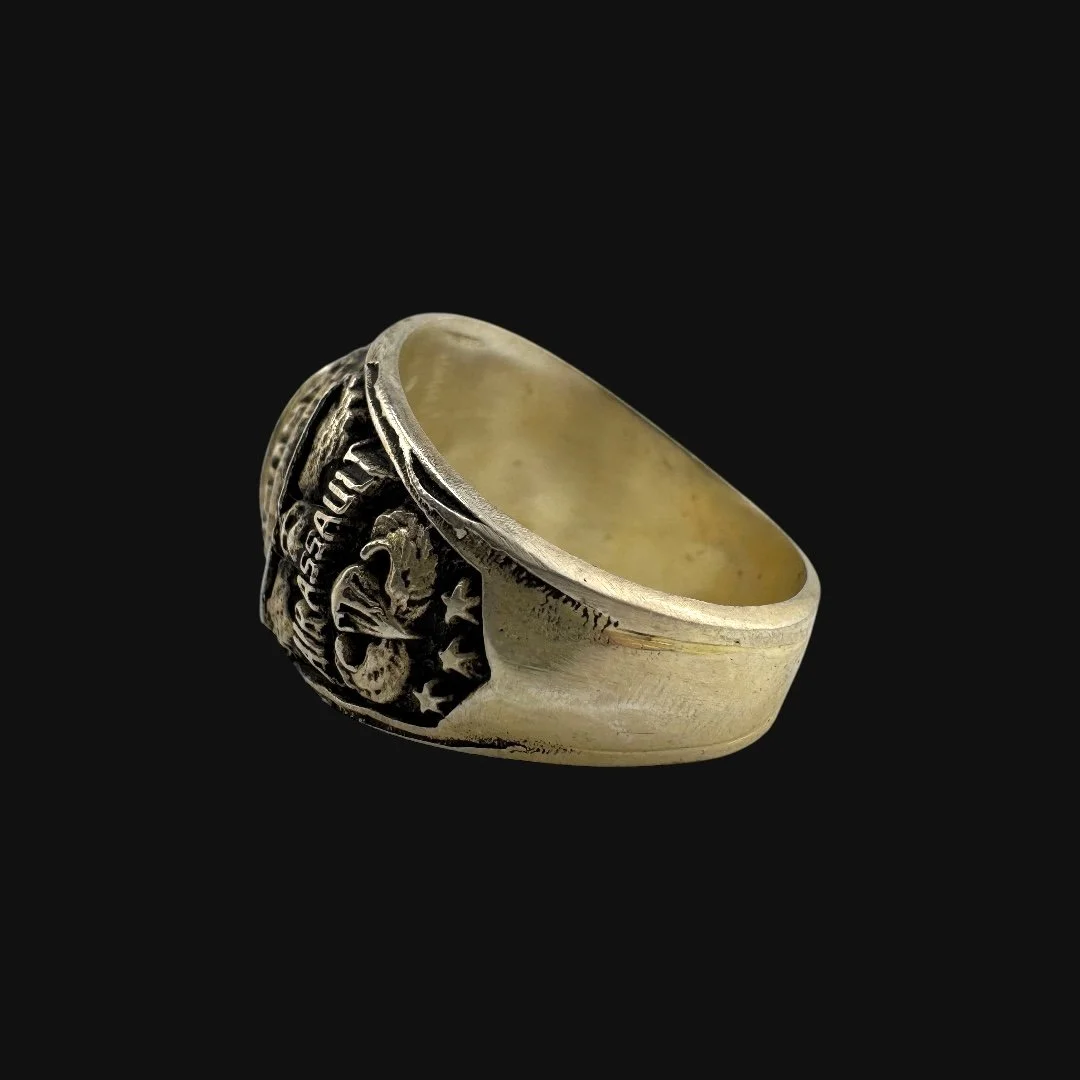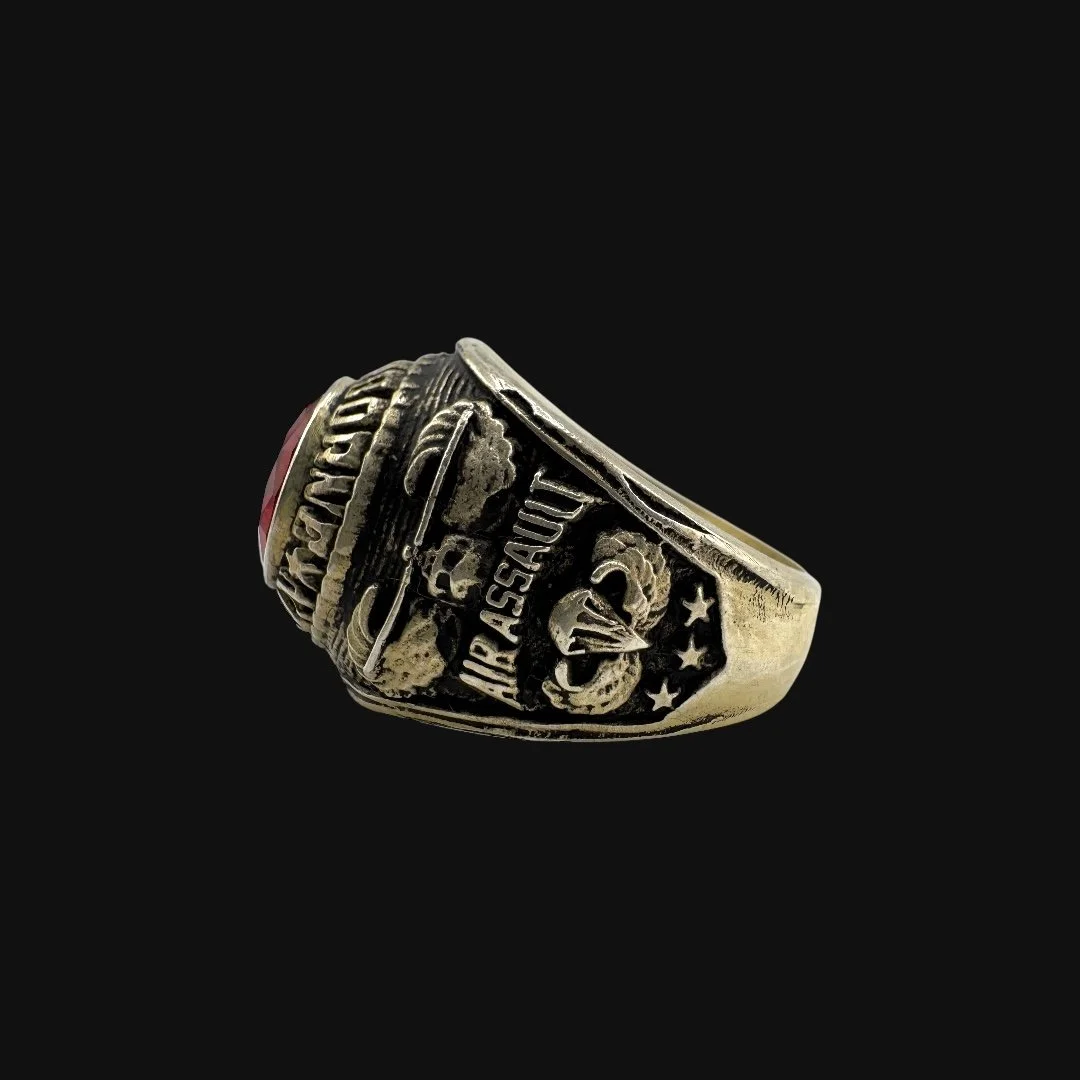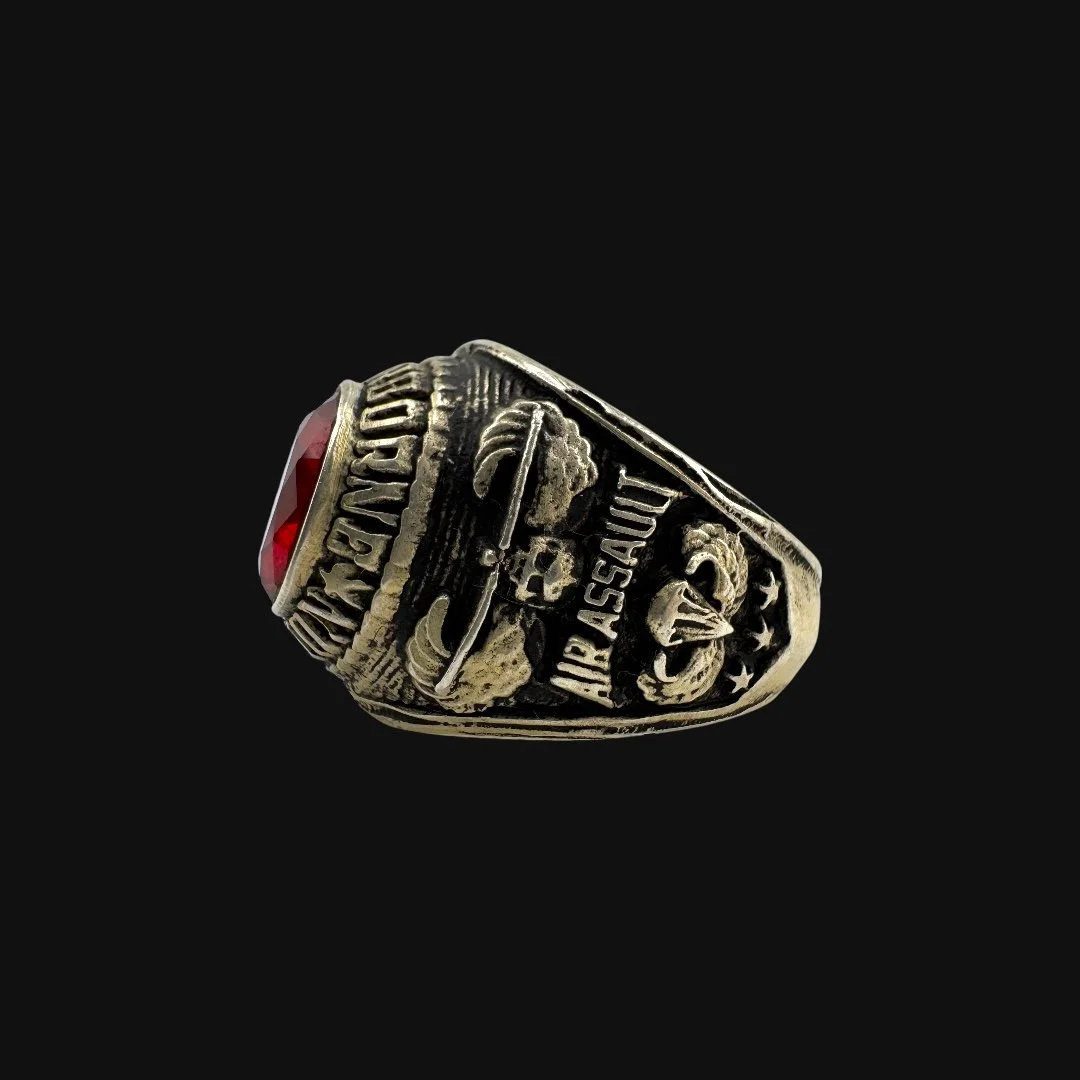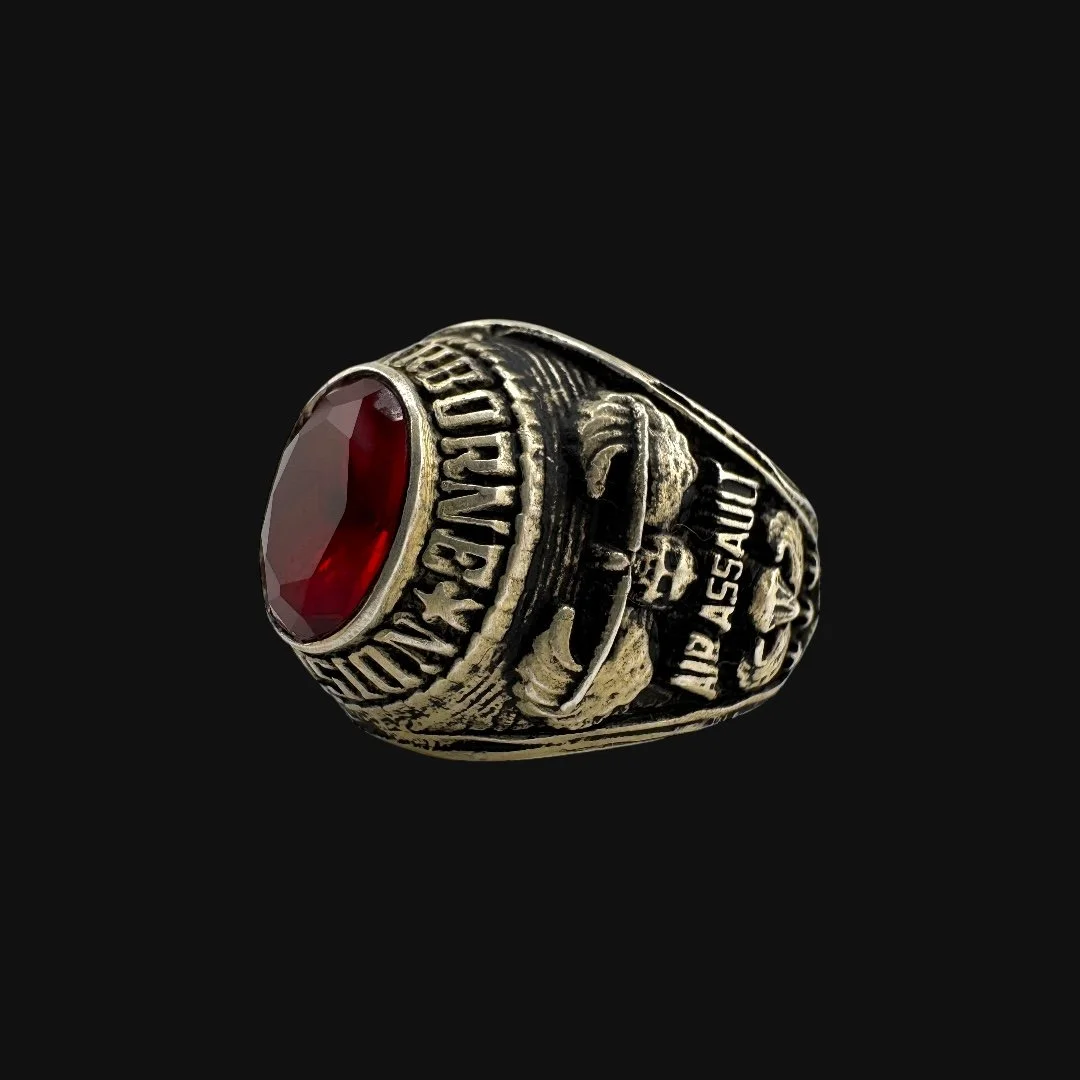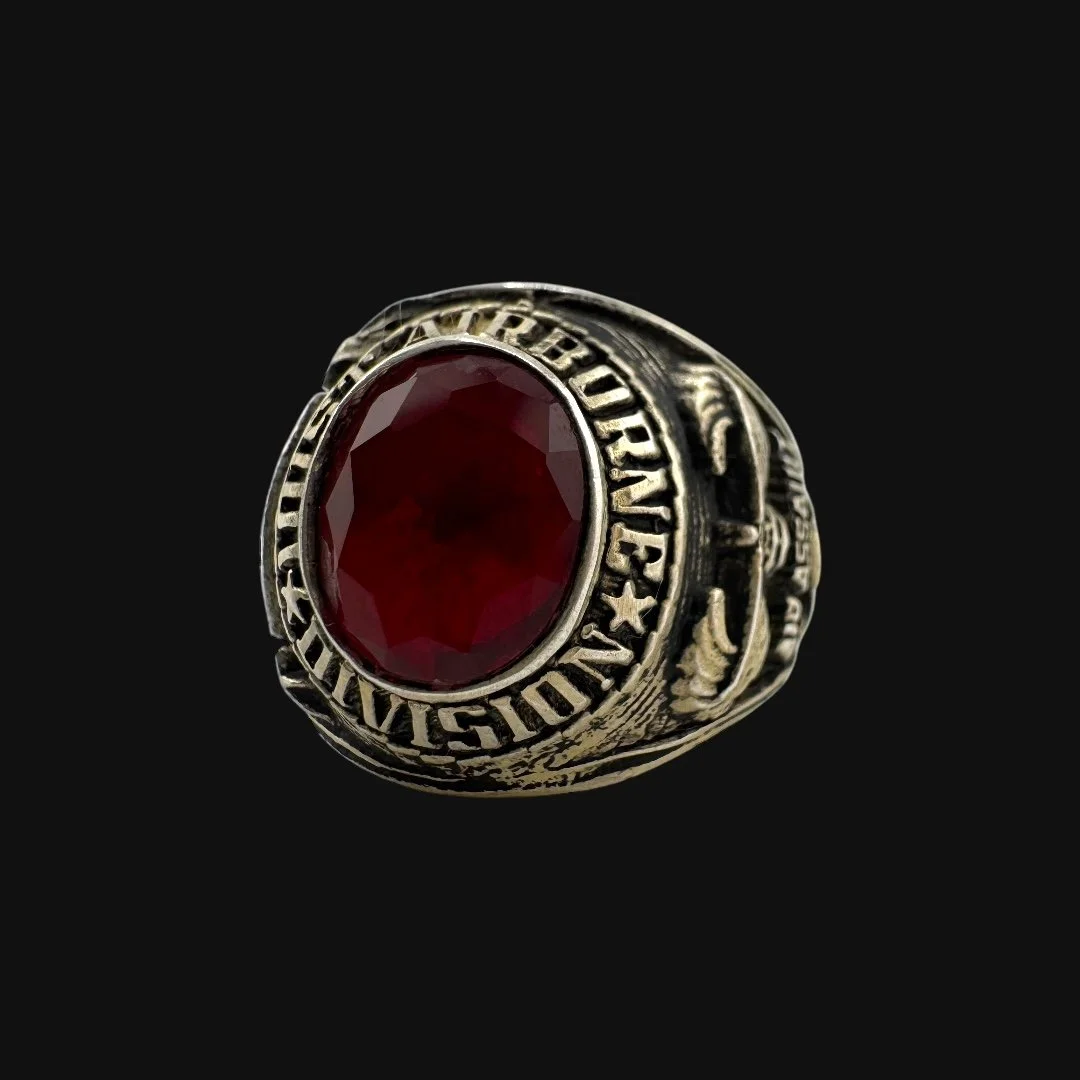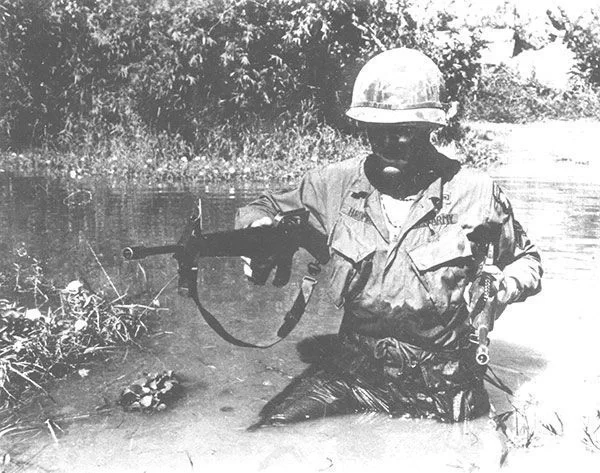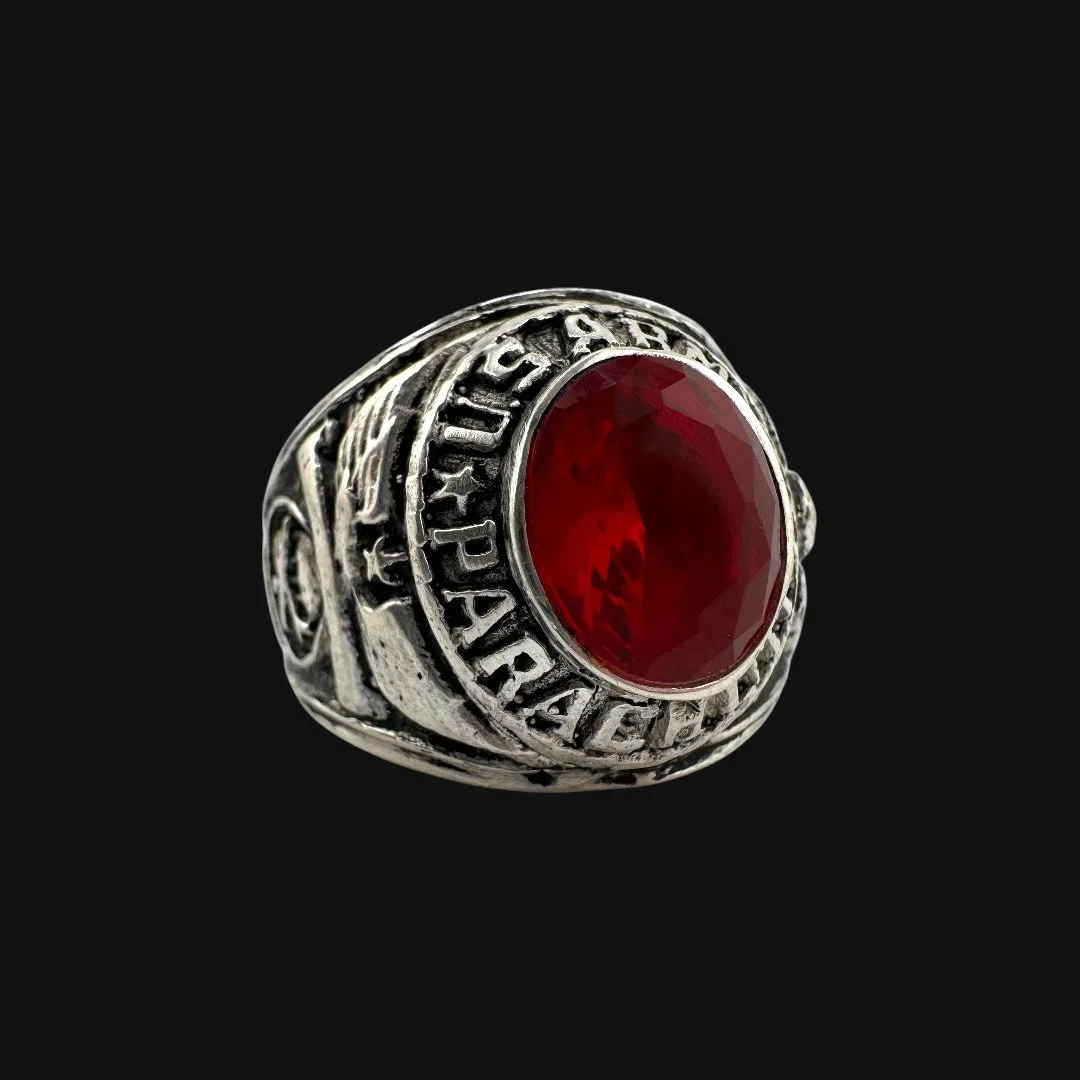 Image 1 of 14
Image 1 of 14

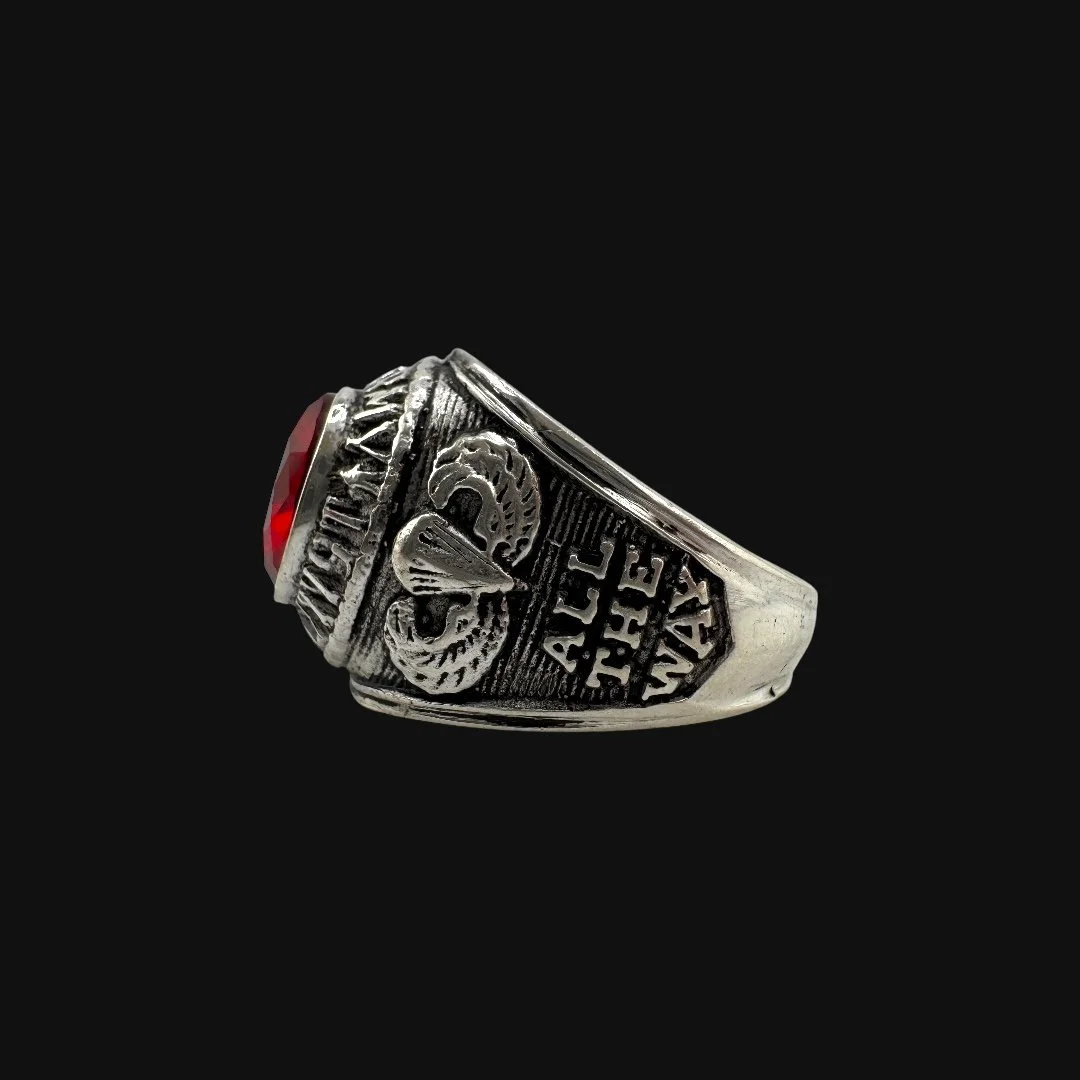 Image 2 of 14
Image 2 of 14

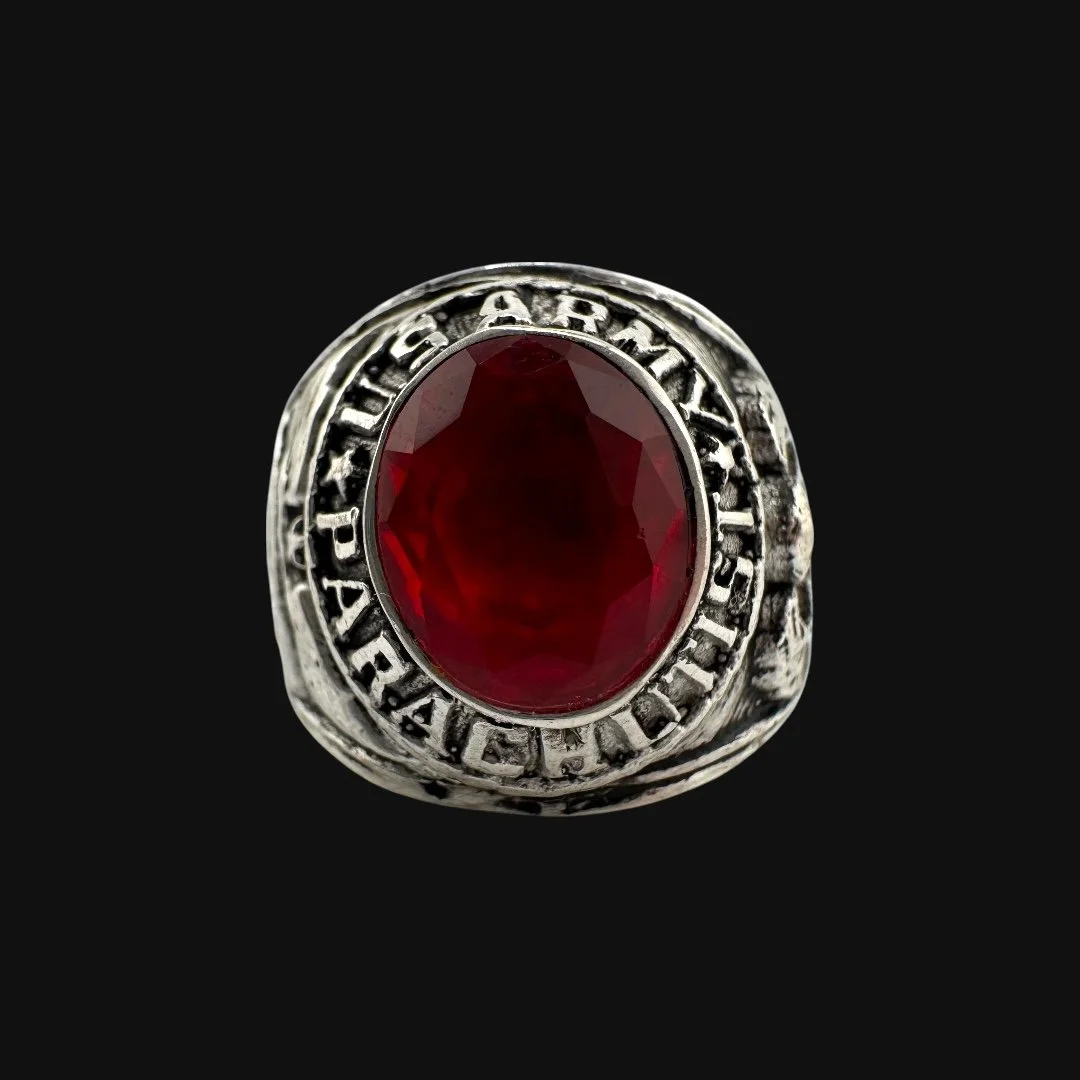 Image 3 of 14
Image 3 of 14

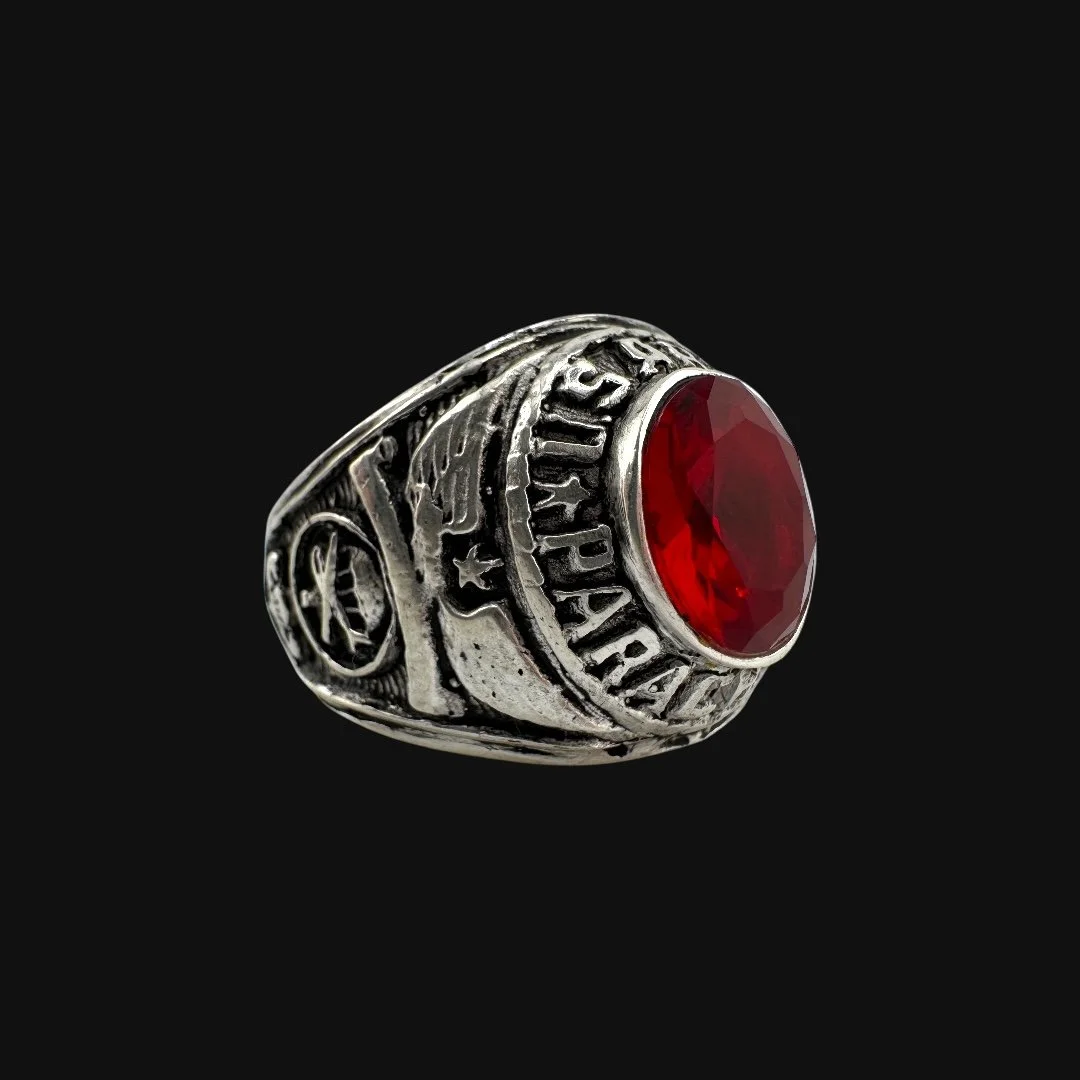 Image 4 of 14
Image 4 of 14

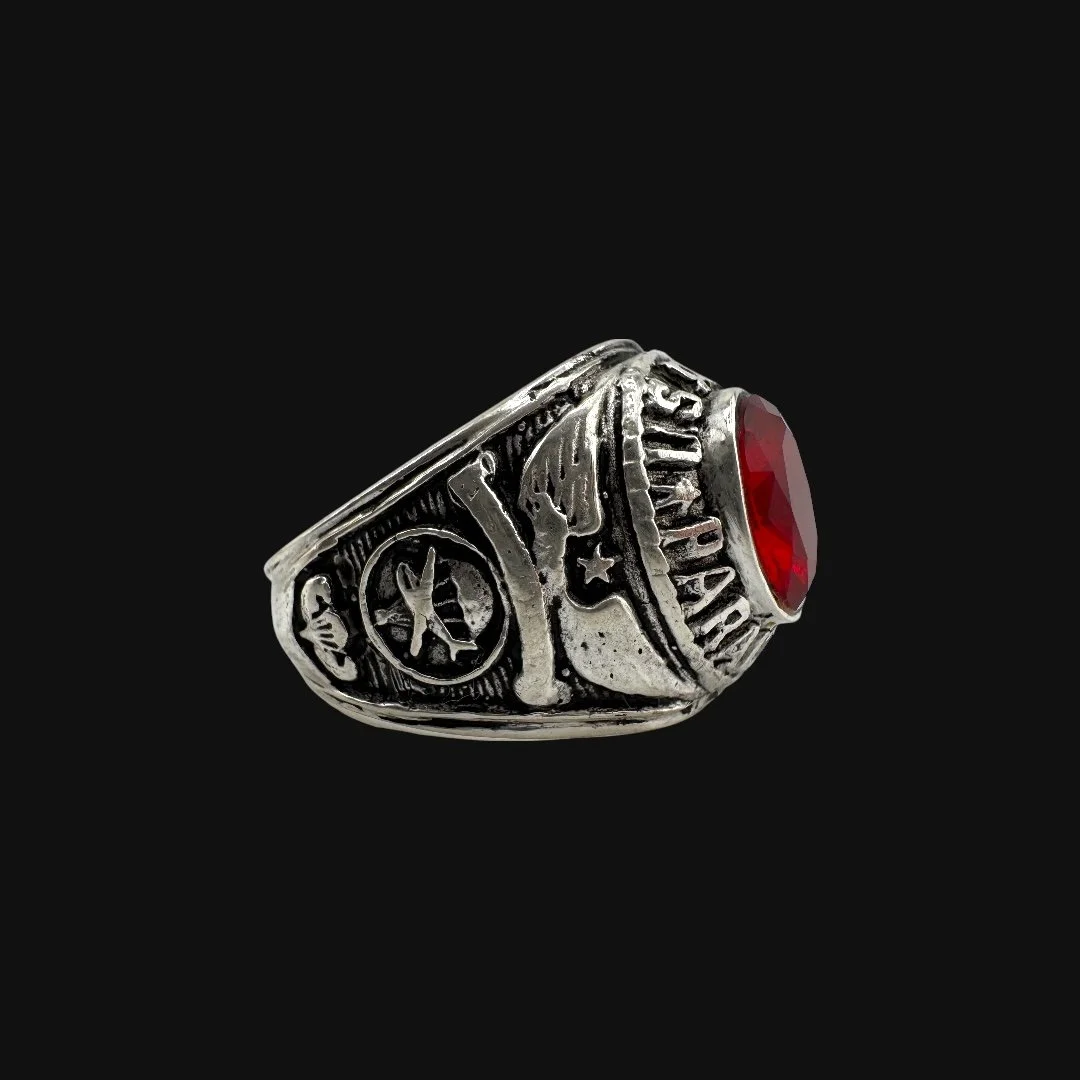 Image 5 of 14
Image 5 of 14

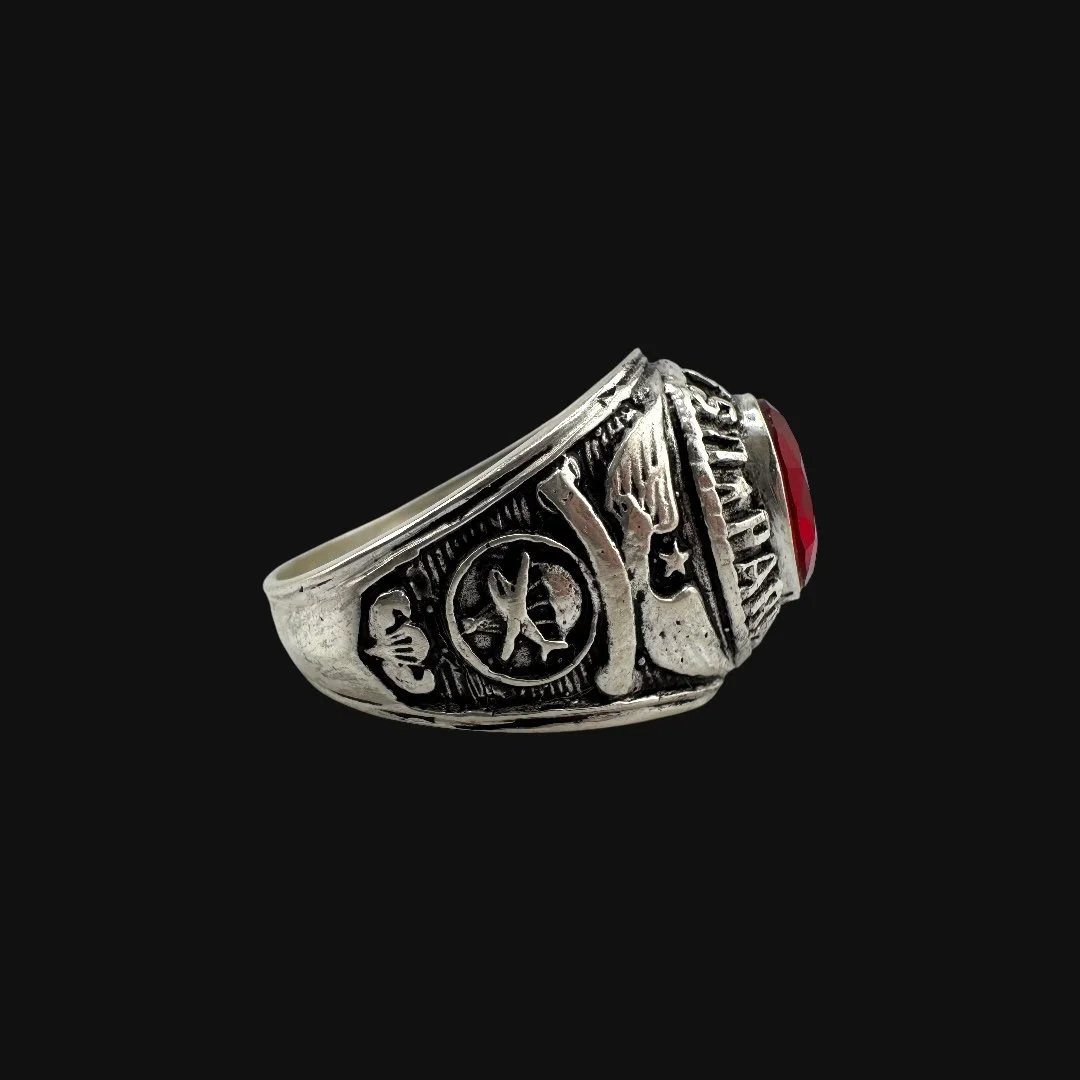 Image 6 of 14
Image 6 of 14

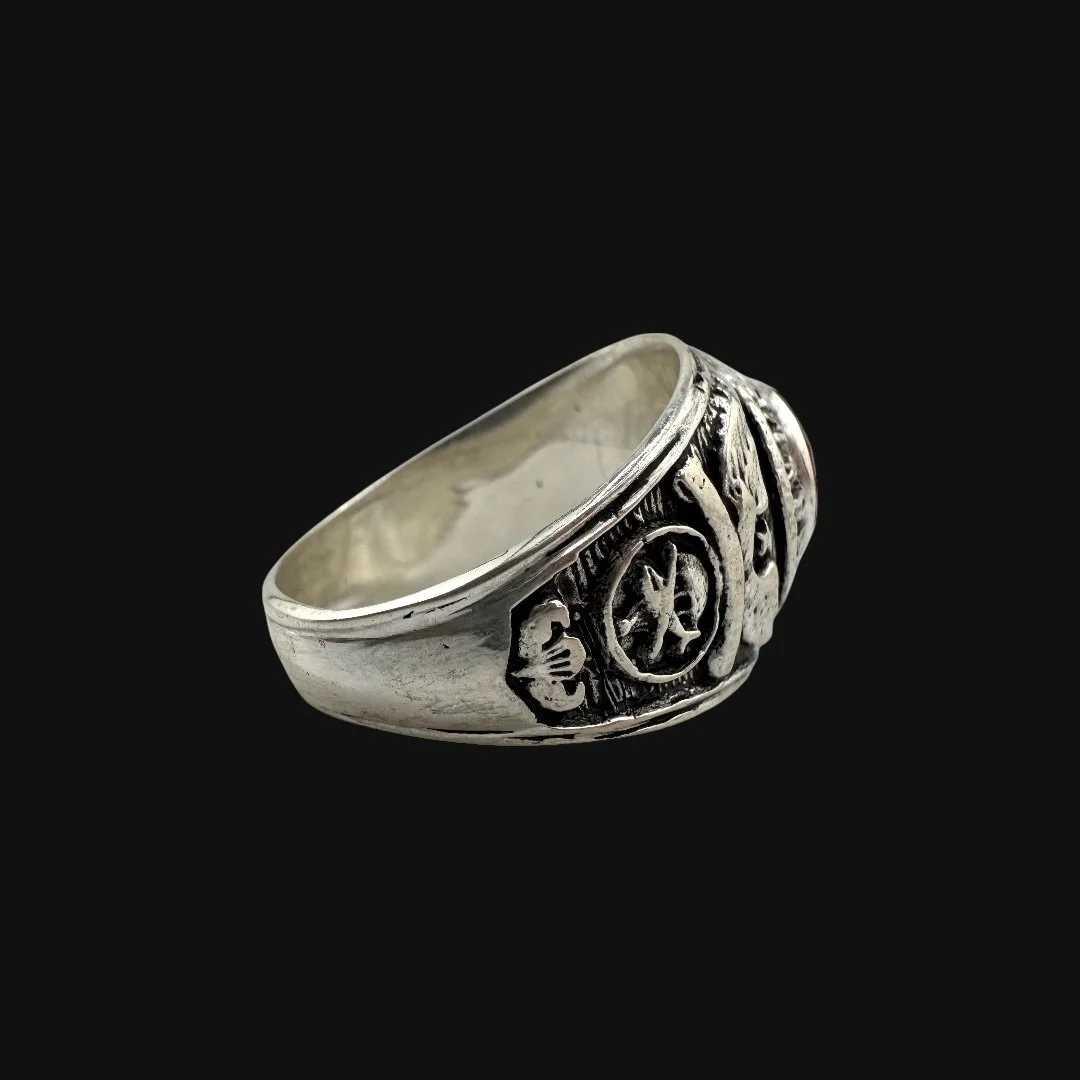 Image 7 of 14
Image 7 of 14

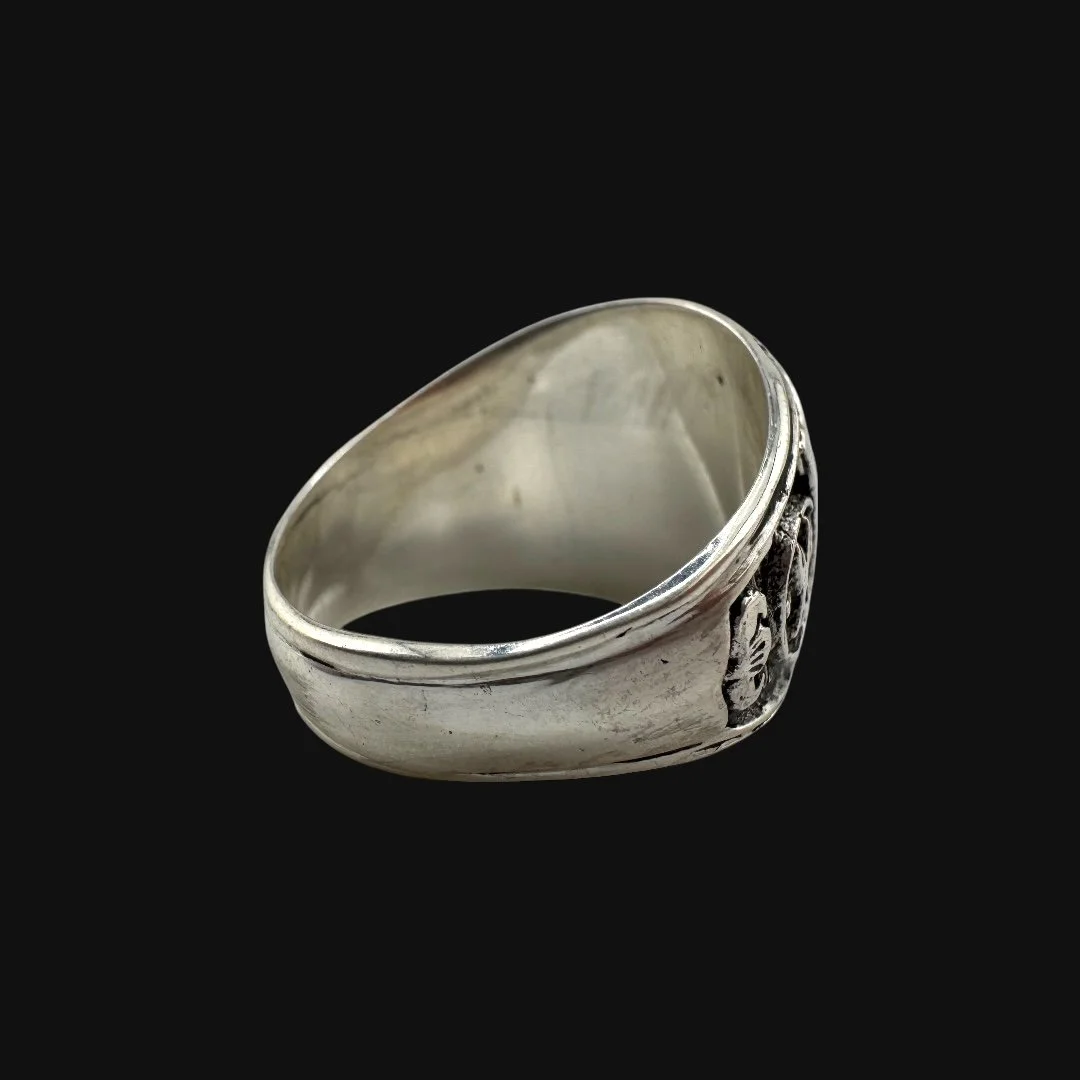 Image 8 of 14
Image 8 of 14

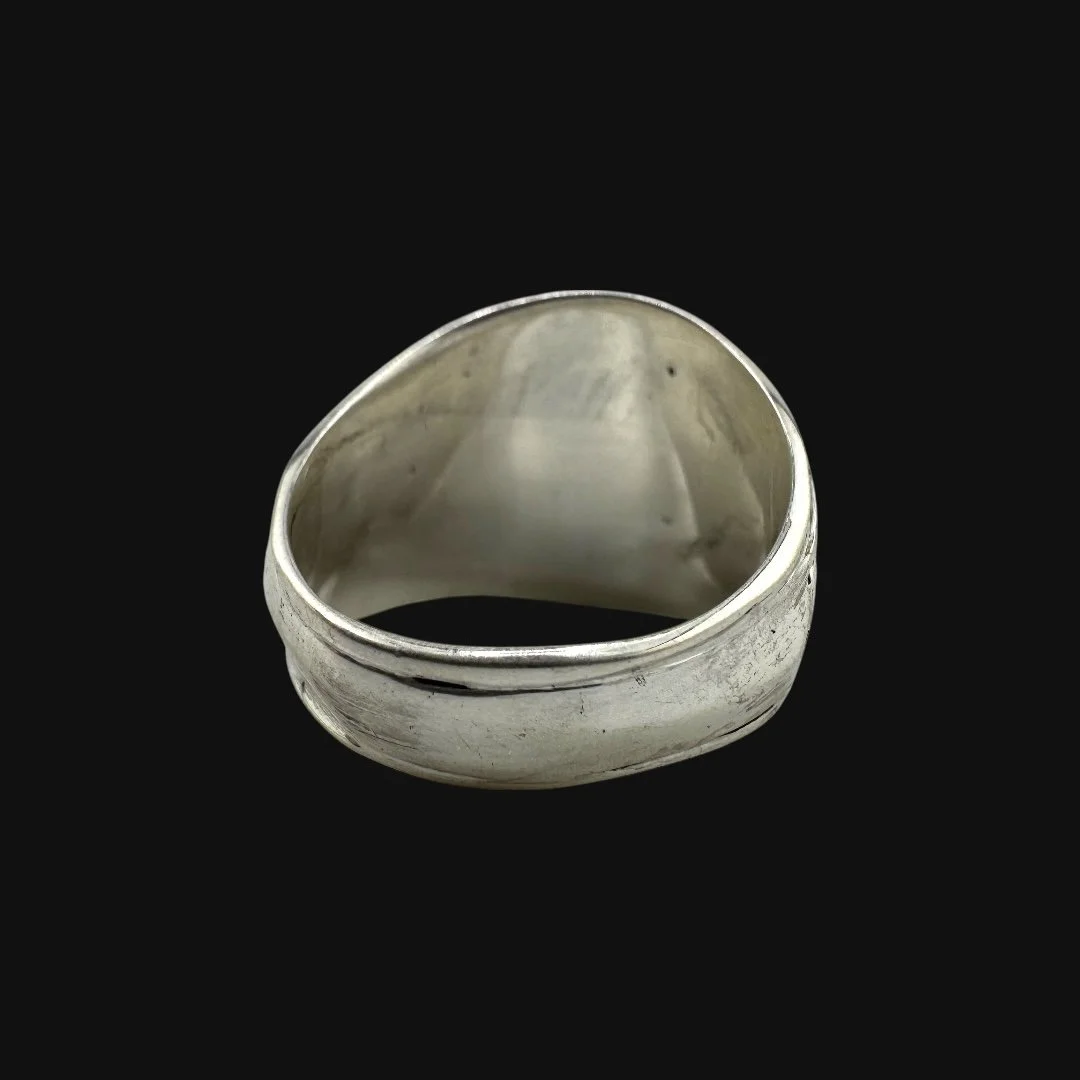 Image 9 of 14
Image 9 of 14

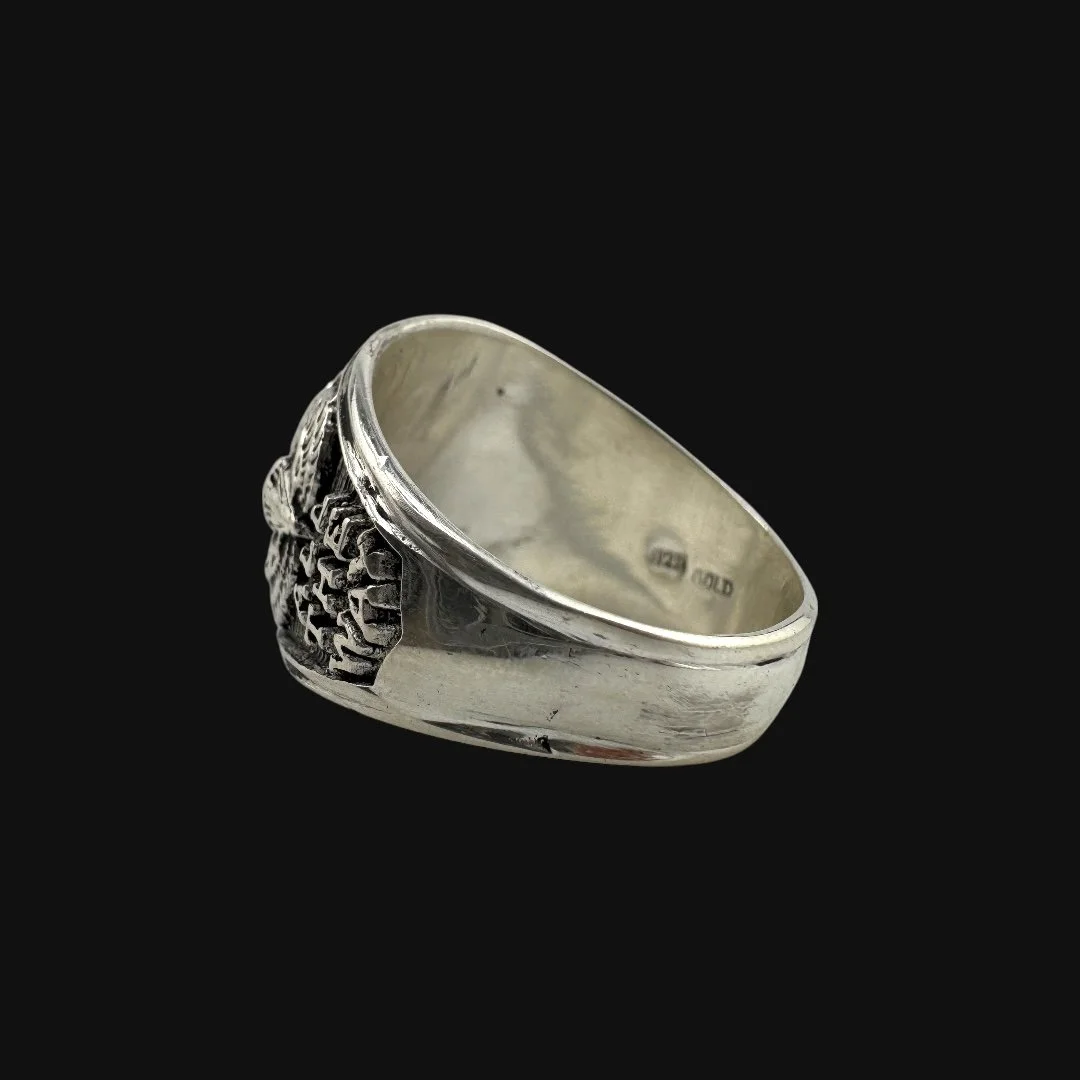 Image 10 of 14
Image 10 of 14

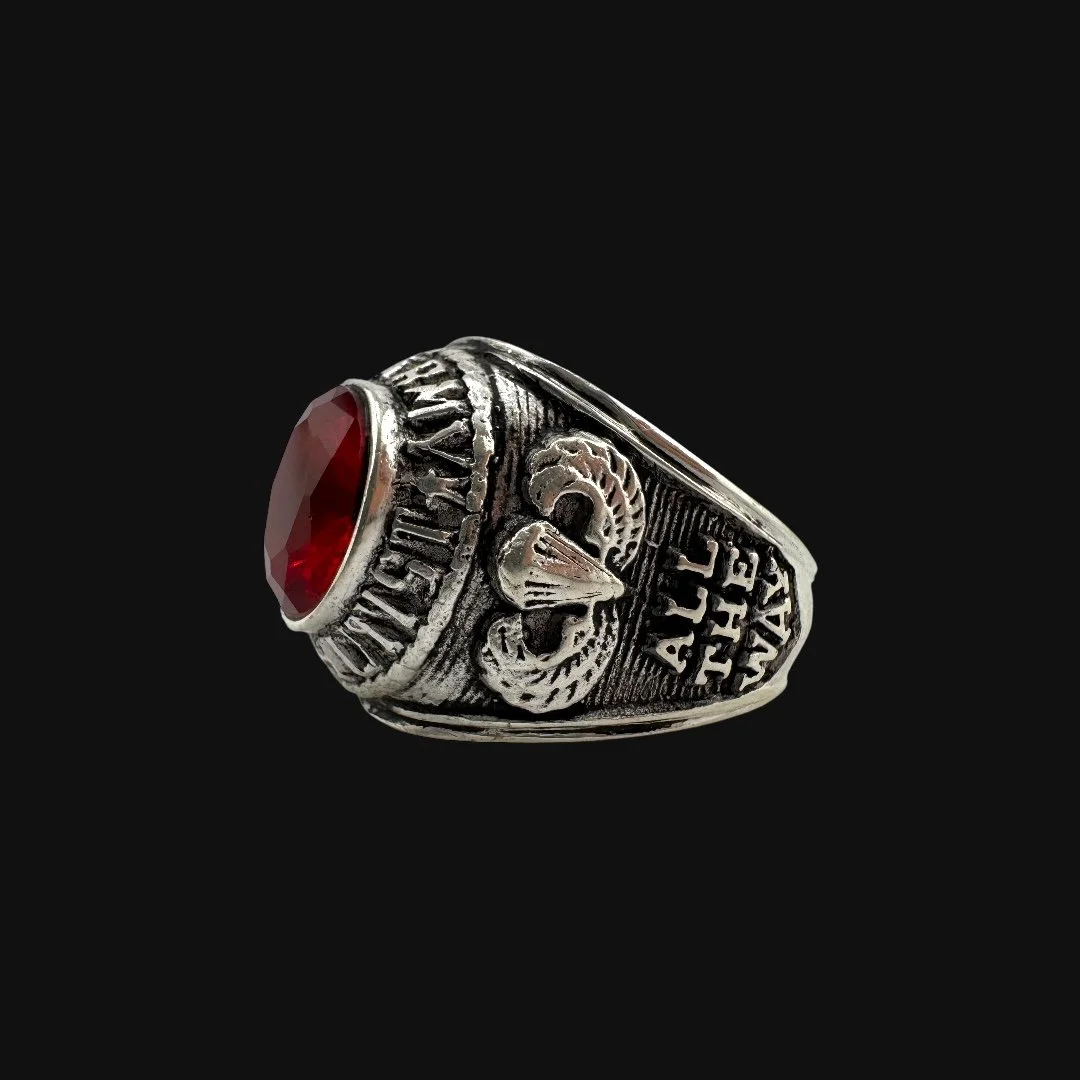 Image 11 of 14
Image 11 of 14

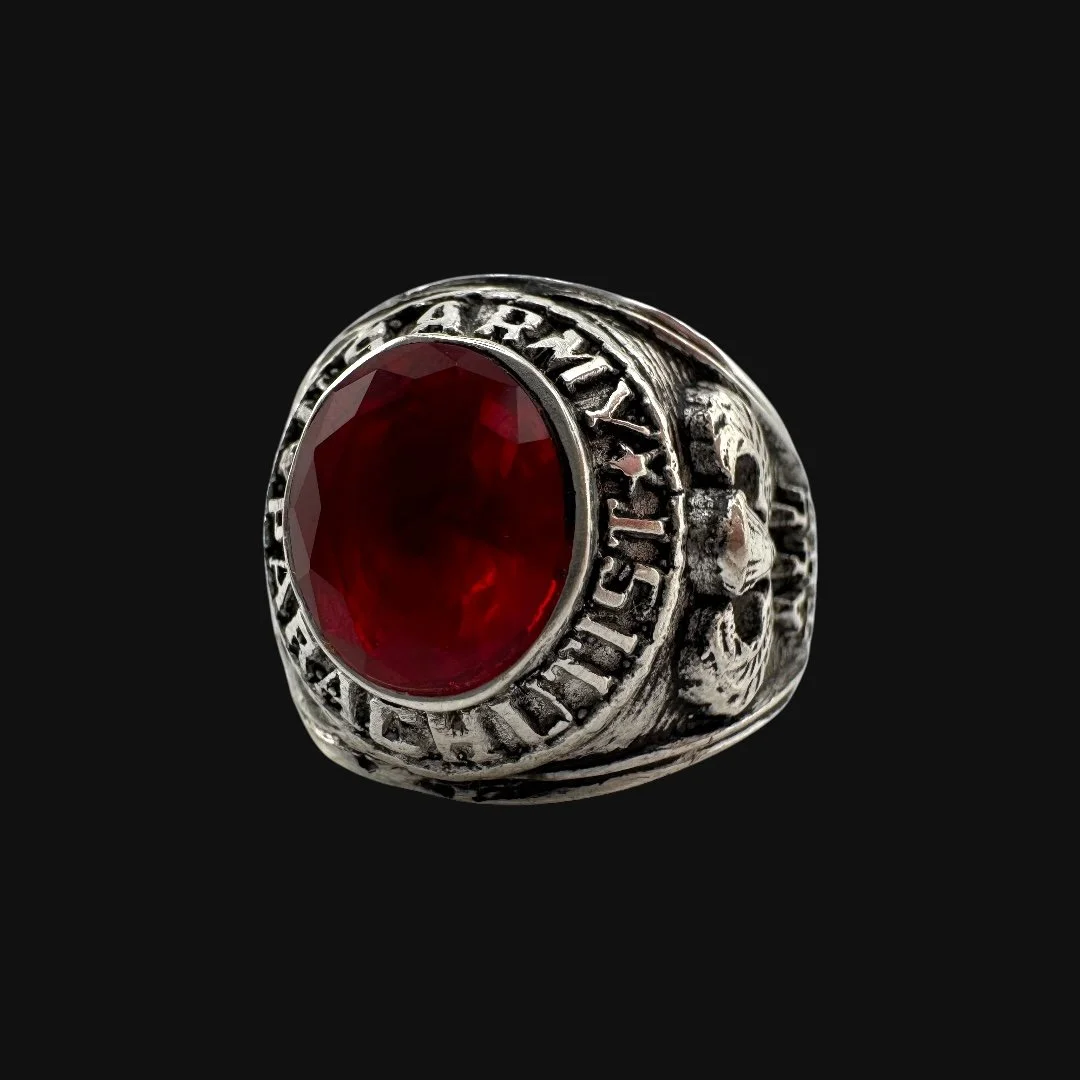 Image 12 of 14
Image 12 of 14

 Image 13 of 14
Image 13 of 14

 Image 14 of 14
Image 14 of 14















Original Vietnam War U.S. Airborne Parachutist “Jump Wings & ALL THE WAY” .925 Sterling Silver Red Gemstone Ring (Size 11.25)
Comes with a hand-signed C.O.A. and a full historical research write-up
From: Vietnam War
Branch: U.S. Army
Division: U.S. Airborne
Dated: 1960’s-1970’s
Ring Size: 11.25 (US)
Material: .925 Sterling Silver
Wearable History Collection:
This authentic Vietnam War–era ring, preserved in its original and unaltered condition, reflects the craftsmanship and resilience of a generation that served in one of America’s most challenging conflicts. Forged during the turbulent years of the 1960s and 1970s, it carries the weight of history while remaining fully suitable for modern wear today. As part of our exclusive Vietnam War “Wearable History Ring Collection,” it offers a rare chance to own and wear a genuine artifact of the era. Both a timeless accessory and a direct link to the men who endured the jungles, firebases, and patrols of Vietnam, this one-of-a-kind ring stands as a wearable tribute to their courage, sacrifice, and brotherhood.
Historical Significance to the U.S. Airborne in Vietnam:
The U.S. Army parachutist in Vietnam stood as a symbol of grit and resolve. Each man represented a tradition forged in World War II and carried into the jungles of Southeast Asia. Their identity was built on unshakable discipline, relentless training, and the ability to adapt in the most demanding conditions. For these soldiers, the jump wings and motto “All the Way” was not just a phrase. It was a creed that defined how they fought, how they endured, and how they upheld the legacy of the airborne.
The 82nd Airborne Division, known as the “All Americans,” entered Vietnam in 1965. Their arrival brought with it a reputation built on the drop zones of Normandy and the frozen forests of the Ardennes. In Vietnam they secured vital areas around Saigon, moved with speed to reinforce threatened regions, and launched aggressive missions against the Viet Cong and North Vietnamese. The paratroopers’ mobility and discipline proved essential in a conflict where the battlefield could shift from a rice paddy to a city street in hours.
Their defining test came during the Tet Offensive of 1968. As enemy forces struck across South Vietnam, the 82nd was called to restore balance in chaos. They fought with distinction, repelling determined assaults and reclaiming ground in brutal close-quarter battles. Their actions during Tet underscored why the Airborne remained one of America’s most trusted shock forces.
The 101st Airborne Division, the “Screaming Eagles,” also carved its legacy in Vietnam. Transitioning from parachute operations to airmobile assaults, the division adapted airborne traditions to new conditions. They launched major campaigns such as Operation Nevada Eagle, countering enemy strongholds in Thừa Thiên Province, and Operation Apache Snow, which included the fierce Battle of Hamburger Hill in 1969. The Screaming Eagles fought some of the war’s toughest fights, often in terrain where every ridgeline and jungle clearing had to be won at staggering cost.
Both divisions exemplified the enduring spirit of the airborne. Whether descending from the sky or moving swiftly by helicopter, their missions carried the same values that defined the parachutist ethos: courage, speed, and relentless determination. The jump wings each man wore were reminders of that oath. They spoke of comradeship, sacrifice, and the willingness to go “All the Way,” no matter the cost.
The Vietnam War added a distinct chapter to the history of the 82nd and 101st. Their paratroopers stood out not just for the campaigns they fought but for how they carried themselves under the strain of guerrilla warfare, shifting battle lines, and political uncertainty. They carried forward a legacy born in earlier wars and proved it still had relevance in a new kind of conflict.
To this day, the jump wings and the motto “All the Way” connect Vietnam’s airborne soldiers with those of every generation. They remind us that whether in the skies over Europe or the jungles of Vietnam, the spirit of the U.S. Army parachutist endures.
U.S. Parachutist in Vietnam
101st Airborne Division (“Screaming Eagles”)
Began as a parachute division, but transitioned into an airmobile/air assault role during Vietnam.
Still maintained its airborne heritage and identity, with many of its soldiers being parachute qualified.
Fought in major campaigns such as Operation Nevada Eagle, Operation Apache Snow (Hamburger Hill), and the Tet Offensive.
82nd Airborne Division (“All Americans”)
Deployed to Vietnam in 1965.
Provided security operations around Saigon, engaged in counterinsurgency missions, and fought during the Tet Offensive in 1968.
Though only part of the division deployed, it represented the airborne tradition directly in combat.
Airborne Brigades and Separate Units
173rd Airborne Brigade (“Sky Soldiers”)
The first major U.S. Army ground combat unit sent to Vietnam (1965).
Conducted combat parachute assault at Operation Junction City in 1967, the only large-scale U.S. combat jump of the war.
Took part in some of the toughest campaigns, including Dak To and defense of Bien Hoa.
Special Forces Groups (Airborne)
5th Special Forces Group (Airborne) was heavily involved in Vietnam.
Parachute-qualified, they specialized in unconventional warfare, training and fighting alongside Montagnard tribes and South Vietnamese forces.
Conducted long-range reconnaissance, counterinsurgency, and direct action missions.
The Legacy Within This Ring:
This Vietnam War ring tells the story of the U.S. Army parachutist. These soldiers carried the proud legacy of America’s airborne forces into the jungles of Southeast Asia. Known for their discipline, adaptability, and courage, they faced some of the most unforgiving conditions of the war. A ring like this is a reminder of hardship endured, of sacrifice given, and of the relentless demands of airborne combat in a brutal and unyielding conflict.
At its center rests a vivid red gemstone, a color steeped in powerful meaning. Red has long symbolized valor, sacrifice, and the fire of determination. For a parachutist in Vietnam, the stone may have reflected the lifeblood of comrades, the fierce resolve to face overwhelming odds, and the raw courage demanded by every mission. In the chaos of battle, it stood as a symbol of strength, resilience, and the unbreakable brotherhood forged in combat.
Today, the ring endures as more than a piece of wartime history. It stands as a preserved relic of service, carrying with it the story of the American parachutist and the enduring legacy of airborne soldiers in Vietnam. The red gemstone at its center ensures it remains not only a reminder of struggle, but also a lasting tribute to bravery, sacrifice, and the unwavering spirit of those who went “All the Way.”
Comes with a hand-signed C.O.A. and a full historical research write-up
From: Vietnam War
Branch: U.S. Army
Division: U.S. Airborne
Dated: 1960’s-1970’s
Ring Size: 11.25 (US)
Material: .925 Sterling Silver
Wearable History Collection:
This authentic Vietnam War–era ring, preserved in its original and unaltered condition, reflects the craftsmanship and resilience of a generation that served in one of America’s most challenging conflicts. Forged during the turbulent years of the 1960s and 1970s, it carries the weight of history while remaining fully suitable for modern wear today. As part of our exclusive Vietnam War “Wearable History Ring Collection,” it offers a rare chance to own and wear a genuine artifact of the era. Both a timeless accessory and a direct link to the men who endured the jungles, firebases, and patrols of Vietnam, this one-of-a-kind ring stands as a wearable tribute to their courage, sacrifice, and brotherhood.
Historical Significance to the U.S. Airborne in Vietnam:
The U.S. Army parachutist in Vietnam stood as a symbol of grit and resolve. Each man represented a tradition forged in World War II and carried into the jungles of Southeast Asia. Their identity was built on unshakable discipline, relentless training, and the ability to adapt in the most demanding conditions. For these soldiers, the jump wings and motto “All the Way” was not just a phrase. It was a creed that defined how they fought, how they endured, and how they upheld the legacy of the airborne.
The 82nd Airborne Division, known as the “All Americans,” entered Vietnam in 1965. Their arrival brought with it a reputation built on the drop zones of Normandy and the frozen forests of the Ardennes. In Vietnam they secured vital areas around Saigon, moved with speed to reinforce threatened regions, and launched aggressive missions against the Viet Cong and North Vietnamese. The paratroopers’ mobility and discipline proved essential in a conflict where the battlefield could shift from a rice paddy to a city street in hours.
Their defining test came during the Tet Offensive of 1968. As enemy forces struck across South Vietnam, the 82nd was called to restore balance in chaos. They fought with distinction, repelling determined assaults and reclaiming ground in brutal close-quarter battles. Their actions during Tet underscored why the Airborne remained one of America’s most trusted shock forces.
The 101st Airborne Division, the “Screaming Eagles,” also carved its legacy in Vietnam. Transitioning from parachute operations to airmobile assaults, the division adapted airborne traditions to new conditions. They launched major campaigns such as Operation Nevada Eagle, countering enemy strongholds in Thừa Thiên Province, and Operation Apache Snow, which included the fierce Battle of Hamburger Hill in 1969. The Screaming Eagles fought some of the war’s toughest fights, often in terrain where every ridgeline and jungle clearing had to be won at staggering cost.
Both divisions exemplified the enduring spirit of the airborne. Whether descending from the sky or moving swiftly by helicopter, their missions carried the same values that defined the parachutist ethos: courage, speed, and relentless determination. The jump wings each man wore were reminders of that oath. They spoke of comradeship, sacrifice, and the willingness to go “All the Way,” no matter the cost.
The Vietnam War added a distinct chapter to the history of the 82nd and 101st. Their paratroopers stood out not just for the campaigns they fought but for how they carried themselves under the strain of guerrilla warfare, shifting battle lines, and political uncertainty. They carried forward a legacy born in earlier wars and proved it still had relevance in a new kind of conflict.
To this day, the jump wings and the motto “All the Way” connect Vietnam’s airborne soldiers with those of every generation. They remind us that whether in the skies over Europe or the jungles of Vietnam, the spirit of the U.S. Army parachutist endures.
U.S. Parachutist in Vietnam
101st Airborne Division (“Screaming Eagles”)
Began as a parachute division, but transitioned into an airmobile/air assault role during Vietnam.
Still maintained its airborne heritage and identity, with many of its soldiers being parachute qualified.
Fought in major campaigns such as Operation Nevada Eagle, Operation Apache Snow (Hamburger Hill), and the Tet Offensive.
82nd Airborne Division (“All Americans”)
Deployed to Vietnam in 1965.
Provided security operations around Saigon, engaged in counterinsurgency missions, and fought during the Tet Offensive in 1968.
Though only part of the division deployed, it represented the airborne tradition directly in combat.
Airborne Brigades and Separate Units
173rd Airborne Brigade (“Sky Soldiers”)
The first major U.S. Army ground combat unit sent to Vietnam (1965).
Conducted combat parachute assault at Operation Junction City in 1967, the only large-scale U.S. combat jump of the war.
Took part in some of the toughest campaigns, including Dak To and defense of Bien Hoa.
Special Forces Groups (Airborne)
5th Special Forces Group (Airborne) was heavily involved in Vietnam.
Parachute-qualified, they specialized in unconventional warfare, training and fighting alongside Montagnard tribes and South Vietnamese forces.
Conducted long-range reconnaissance, counterinsurgency, and direct action missions.
The Legacy Within This Ring:
This Vietnam War ring tells the story of the U.S. Army parachutist. These soldiers carried the proud legacy of America’s airborne forces into the jungles of Southeast Asia. Known for their discipline, adaptability, and courage, they faced some of the most unforgiving conditions of the war. A ring like this is a reminder of hardship endured, of sacrifice given, and of the relentless demands of airborne combat in a brutal and unyielding conflict.
At its center rests a vivid red gemstone, a color steeped in powerful meaning. Red has long symbolized valor, sacrifice, and the fire of determination. For a parachutist in Vietnam, the stone may have reflected the lifeblood of comrades, the fierce resolve to face overwhelming odds, and the raw courage demanded by every mission. In the chaos of battle, it stood as a symbol of strength, resilience, and the unbreakable brotherhood forged in combat.
Today, the ring endures as more than a piece of wartime history. It stands as a preserved relic of service, carrying with it the story of the American parachutist and the enduring legacy of airborne soldiers in Vietnam. The red gemstone at its center ensures it remains not only a reminder of struggle, but also a lasting tribute to bravery, sacrifice, and the unwavering spirit of those who went “All the Way.”
